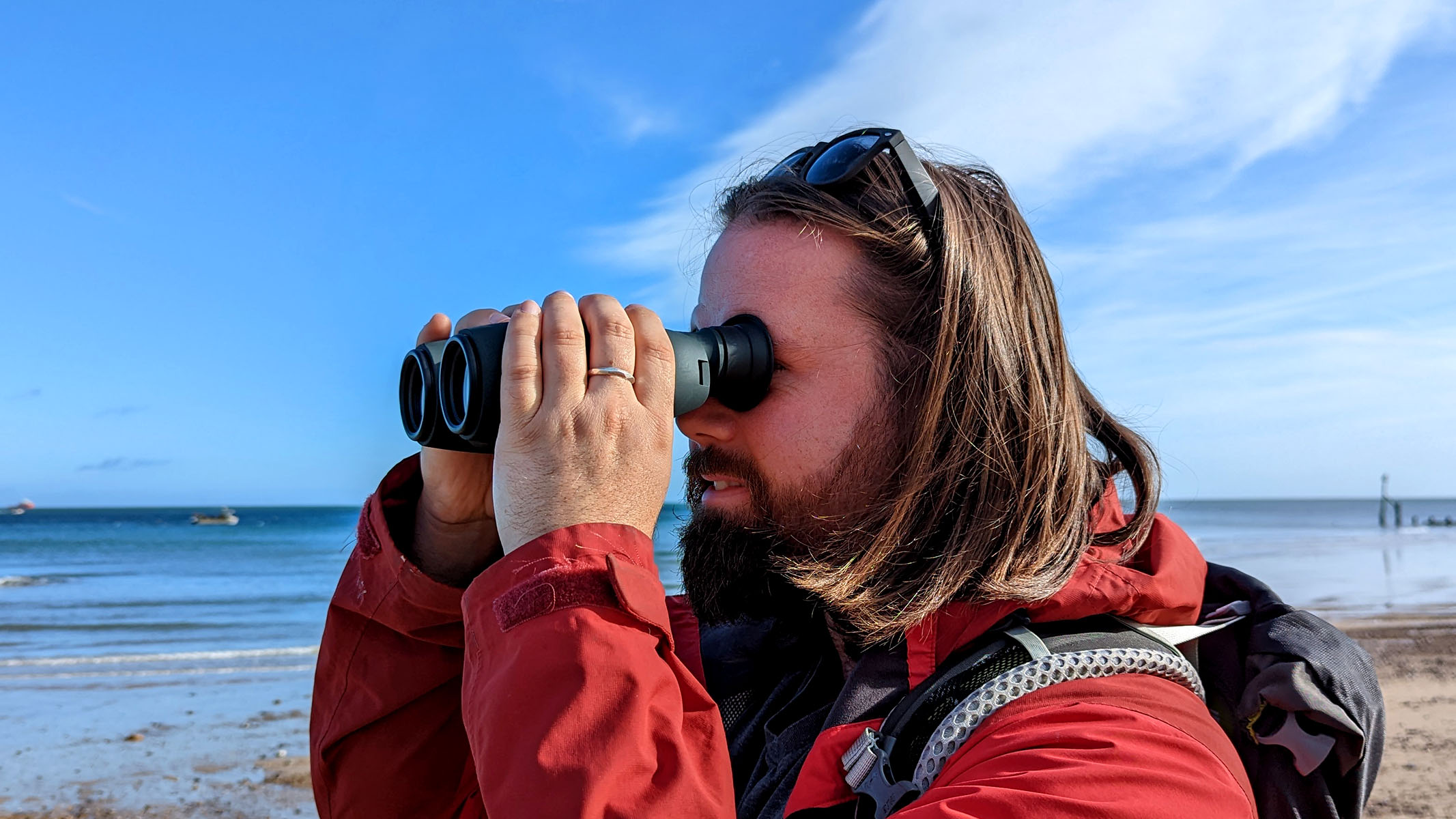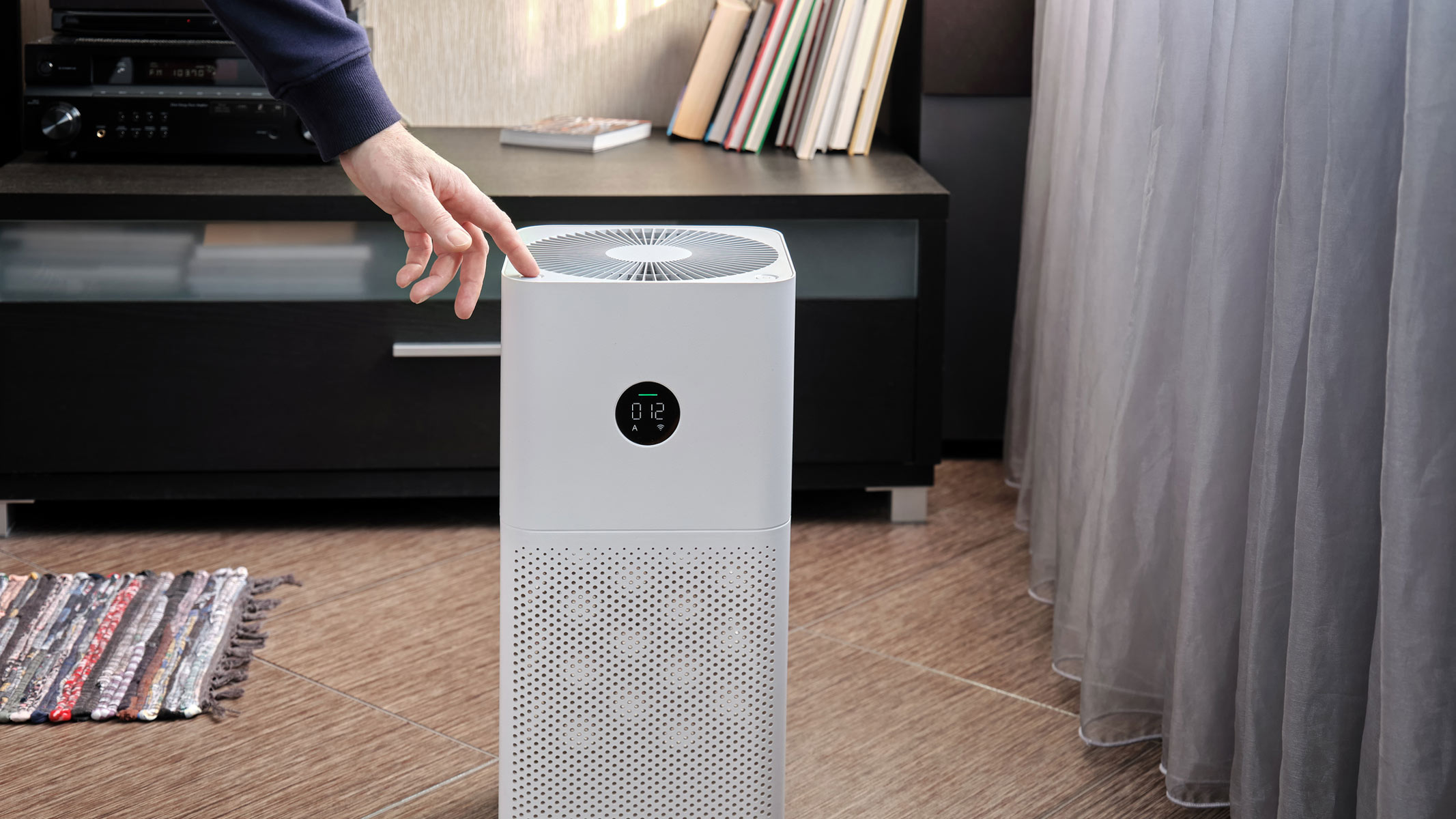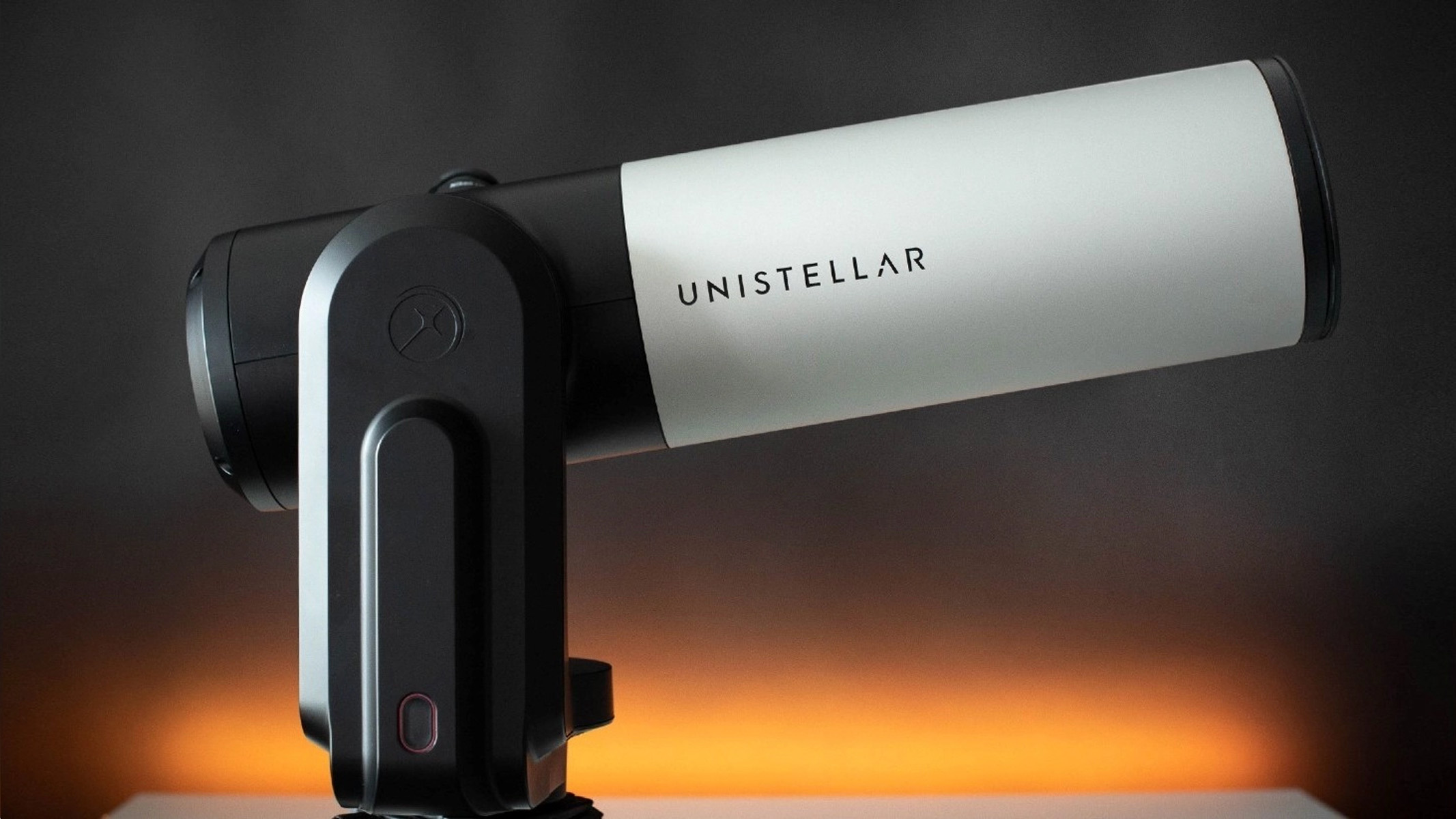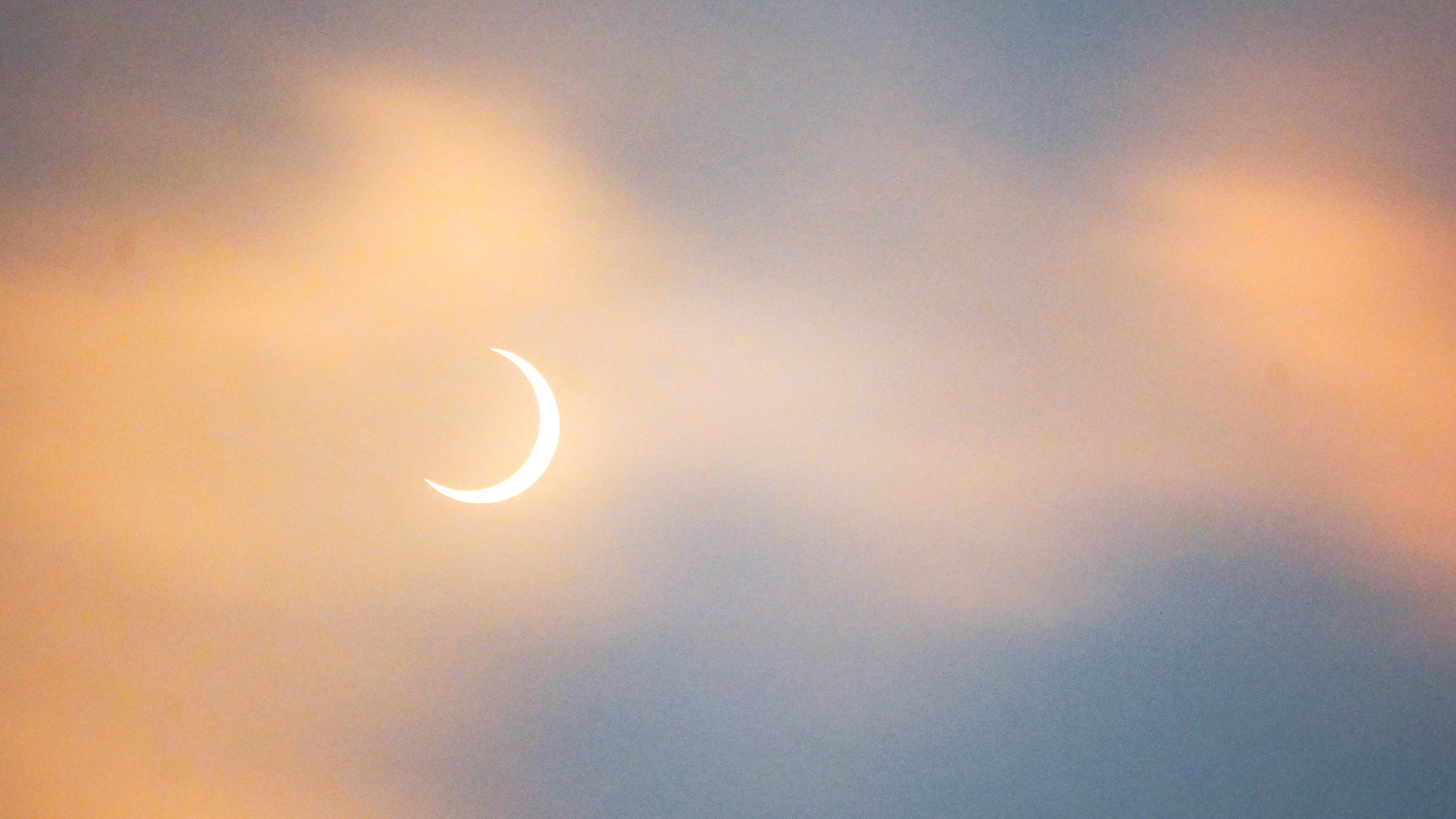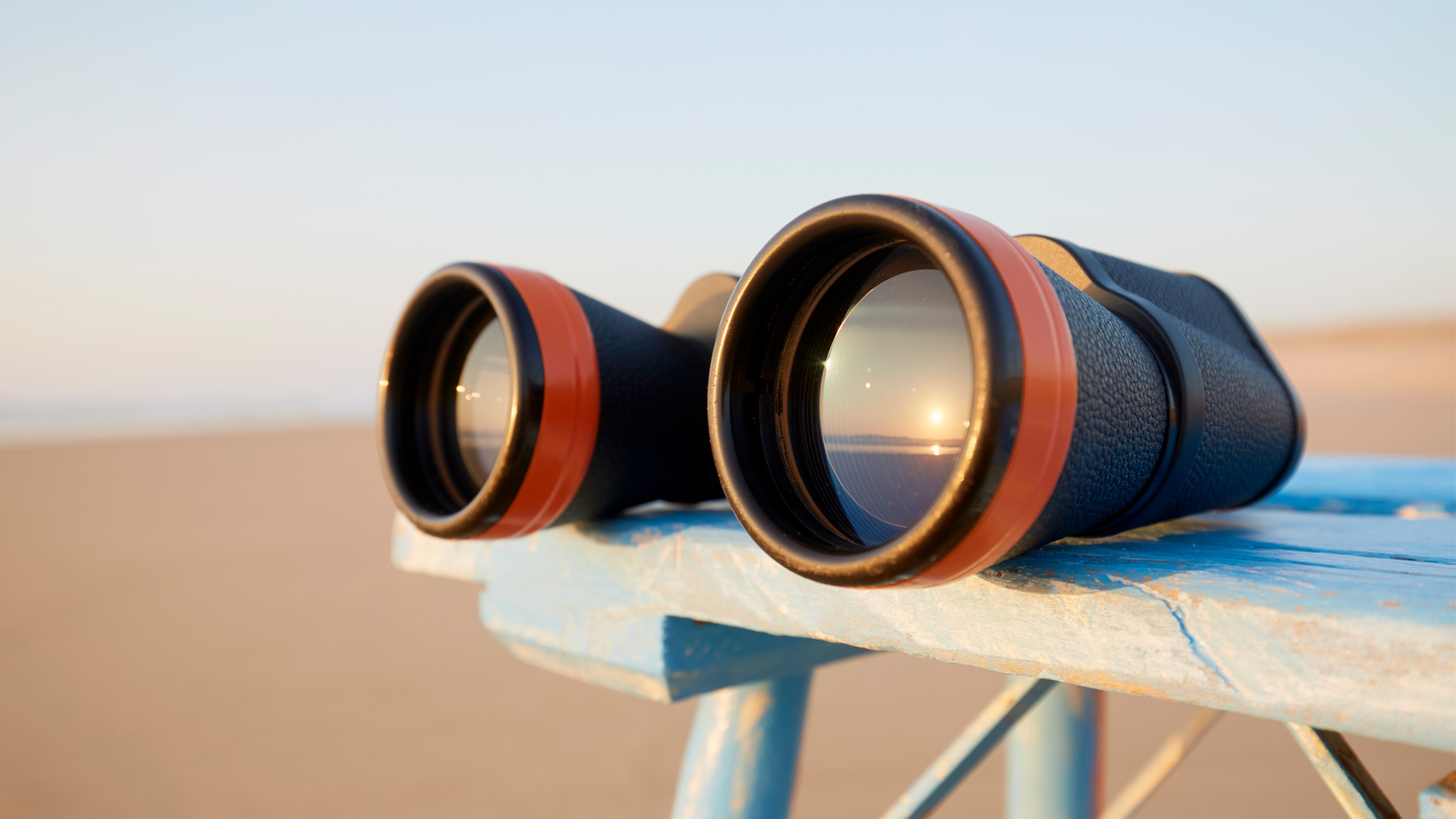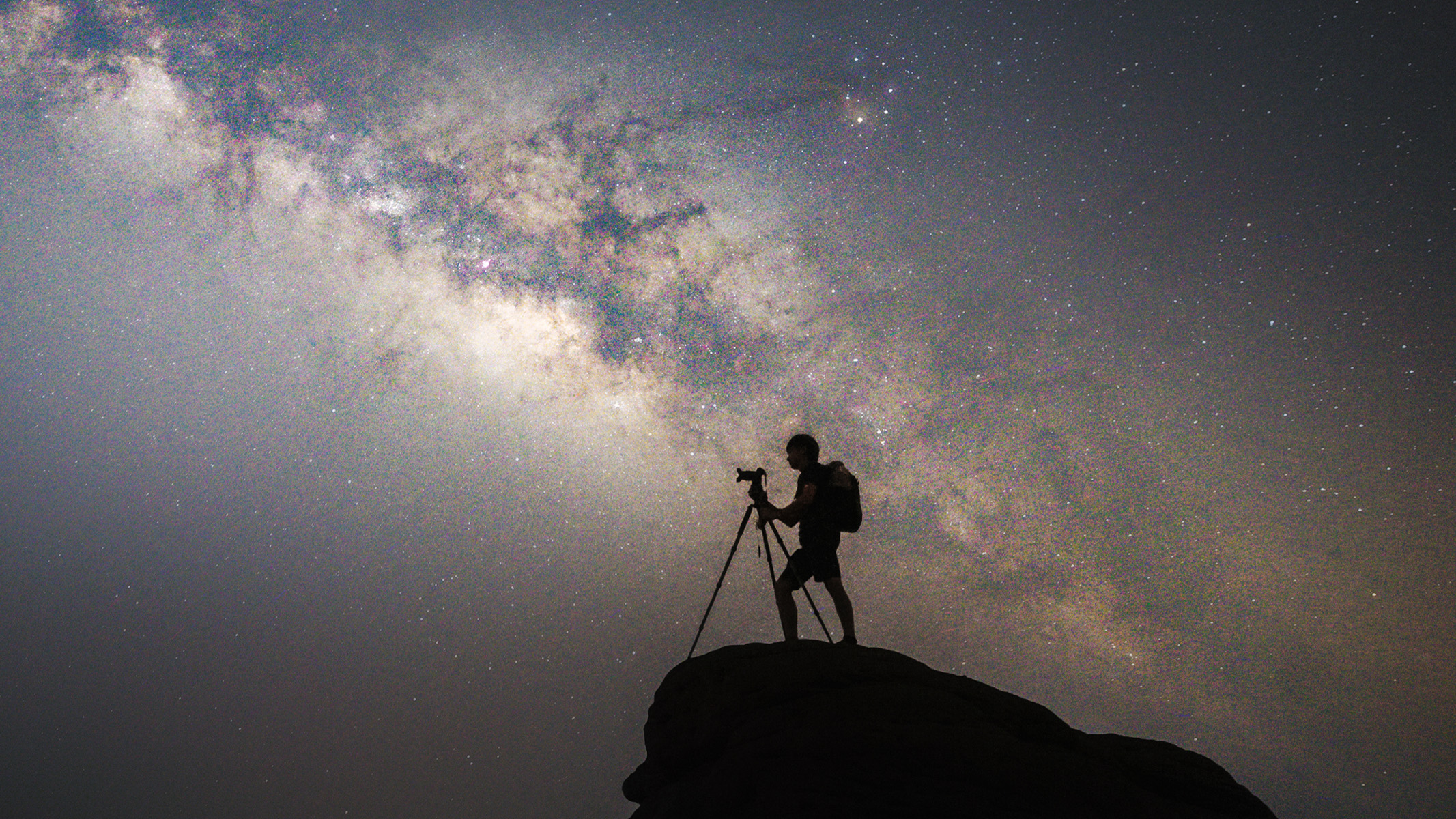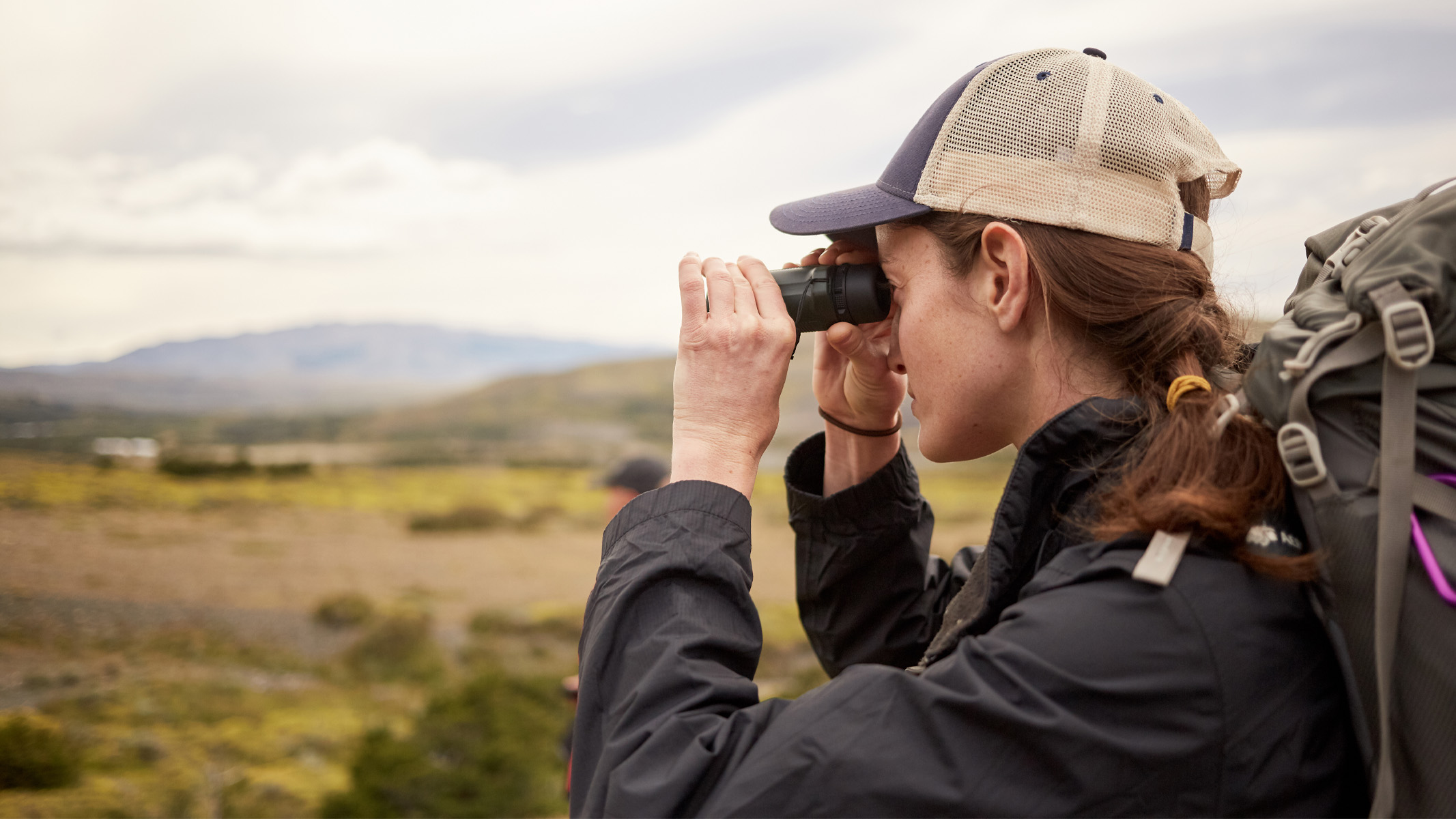Best binoculars for stargazing 2025: Take a walk through space
View the cosmos in the palm of your hand with the best binoculars for stargazing — see the stars, planets and deep sky objects.
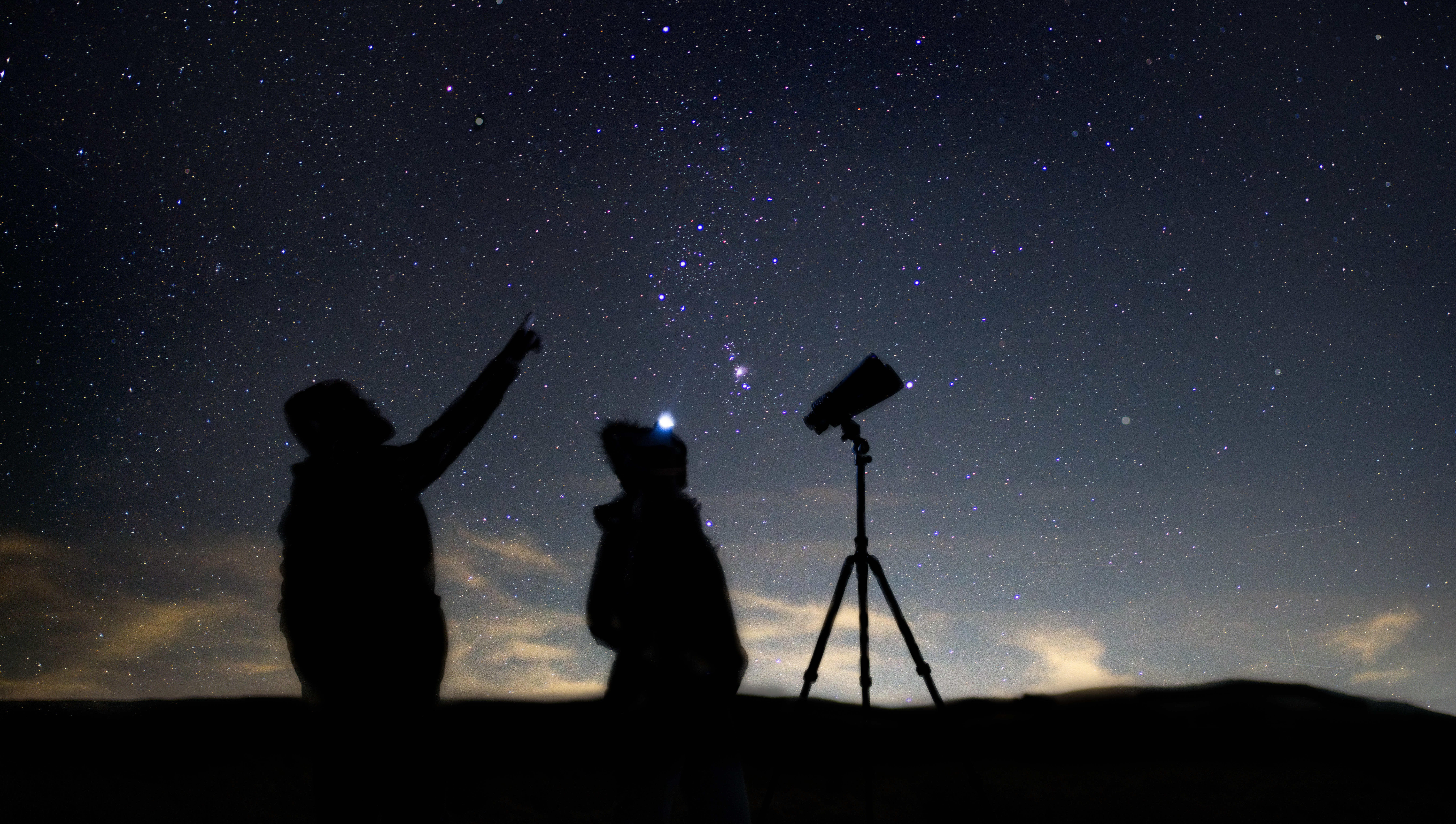
Binoculars are a great way to get into stargazing as they offer beautifully crisp night sky views in the palm of your hand. They are a fantastic lightweight alternative to the best telescopes and are ideal for viewing the stars, planets and even some deep-sky objects.
When you're deciding which pair of stargazing binoculars to buy, models with objective lenses of at least 40-50mm will gather enough light, which in turn improves the visibility of stars, planets and some deep-sky objects. For handheld stargazing, a magnification between 7x and 10x will give beautiful wide views, but anything more powerful (10x and above) will require the use of a sturdy tripod to eliminate any wobbles.
In this guide, we’ve curated the best stargazing binoculars for beginners and seasoned astronomers alike, and there are plenty of celestial wonders to see in April. Mercury is at its greatest elongation on the 21st, while you might get a good glimpse of the Lyrid meteor shower on the night of April 22-23, among many other fascinating night sky targets.
The quick list
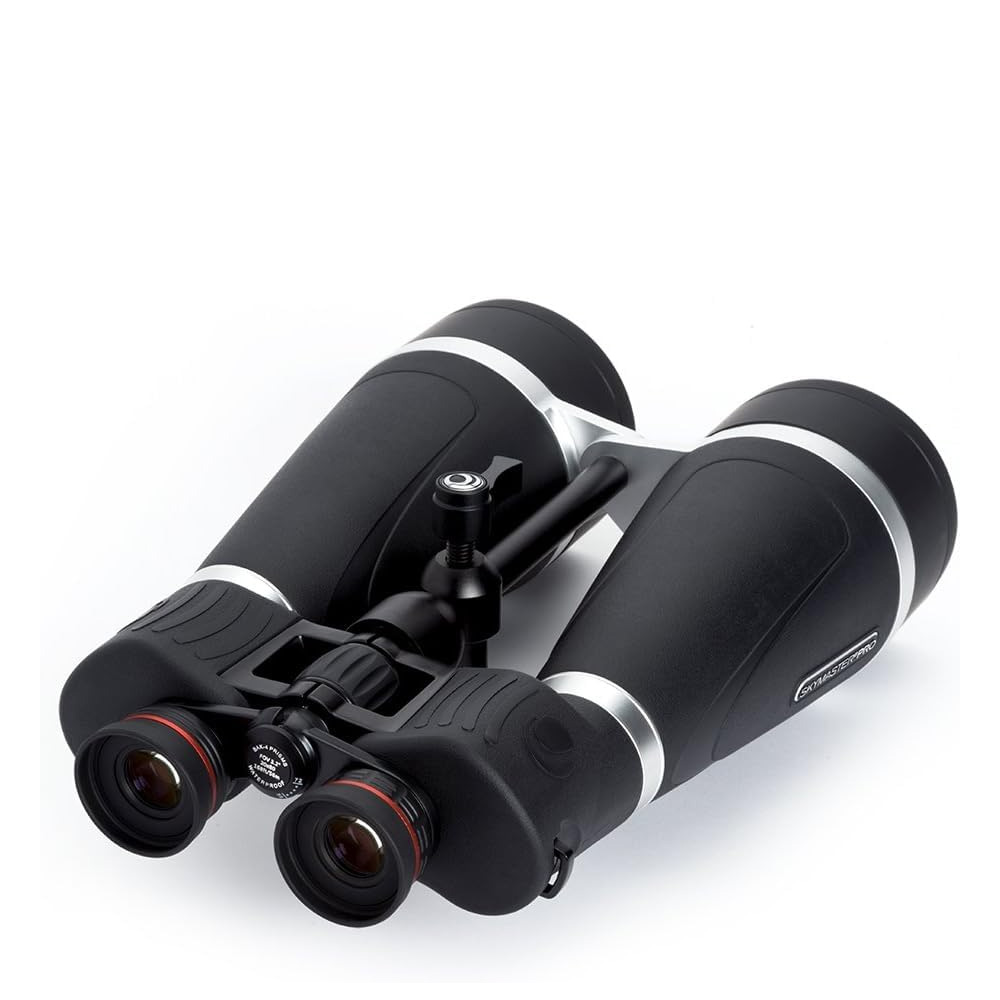
Best overall
An excellent pair of high magnification binoculars suited to astronomy and low light for fantastic views of the night sky. It's hard to beat their clarity and reach for this price.

Best generalist
Premium in almost every respect, if you want a fantastic generalist pair of binoculars, look no further than the Nikon Monarch HG 10x42 binoculars. But exceptional optical quality like this comes at a price.

Best premium
Simply put, the Leica Noctivid 10x42s are some of the best binoculars we've ever tested, but also some of the most expensive. Their stylish design and impressive optical prowess make them hard to beat.
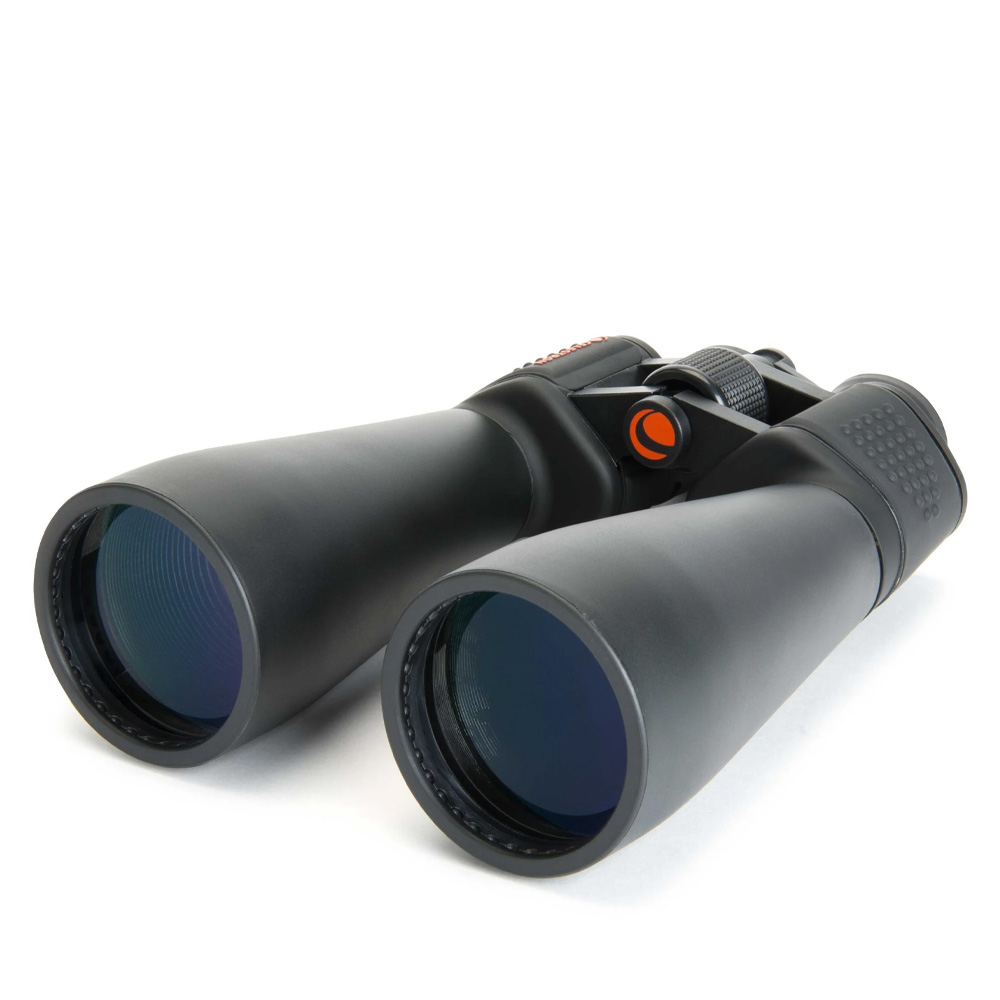
Best value for money
Their high magnification and large objective lenses drink in light for night sky observations and are fantastic value for the price.
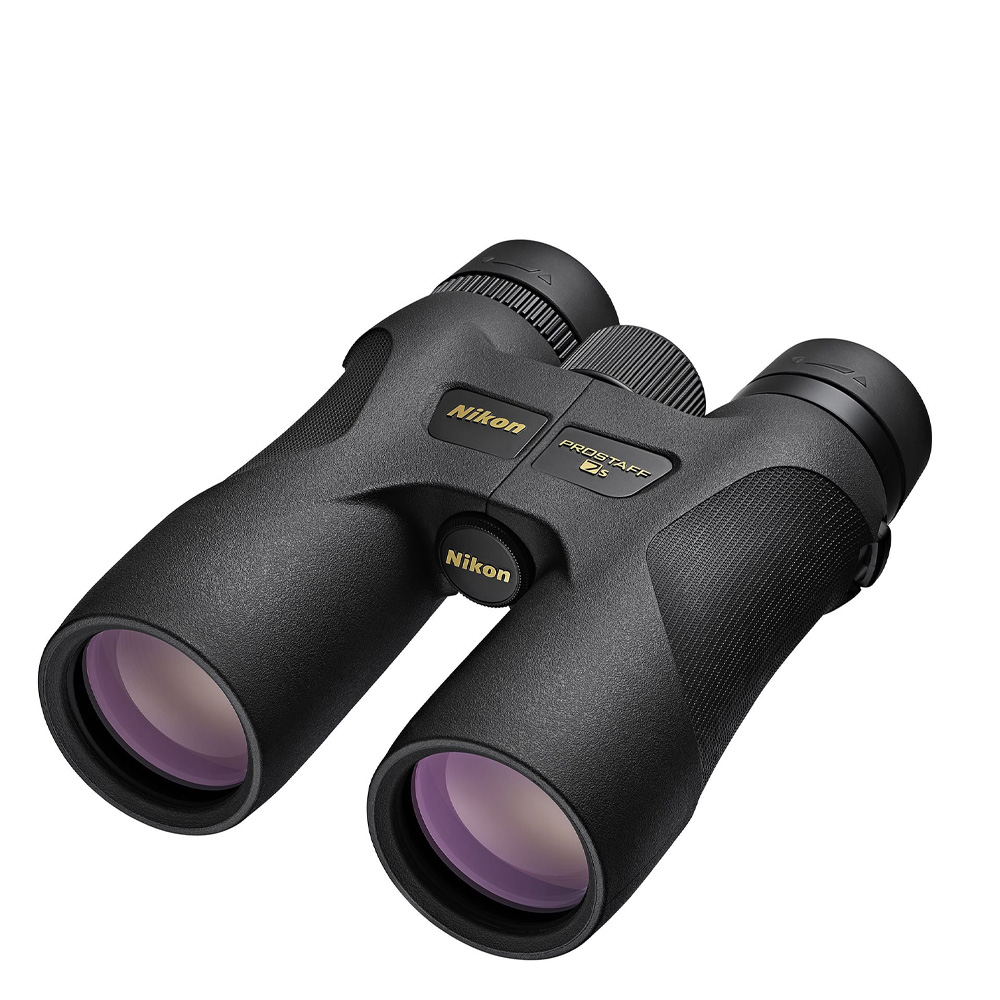
Best for handheld stargazing
For all-round performance for a variety of uses at an affordable price, these are hard to beat. Excellent optical performance, high-quality build and lightweight design.
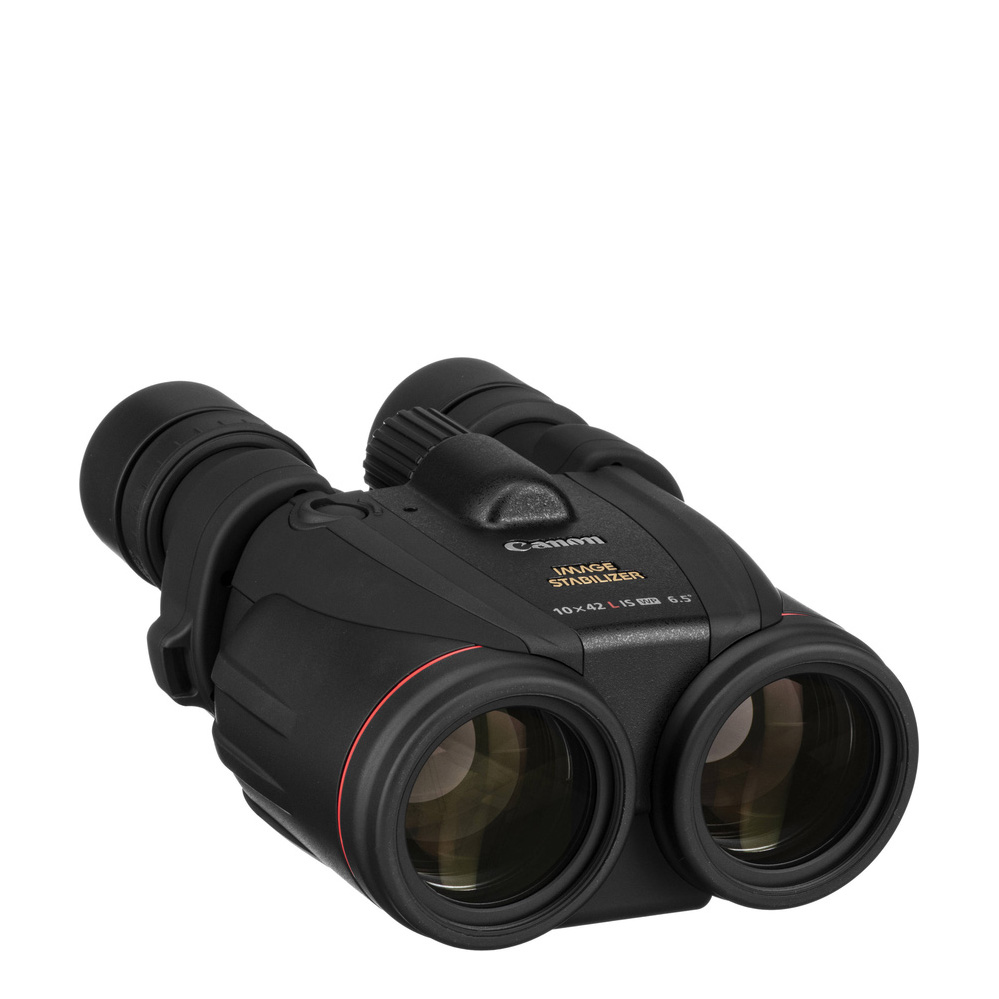
Best image-stabilized
Canon's first stabilized binoculars for shake-free observations of the night sky, but such high-powered tech comes at a premium price.
Best binoculars for stargazing we recommend in 2025
Why you can trust Live Science
Best binoculars for stargazing overall
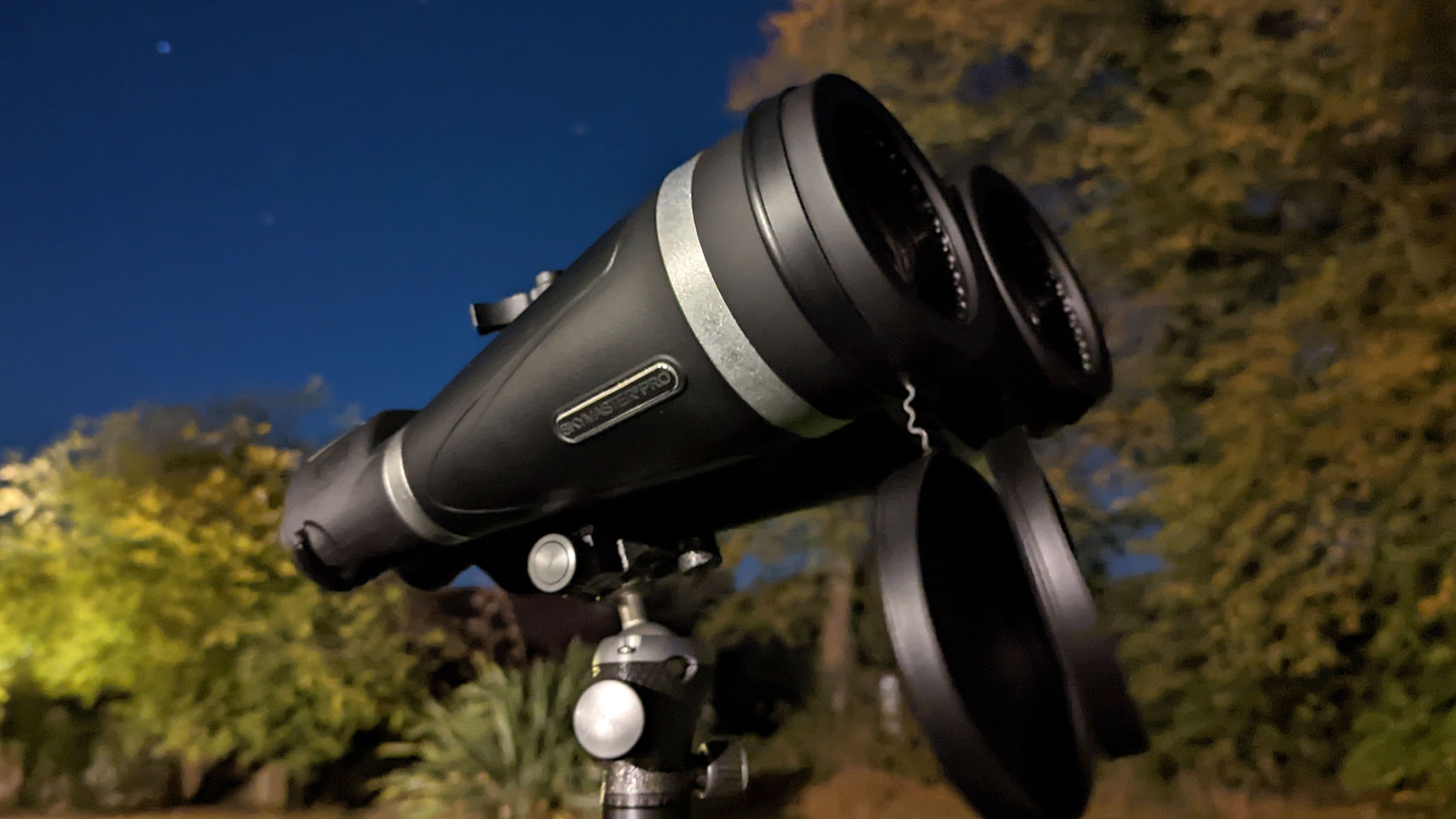
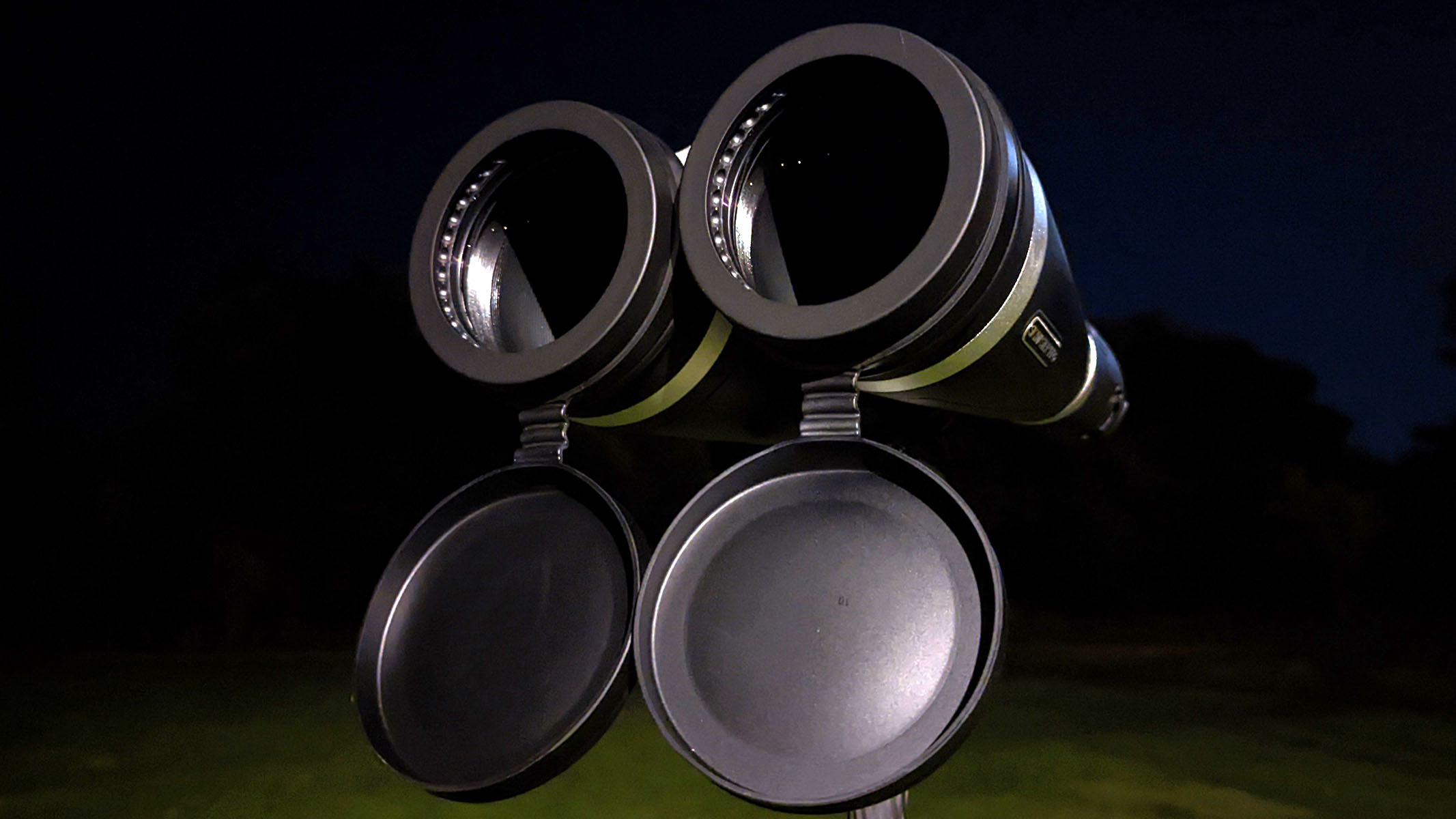
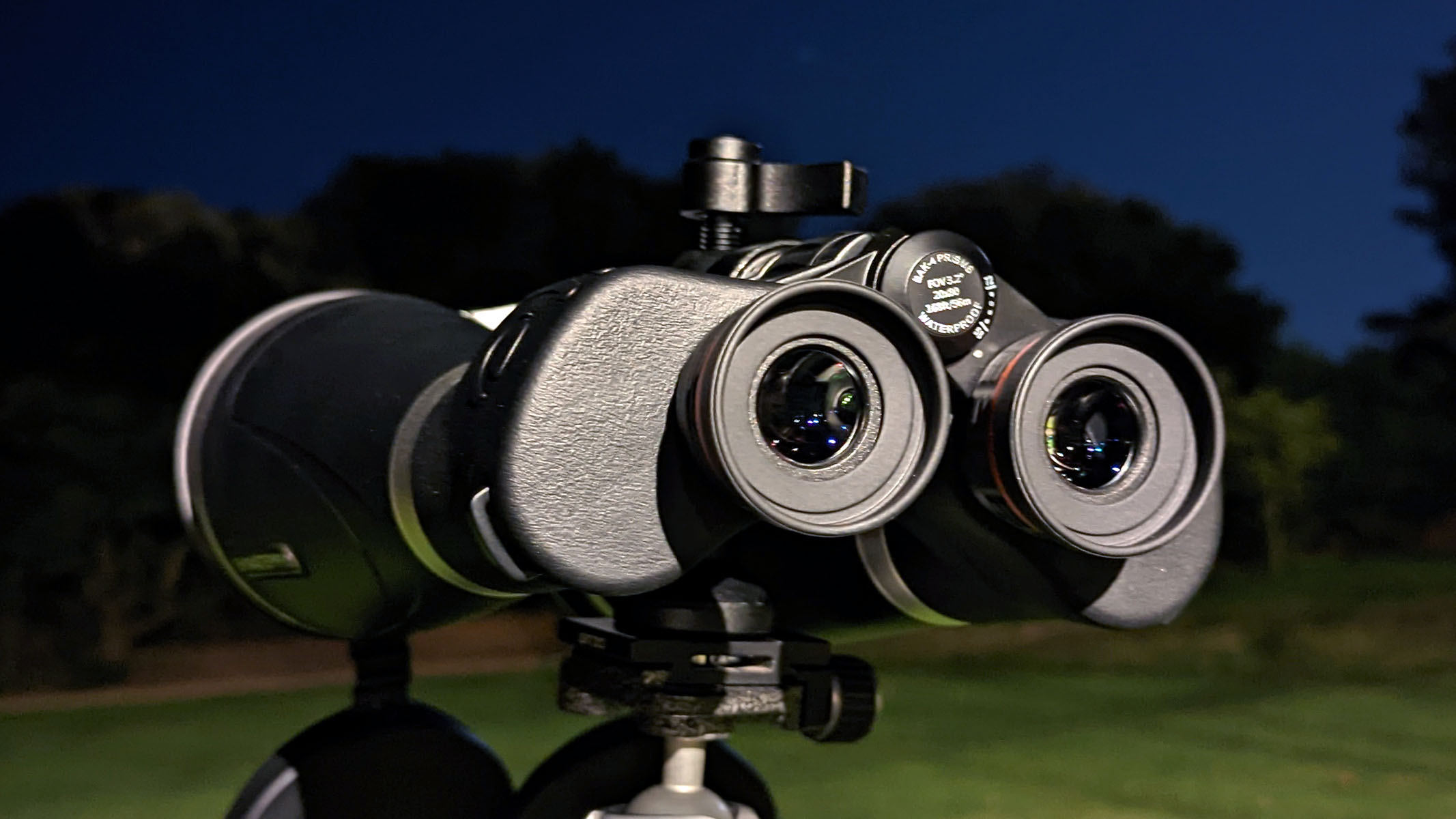
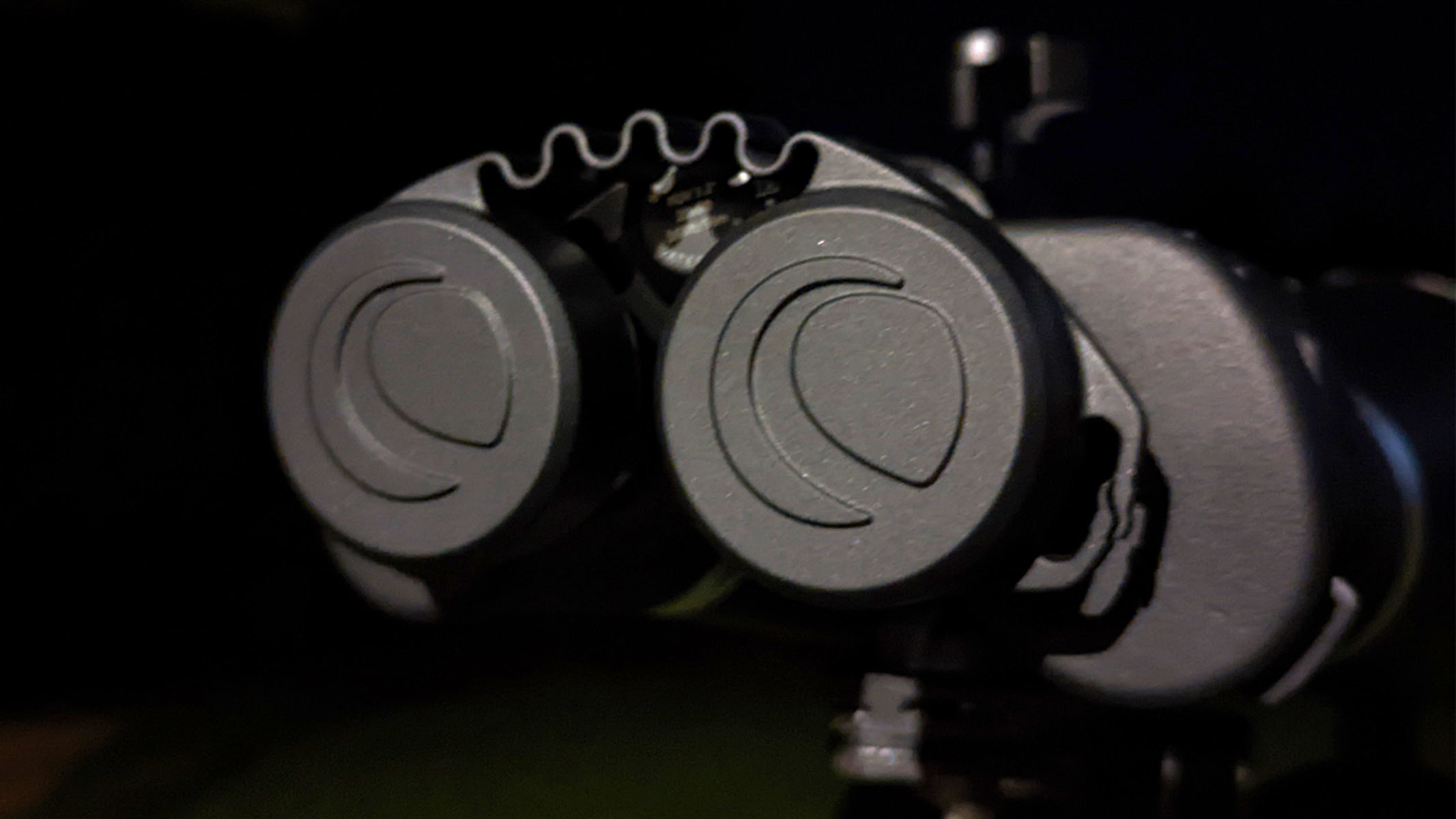

Specifications
Reasons to buy
Reasons to avoid
✅ You want high magnification: 20x magnification is fantastic for getting highly detailed views of the night sky— we could spot Jupiter's moons with them.
✅ You want to use them in all weathers: They are waterproof and fog proof, so will keep up with you during all outdoor pursuits.
❌ You don't want large binoculars: They weigh 5 lbs / 2.27kg and have a pretty hefty footprint. If you're looking for portable binoculars, we'd recommend the Nikon Prostaff P7 10x42.
❌ You want a pair for more generalist viewing: As dedicated astronomy binoculars, they aren't particularly well suited to general-use. We think the Celestron Nature DX 12x56 are better for general purpose.
🔎 Celestron SkyMaster Pro 20x80: An excellent pair of high magnification binoculars suited to astronomy and low light for fantastic views of the night sky. For the money it’s hard to beat their reach and clarity. ★★★★
Design: Stargazing binoculars don't come much more perfect than these. The Celestron SkyMaster Pro 20x80 binoculars have huge magnification and massive objective lenses to get you closer to dimmer objects than almost any other binocular in our guide — the only binoculars that have higher reach are the Celestron SkyMaster 25x100.
They have a built-in standard tripod mount which may be of use for long-term stargazing to accommodate their heavier weight and size — something we made good use of during our Celestron SkyMaster Pro 20x80 review. With 20x magnification and housing filled with dry nitrogen gas, they do not fog up in even the chilliest of foggy nights, damp conditions or moving between different temperature conditions — even if that is just your backpack to your favorite hilltop stargazing spot. They also have the ability to attach a red dot finder to bring objects into view quicker.
Performance: When it comes to views of the moon, in particular, they certainly have the 'wow' factor. Sharp views from edge to edge, and once focused, every crater and crevice along the lunar surface was sharp and detailed — we were astounded.
We could easily spot stars within constellations, search for galaxies like Messier 31 (the Andromeda galaxy) and were lucky enough to see Jupiter and four of its moons on a clear night: Europa, Io, Ganymede and Callisto. Although they one hundred percent did the job, we did find ourselves wishing they had more reach to get even further into the night sky to get a closer look at the objects we could only just make out.
Functionality: What sets these 'Pro' versions apart from their standard 20x80 counterparts is that they have Celestron’s proprietary XLT coating technology for clearer views of the cosmos, and the BaK-4 glass prisms give enhanced light transmission. We also found the focus wheel had sufficient grip and can be operated smoothly and precisely with plenty of room for fine-tuning adjustment where necessary.
For the price, you can't go wrong with the Celestron SkyMaster Pro 20x80. They're not suited for more general observation, so wildlife observers may want to check out another pair of the best binoculars that are more suitable for all-round use.
While other models in this guide may be better in certain areas, such as more magnification, better portability or featuring image stabilization, we named the Celestron SkyMaster Pro 20x80s best overall as they strike a perfect balance between impressive performance and quality optics at a reasonable price.
- Read our full Celestron SkyMaster Pro 20x80 review
Attributes | Notes |
|---|---|
Design | Heavy at 5 lbs / 2.27kg — second heaviest on this list. |
Performance | 20x magnification to view Jupiter's moons and the Andromeda galaxy. |
Functionality | Features Celestron’s proprietary XLT coating technology. |
Best generalist binoculars for stargazing
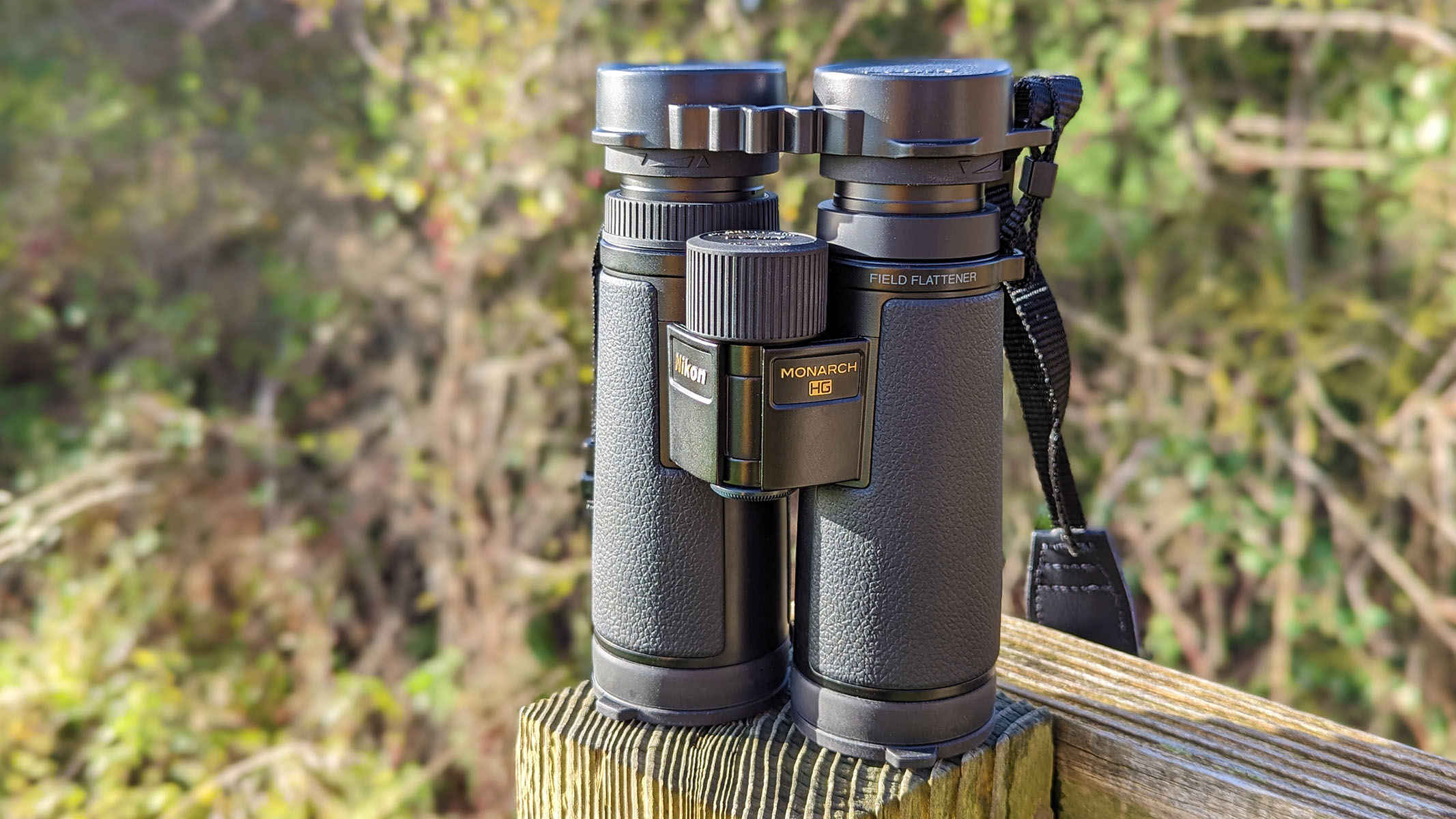
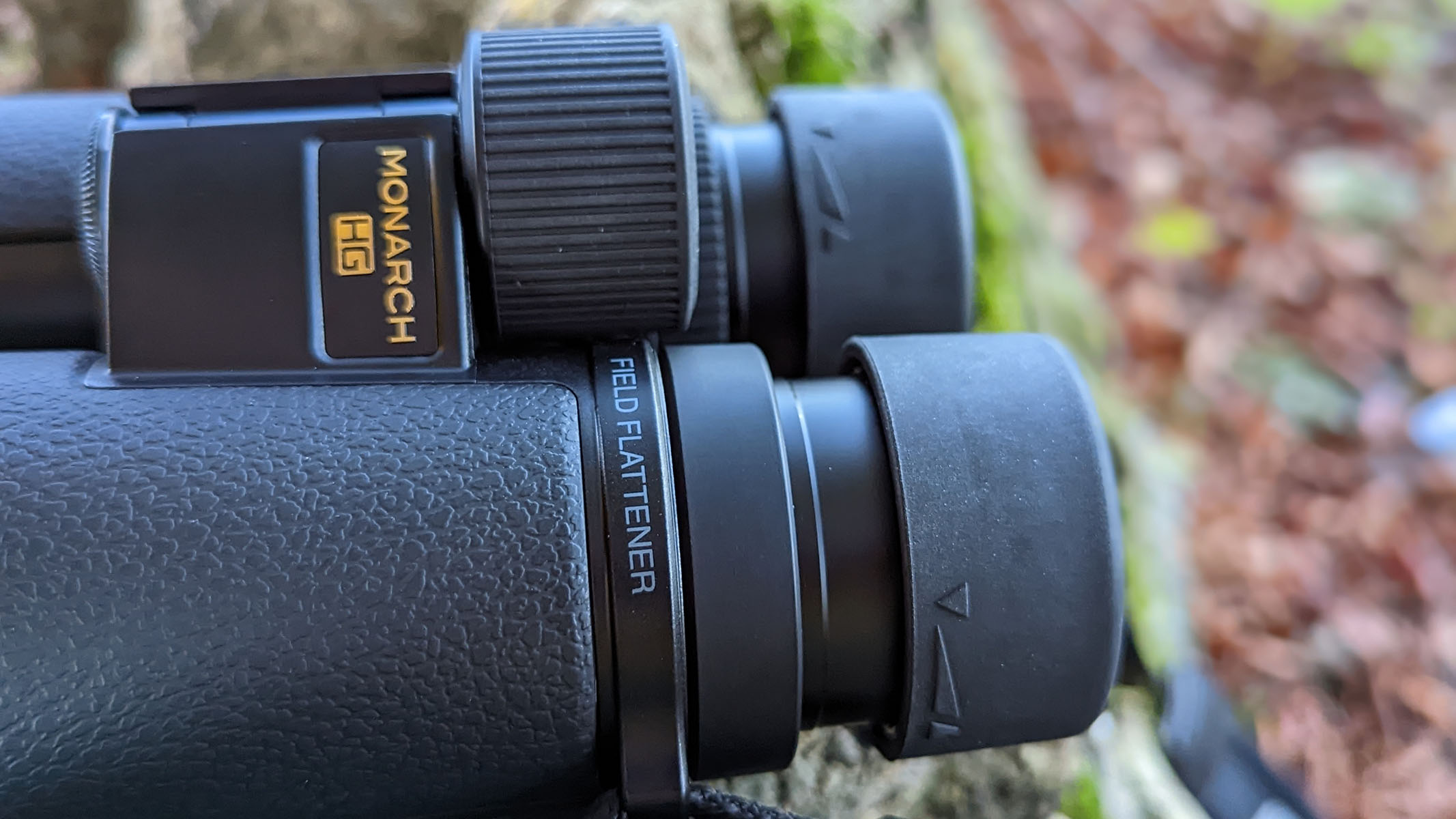
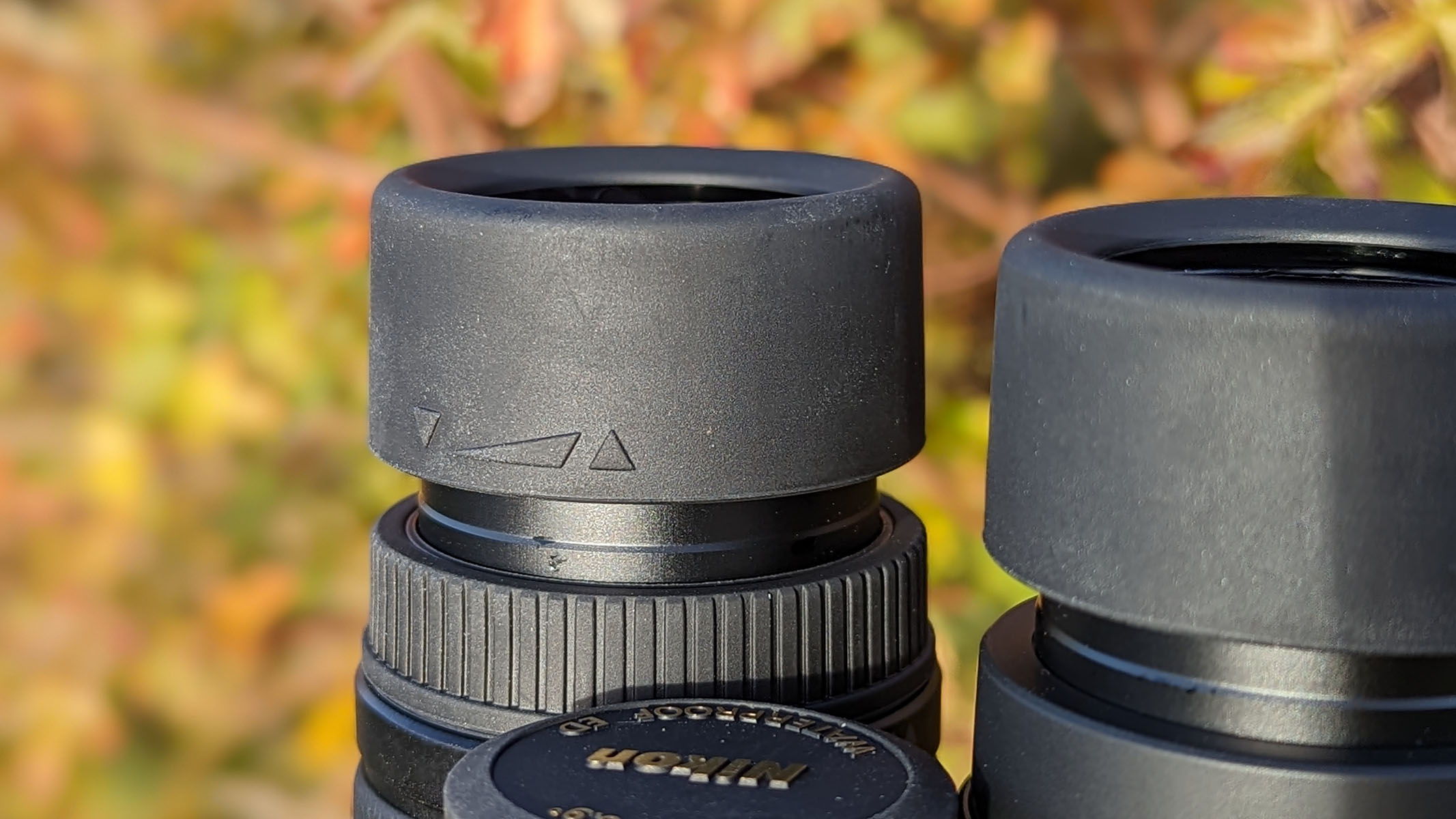
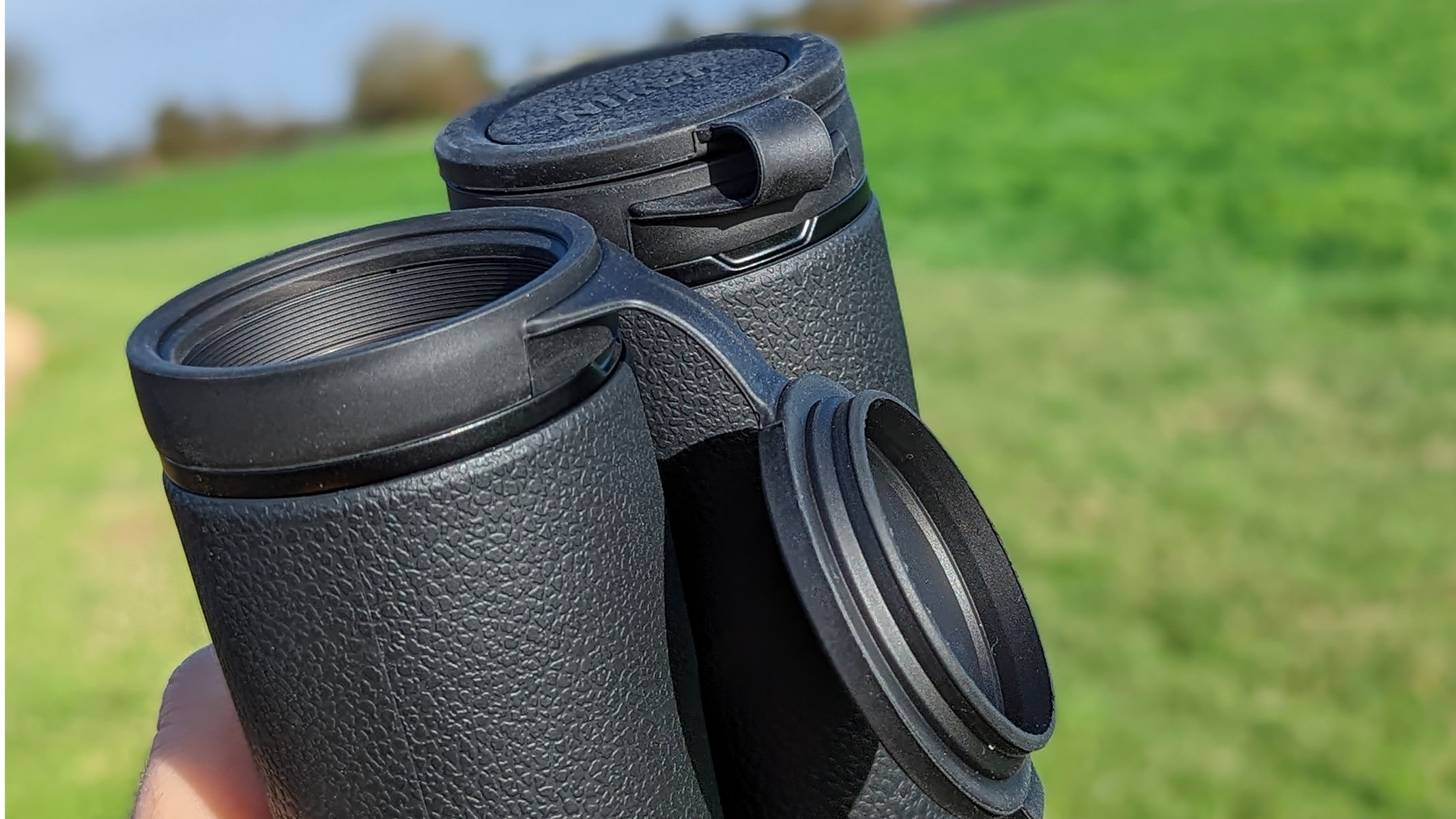
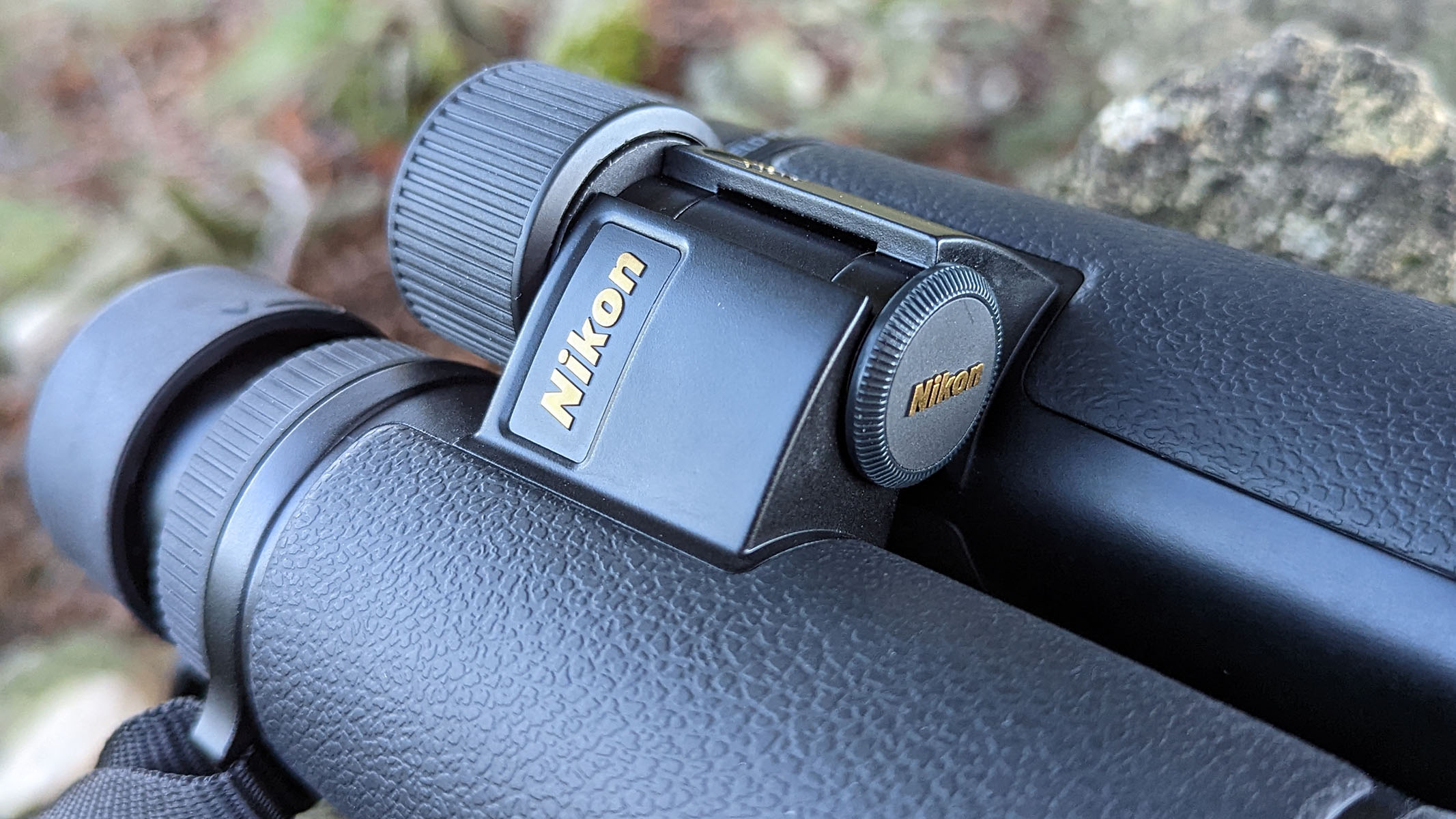
Specifications
Reasons to buy
Reasons to avoid
✅ You want lightweight, portable binoculars: They weigh just 1.5lbs / 680g, making them one of the lightest on this list, second to the Nikon Prostaff P7 10x42.
✅ You don't want to skimp on optics: They have quite possibly the best optical performance of all the binoculars we've ever tested.
❌ You want image stabilization: Possibly their only achilles heel — they don't have image stabilization. If that's a non-negotiable feature, we'd recommend the Canon 10x42 IS WP.
❌ You're a beginner: If you're not experienced enough to invest on a high-end binocular, we think the more beginner-friendly Celestron SkyMaster 12x60 are better suited.
🔎 Nikon Monarch HG 10x42: High-quality optical glass elements, all of which are multicoated to improve light transmission, premium exterior finish for better handling and more reliable focusing, plus a whole host of excellent accessories that owners won't need to upgrade mean they'll last for years to come. ★★★★½
Design: The Nikon Monarch HG 10x42 are premium all over, with gold detailing and a narrow, slender design — we think they're some of the best-looking binos out there. They've avoided the hard, slippery finish you tend to get with cheaper binoculars and have produced a soft, plump rubber finish with texturing that helps the user get a good grip on them in all weathers, even while wearing gloves, which is ideal if you're using them on a chilly night.
We really loved the locking diopter ring (which also features on the Prostaff P7 series). Just lift and click the lock into place to retain the diopter setting to ensure that you won't knock it when taking them out of the bag. This is essential to get accurate and sharp views if you're moving around outside or passing them to others briefly to use.
Performance: For the best of the best when it comes to image quality, Nikon's top-of-the-line Monarch HG 10x42 fit the bill perfectly. They perform exceptionally well across various different parameters, and, although they cost a hefty chunk of cash, in exchange you get high-quality build and optical quality that is near perfect, in our opinion. Thanks to the Field Flattener System, the images are sharp across the entire field of view, and we found basically no chromatic aberration whatsoever.
We put them through their paces in our full Nikon Monarch HG 10x42 review and, frankly, were blown away. We actually found it hard to find and flaws — they scream quality and premium from top to bottom. Not only do each of the parts operate effectively but they also look and feel great in the hand.
Functionality: Although they may seem expensive to the average binocular user, they're actually incredible value for money when you consider what you're getting. Sharp images across the entire frame, color fringing is all but invisible (apart from the tiniest fraction around dark edges) thanks to Nikon’s Extra-low Dispersion (ED) glass elements and the multilayer coatings of each glass element amount to 92% or better light transmission, according to Nikon. They're also waterproof and fog-proof to aid use in all weathers and temperatures — the only thing we can think of to improve them would be to add image stabilization.
- Read our full Nikon Monarch HG 10x42 review
Attributes | Notes |
|---|---|
Design | Premium build and quality finish. |
Performance | Possibly the best optics we've tested. |
Functionality | Locking diopter ring keeps things sharp. |
Best premium binoculars for stargazing

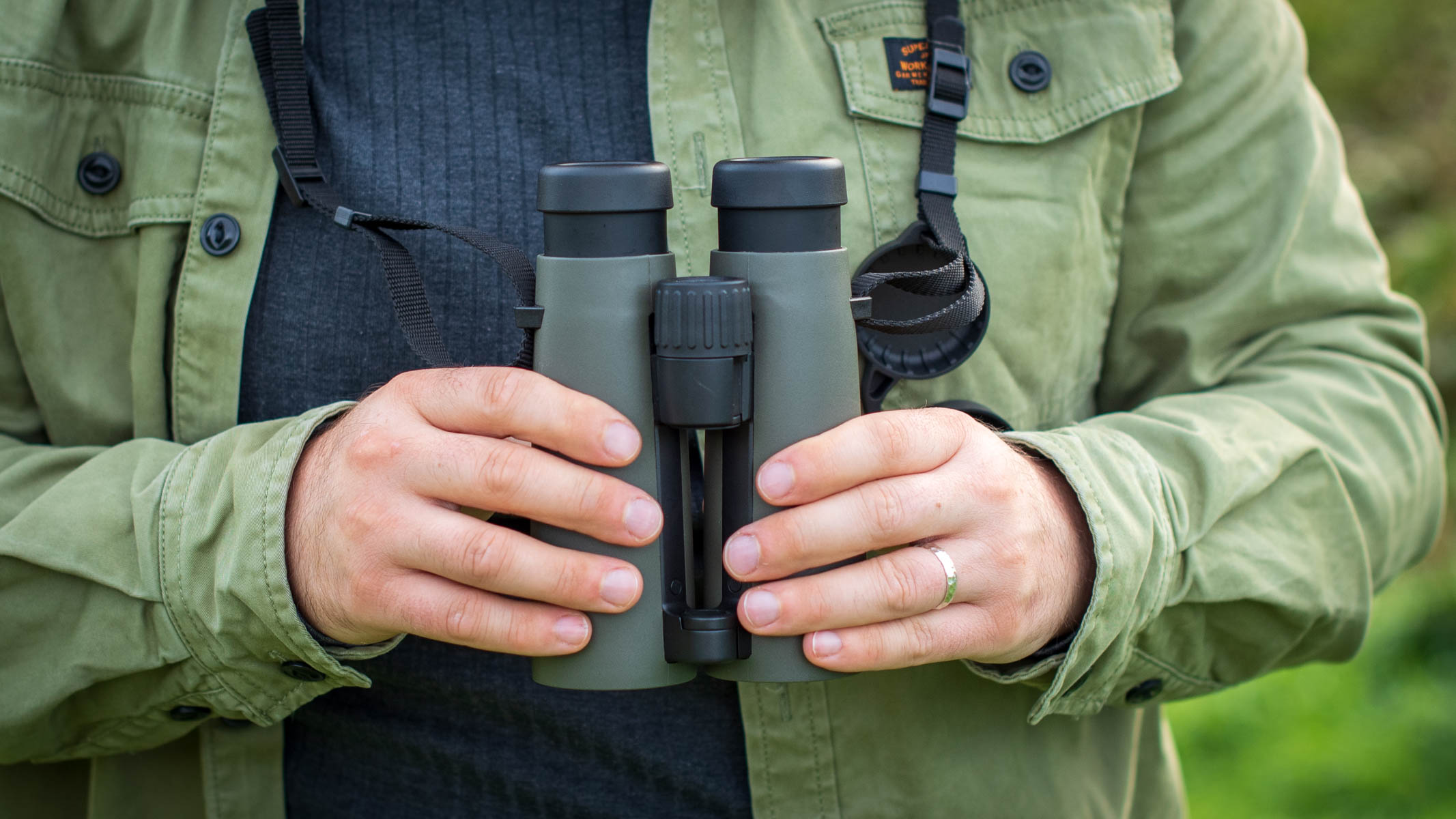
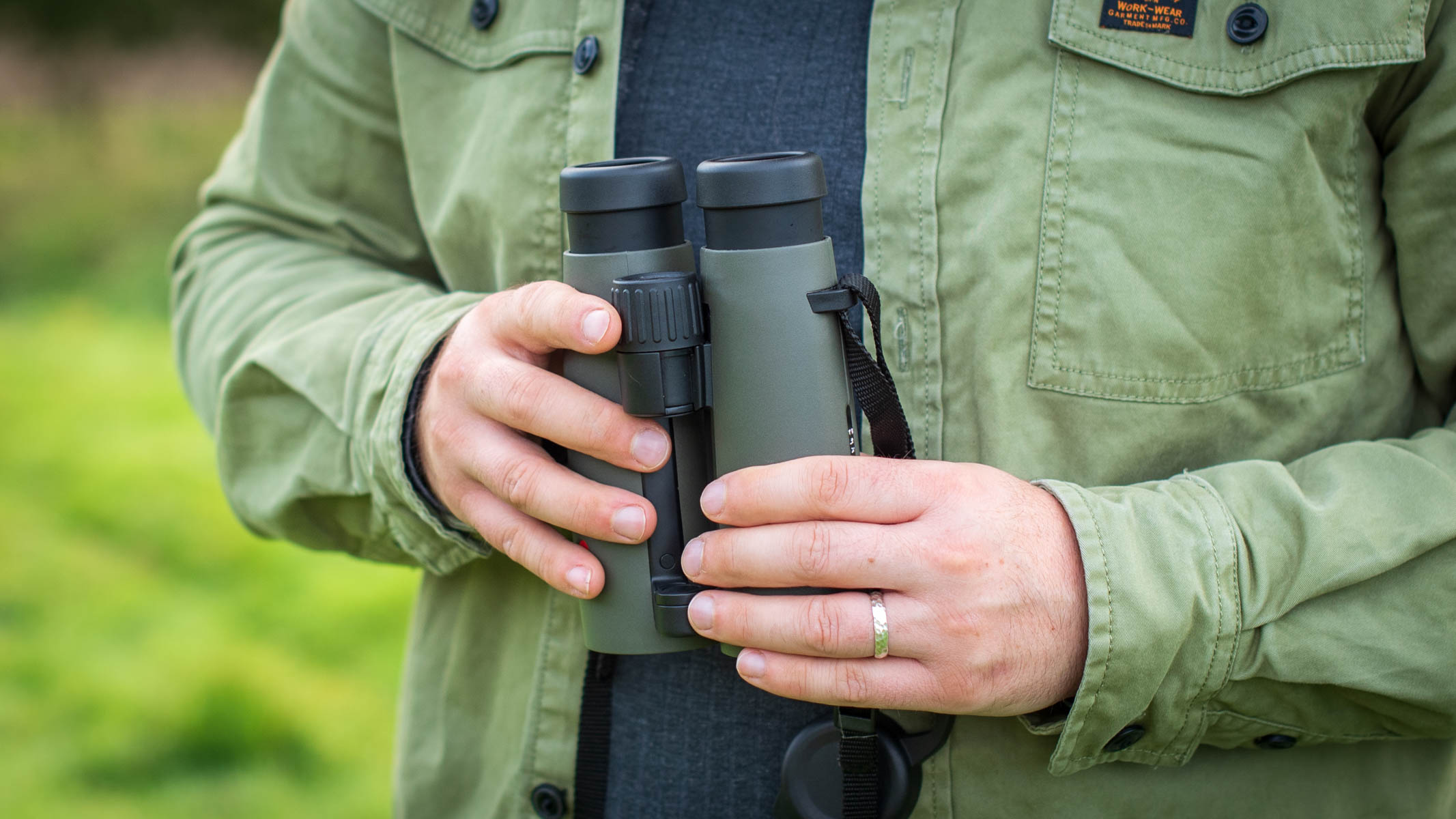
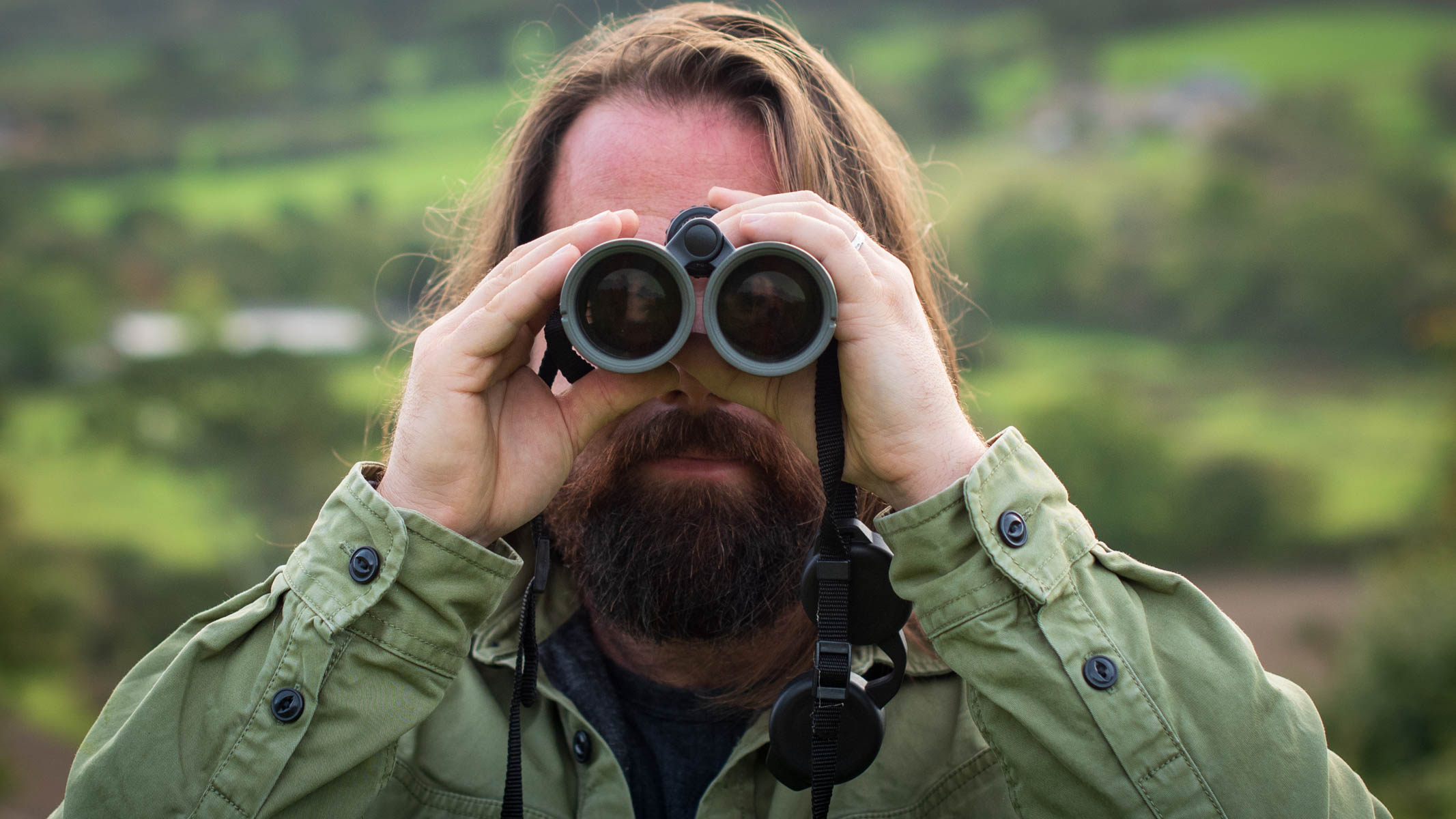
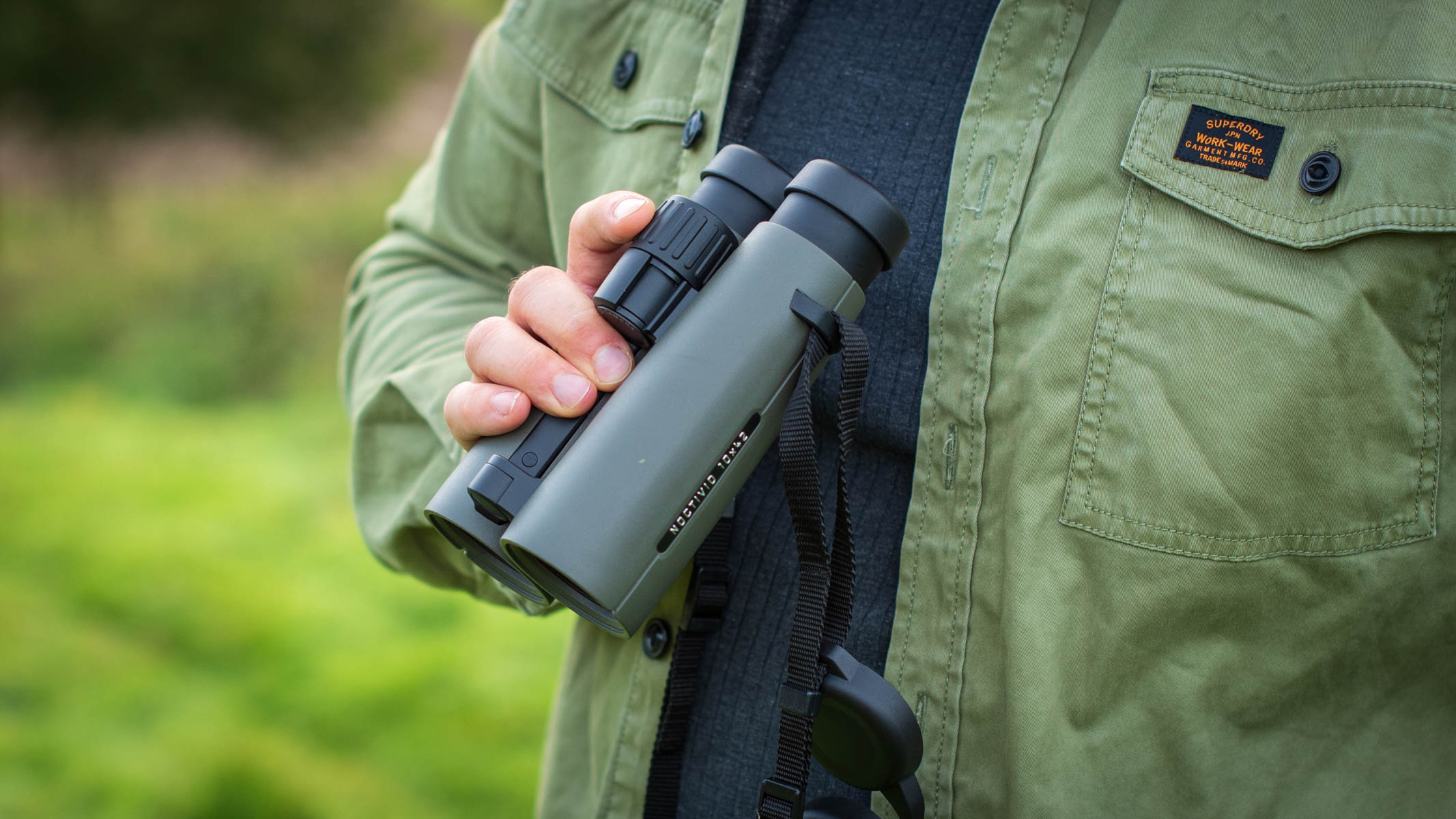
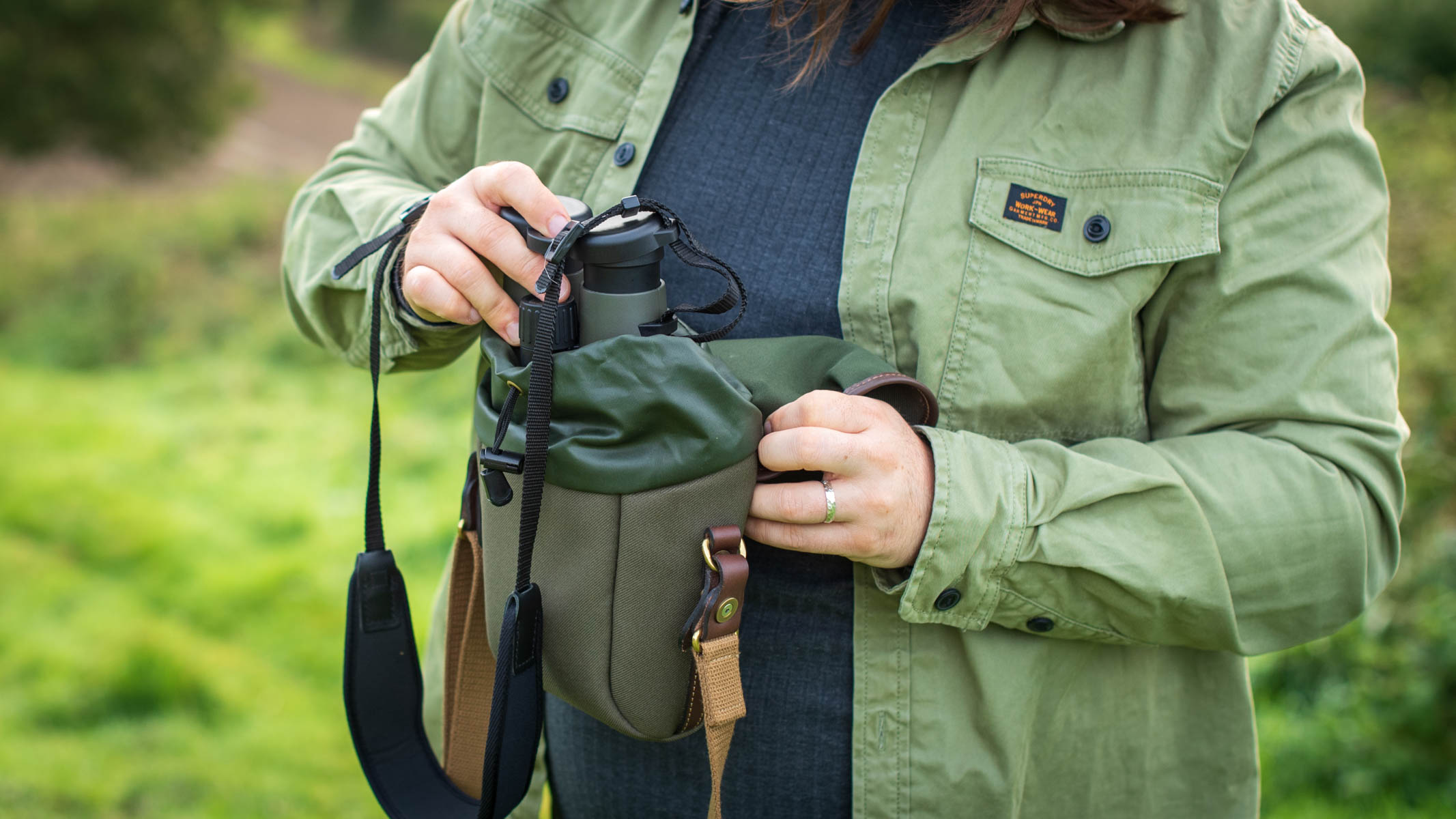
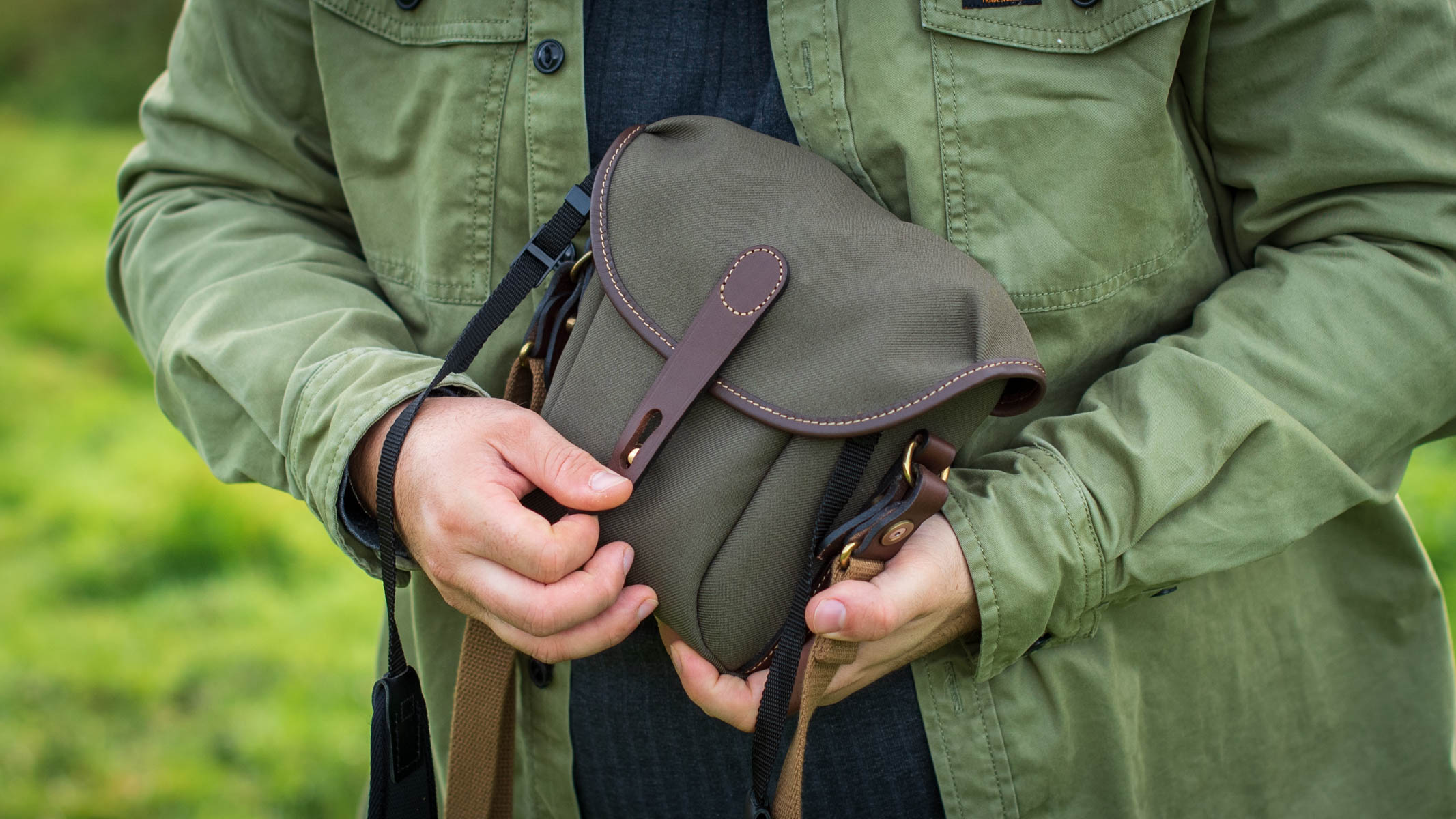
Specifications
Reasons to buy
Reasons to avoid
✅ You wear glasses: Their 19mm of eye relief is the longest on this list, meaning you won't have to take your glasses off to use them comfortably.
✅ You want the best of the best: They're a fantastic option if you need the best optics available and have the money to spend on them.
❌ You want to mount them on a tripod: Curiously, they don't have a tripod adapter, so you can't use them with a tripod.
❌ You don't have a huge budget: They're premium in every aspect — if you're looking for a step up from your beginner pair, we'd recommend the Celestron Nature DX 12x56.
🔎 Leica Noctivid 10x42: Possibly our favorite ever binoculars, with supreme sharpness, excellent light transmission and absolutely stunning looks, but their massive price tag will render them inaccessible for many users. ★★★★★
Design: As the old adage goes; 'it's what's on the inside that counts', however, you're also getting an absolutely beautiful pair of binoculars with the Leica Noctivid 10x42. During our Leica 10x42 Noctivid review, we were totally enamoured with the olive green edition which blends seamlessly with the natural surroundings (great if you're observing wildlife). They also feature a slim design that is easy to slip into a large coat pocket or into the provided carry bag (4.88 x 6.06 x 2.68-inches / 124 x 154 x 68mm), yet they're still weighty enough in the hand to make them comfortable to hold at 1.9 lbs / 862g.
Performance: When it comes to optical performance, they're basically perfect. They might be one of the only binoculars we've tested where we were unable to discern any kind of chromatic aberration (color fringing) around contrasted subjects, nor any significant coma. They provide a massive 19mm of eye relief, which is fantastic for users who wear glasses and want to be comfortable using them without having to remove their glasses. 19mm is the longest eye relief on this list, although it's a hefty price to pay for it.
Functionality: They feature HDC Plus-multicoating and AquaDura lens coating for maximum light transmission and to repel water when you're out in the elements. They're waterproof down to 5 meters (16.5 ft) and are nitrogen-filled, so they won't fog up when moving between hot and cold locations.
If we had to find a fault, we were a bit stumped as to why there's no tripod mounting point. You could argue that 10x42 doesn't necessarily need to be mounted on a tripod, but for such a high price tag we'd have liked to have the option — especially when other 10x42s can.
If you're looking for an exceptional pair of binoculars in 'silly money' territory for serious observations at a premium price, the Leica 10x42 Noctivid are some of the best 10x42s we've ever tested, and, for our money, possibly our favorite pair ever. We loved them so much that we even gave them full marks during our review. The only reason we haven't given them the title of 'Best Overall' here is due to their exceptionally high price which is out of reach for the majority of users.
- Read our full Leica 10x42 Noctivid review
Attributes | Notes |
|---|---|
Design | Beautiful green color, weighty in the hand. |
Performance | No visible chromatic aberration or coma distortion present. |
Functionality | Lacks a tripod mounting point. |
Best value for money
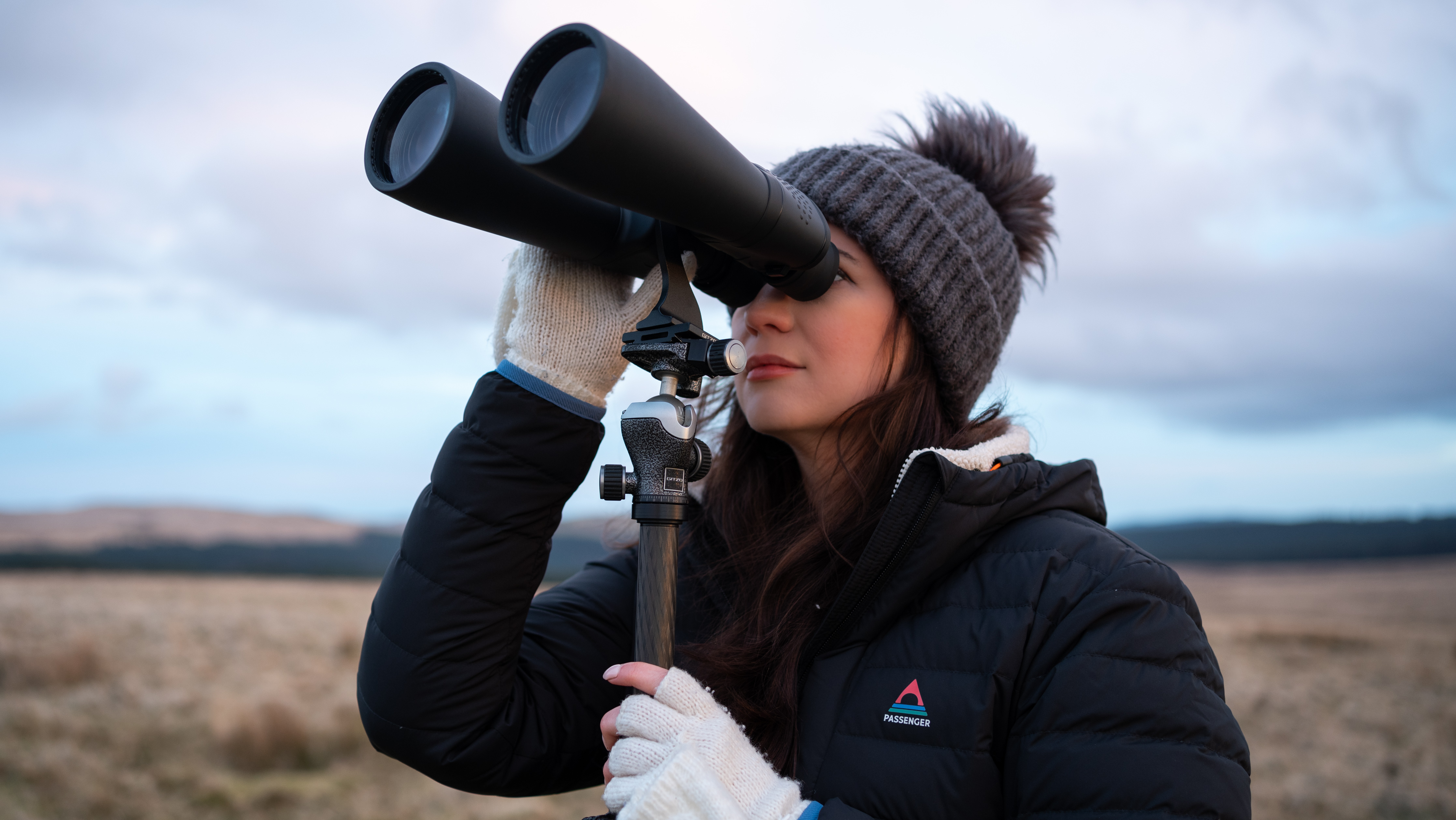
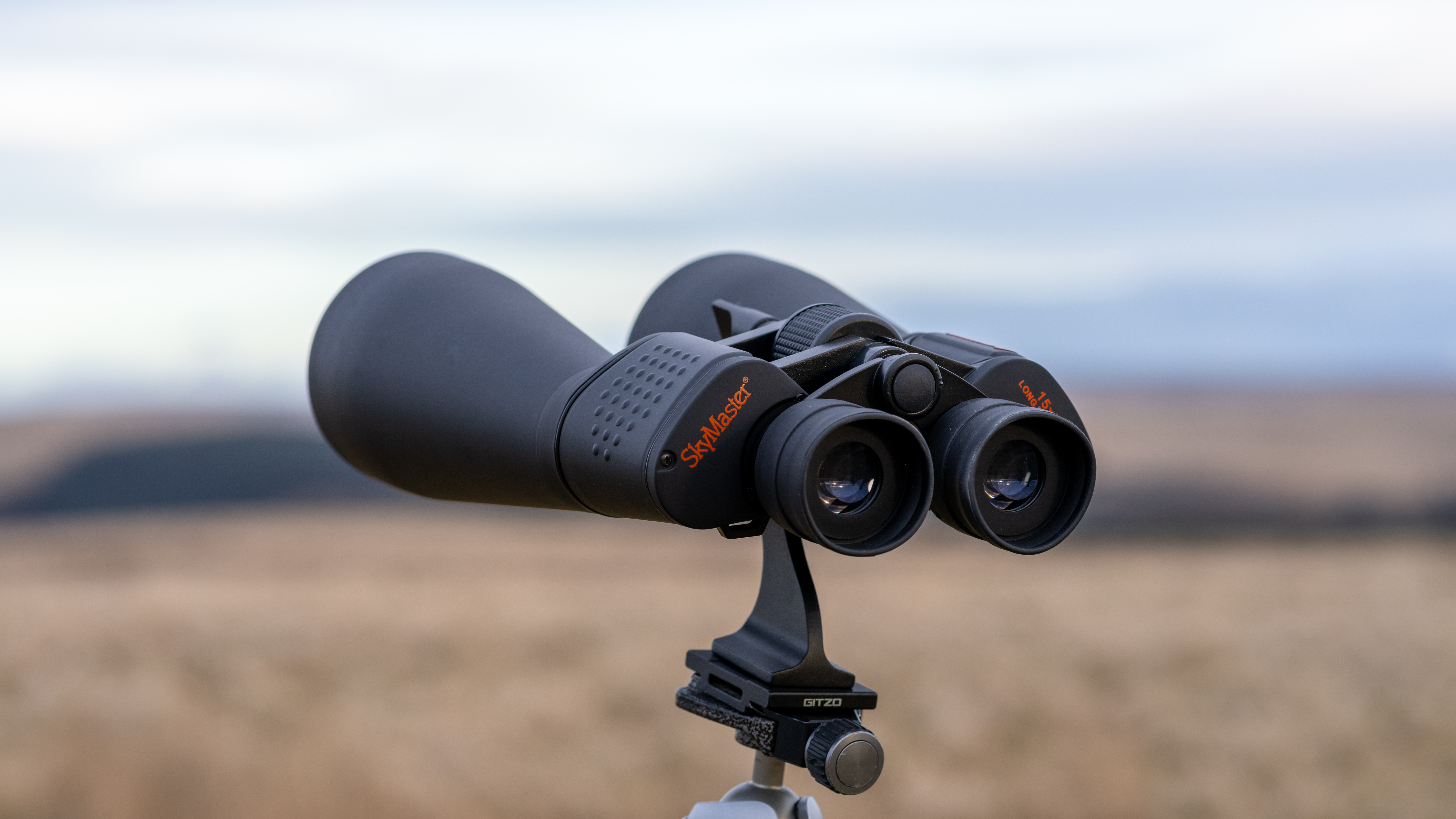
Specifications
Reasons to buy
Reasons to avoid
✅ You want to view a variety of celestial subjects: We were able to see a whole host of night sky objects.
✅ You don't want to spend loads: For the money, we think they're a bargain.
❌ You want detailed images: If you want detailed views of planets, we'd recommend getting a telescope instead.
❌ You want to use them handheld: They're too heavy and the magnification is too high. Opt for something like the Nikon Prostaff P7 10x42 for handheld use.
🔎 Celestron SkyMaster 15x70: For the money, we think they're a fantastic pair of binoculars capable of viewing an impressive number of subjects. There's visible chromatic aberration, but if you can look past that, they're well worth it. ★★★★
If you want an excellent pair of astronomy binoculars that won't break the bank, the Celestron SkyMaster 15x70 are well worth consideration. Although they're on the heavy side and will require a tripod, during our Celestron SkyMaster 15x70 review, we found them comfortable to use and we had hours of enjoyment searching for objects in the night sky. The fold-up eyecups molded to our face nicely, although we found the focus wheel and diopter to be incredibly stiff, which made them wobble a lot when setting the focus.
In terms of optical performance, they're good but not amazing. There's a noticeable amount of chromatic aberration, particularly around the moon, but that's to be expected for the price. But the lunar views were overall very impressive, giving bright and sharp images. Planetary views are somewhat lacking, with Venus looking like it's on fire due to the color fringing — but if you want detailed planets, you're better off buying one of the best telescopes. Still, we were able to make out all four of Jupiter's Galilean moons, and we enjoyed views of the Orion nebula and Andromeda Galaxy.
We thought that stargazing is where these binoculars really shine — the Pleiades look fantastic, and we also saw the Beehive Cluster as well as getting a closer look at the Horse and Rider in the Big Dipper.
If you want a pair that are a bit easier to use handheld but still give decent magnification, the next pair on this list might be more suitable.
- Read our full Celestron SkyMaster 15x70 review
Attributes | Notes |
|---|---|
Design | Requires a tripod. |
Performance | Provides pleasing views of a range of subjects. |
Functionality | Not fogproof, visible chromatic aberration. |
Best for handheld stargazing
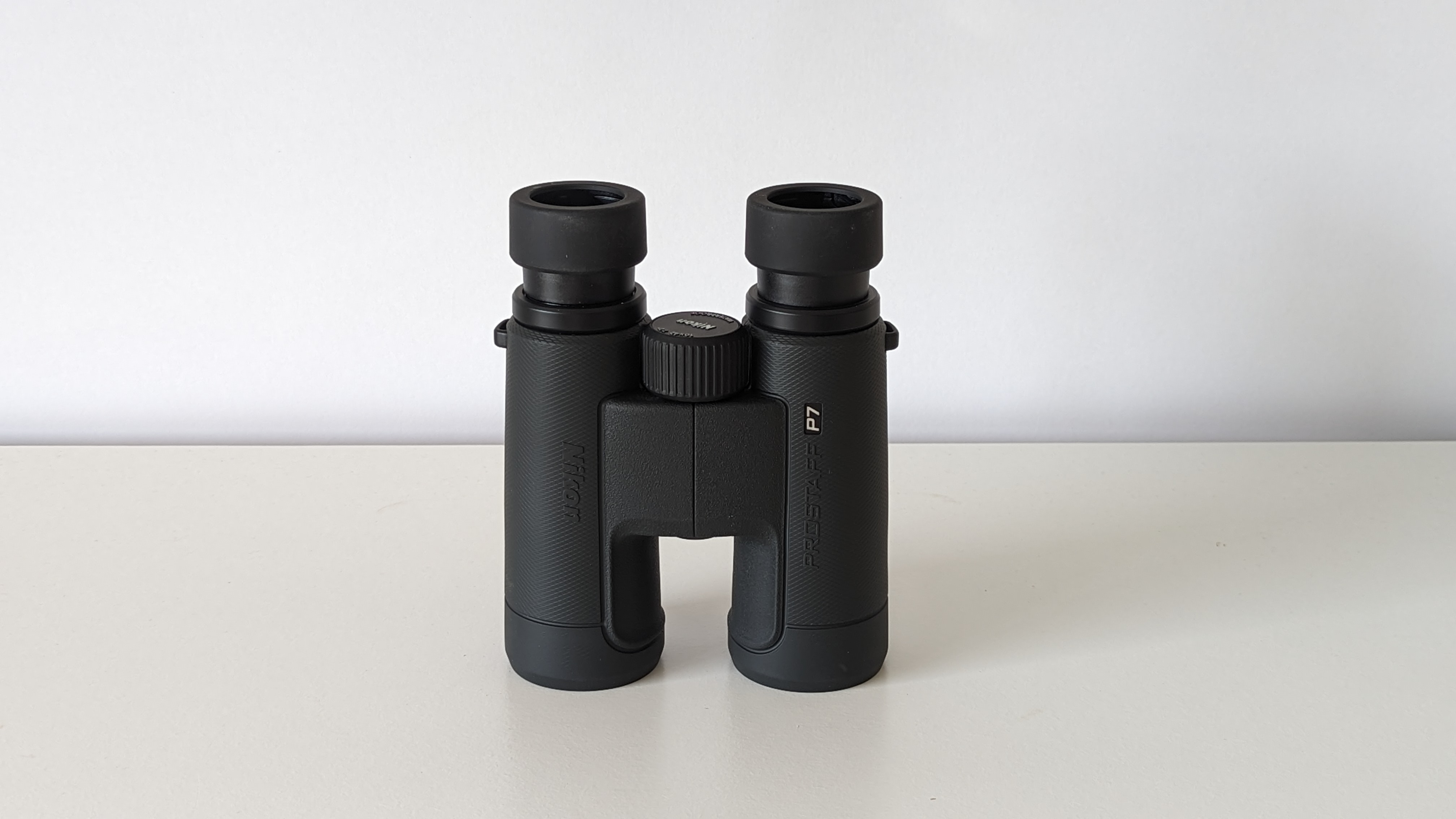
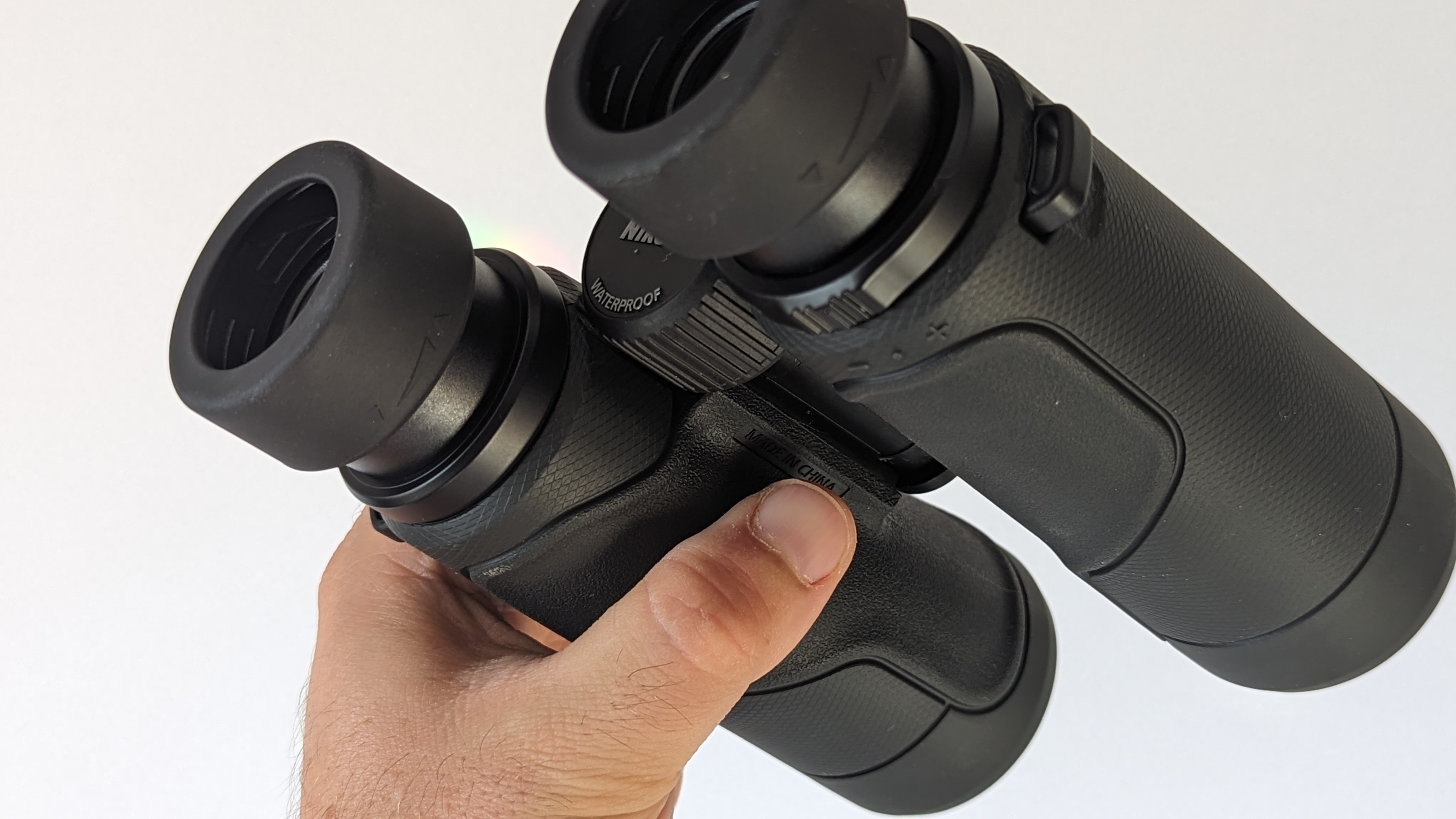
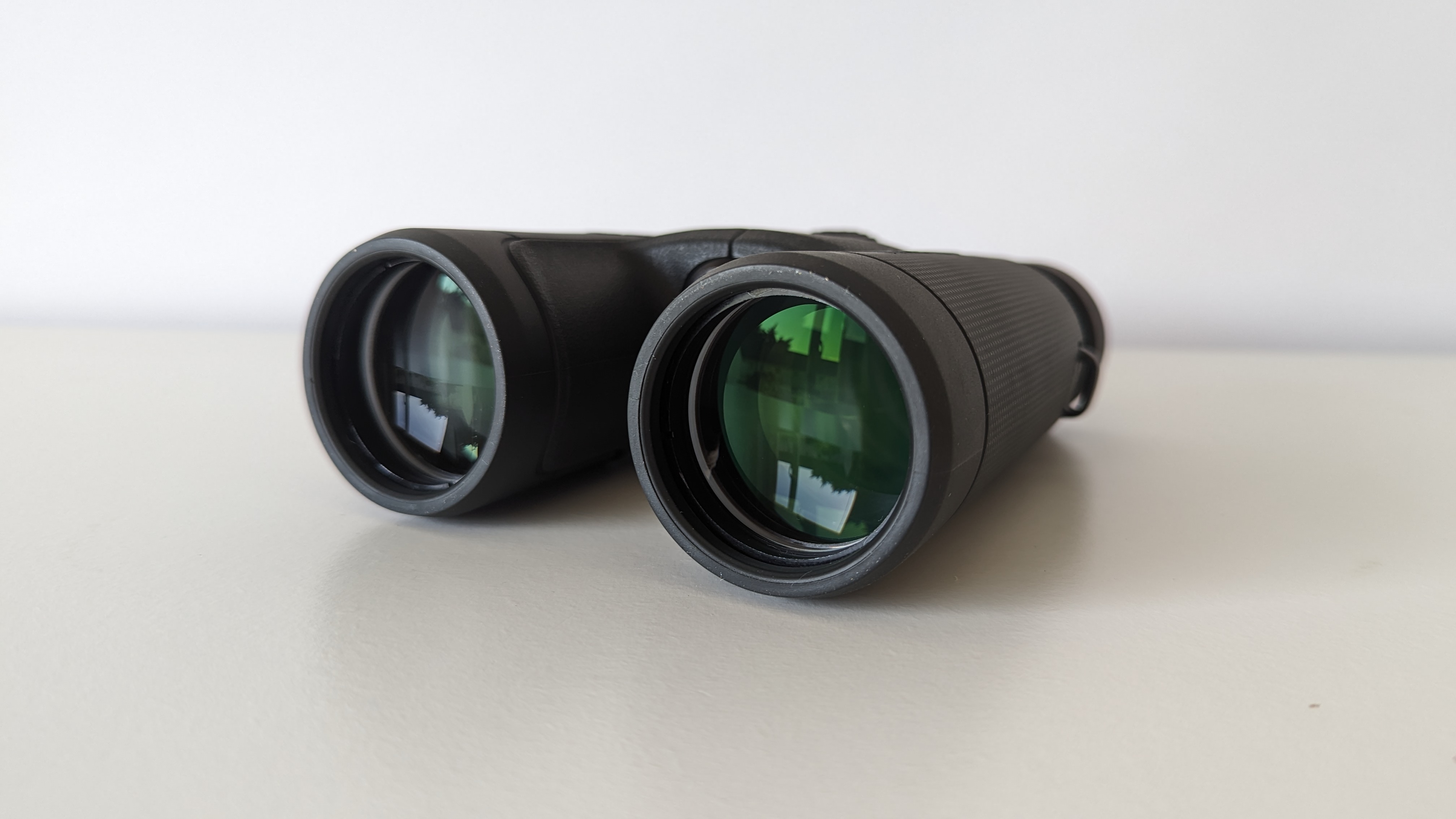
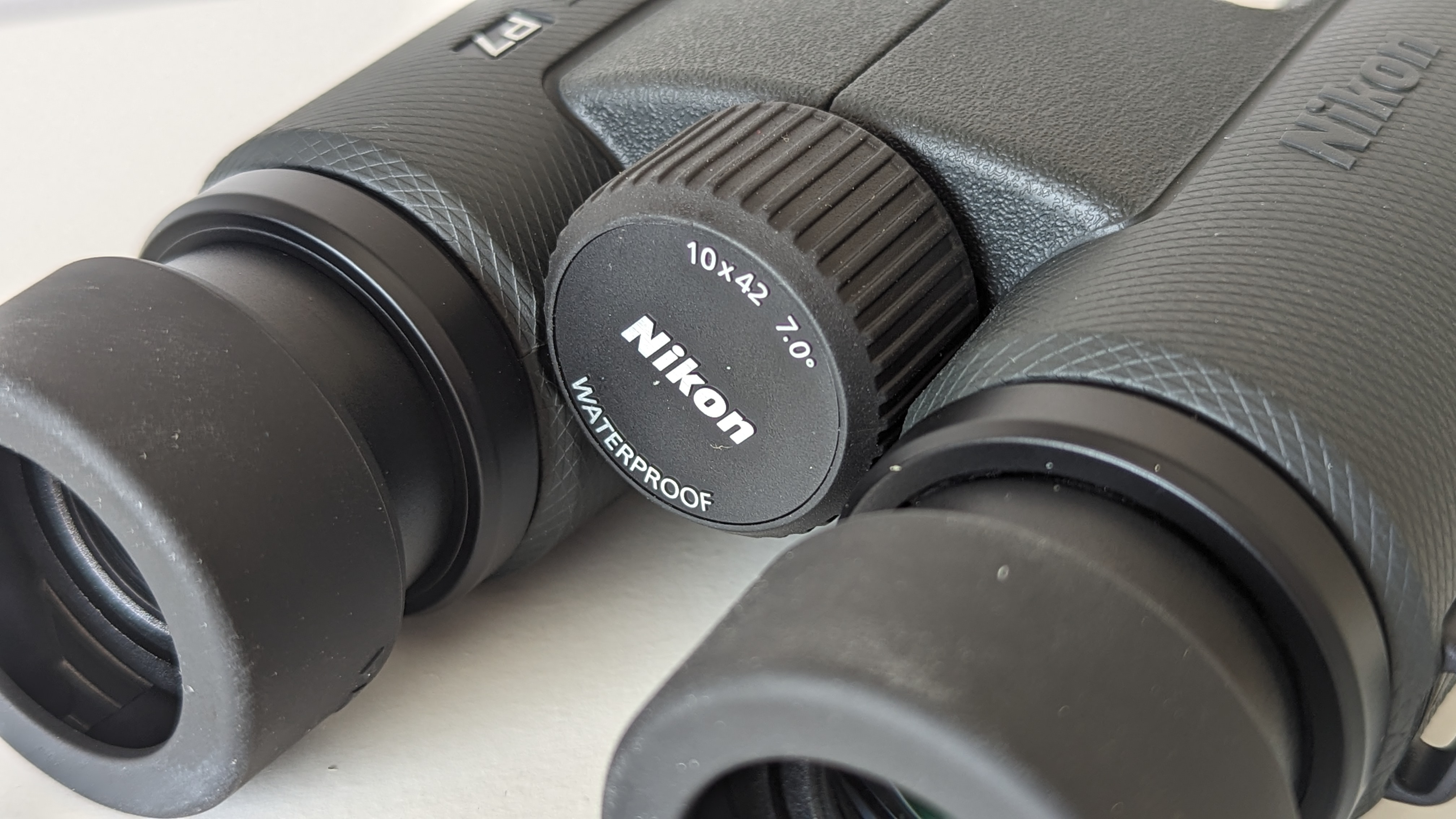
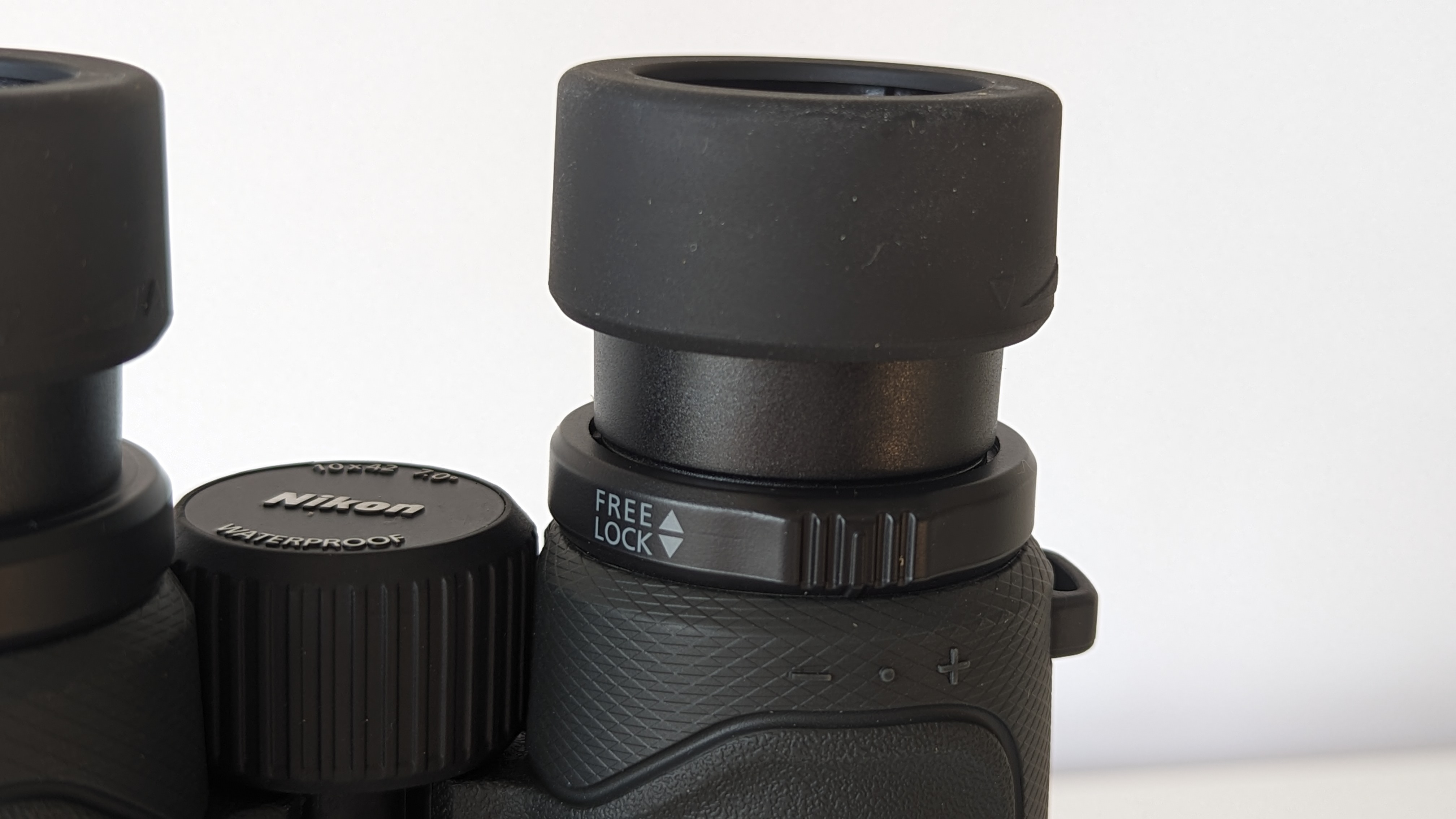
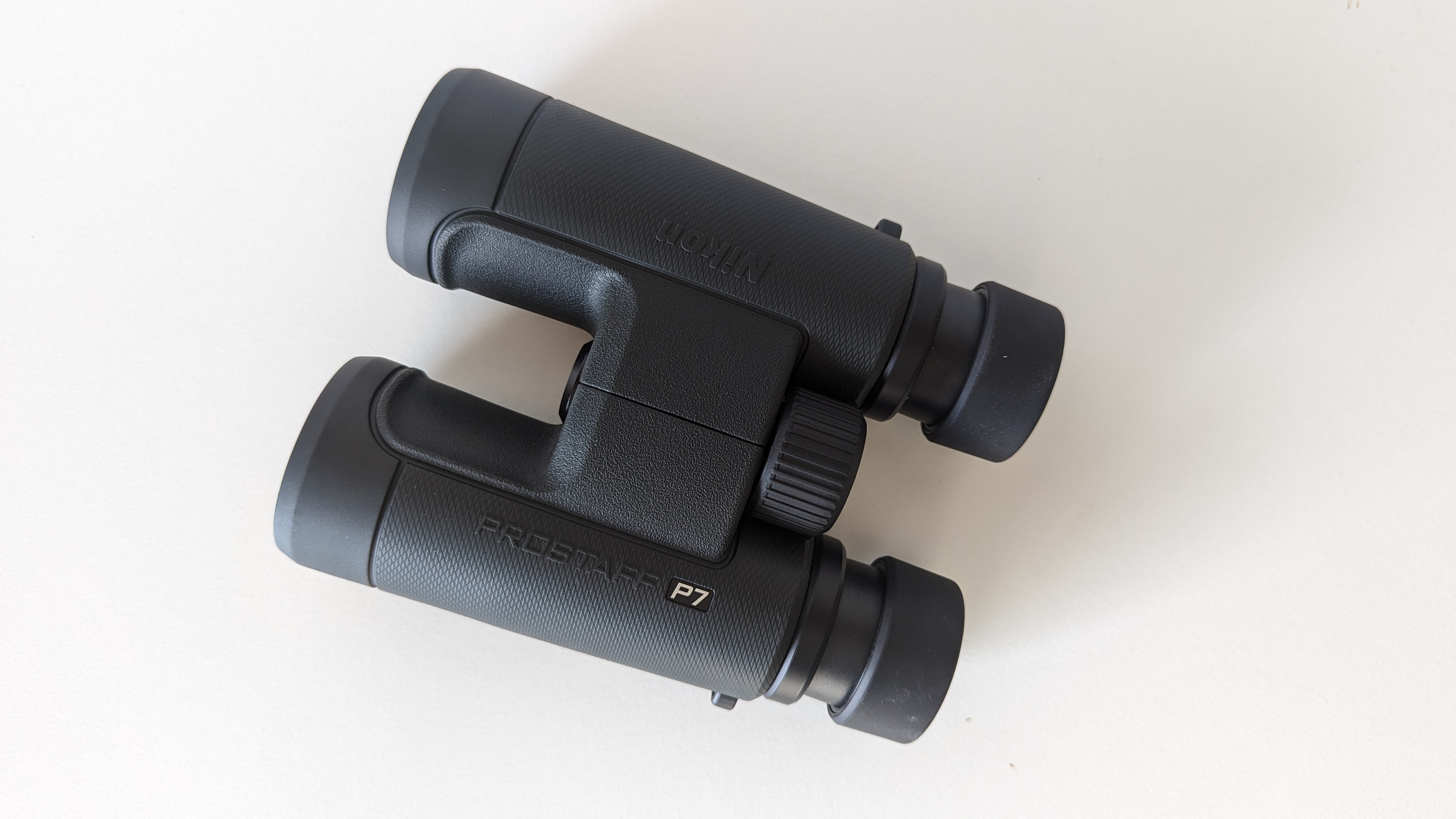
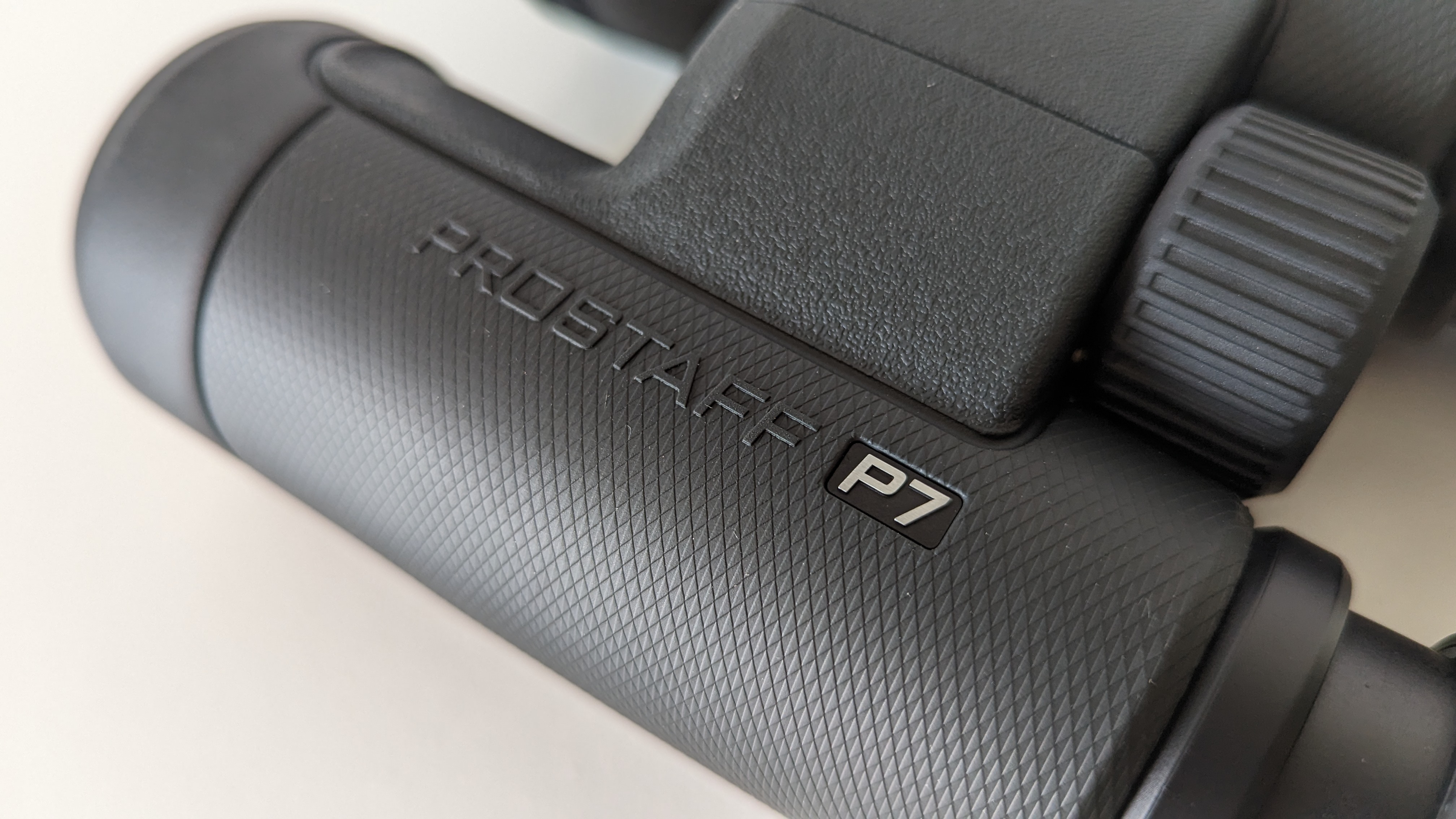
Specifications
Reasons to buy
Reasons to avoid
✅ You want to take them on long-distance travels: They're the most portable and lightweight pair of binoculars on this list at 21.2 oz / 601g.
✅ You want quality optics on a budget: We were surprisingly impressed at how good the optics are for the price.
❌ You want to use them for long periods but you wear glasses: While the 15.7mm eye relief is fine for short periods, users who wear glasses will be more comfortable with the 17mm of the Nikon Monarch HG 10x42 or the 16mm in the Celestron Nature DX 12x56.
❌ You want the best of the best: If you have the budget to spend on a serious pair of binos, we'd recommend the Leica Noctivid 10x42.
🔎 Nikon Prostaff P7 10x42: For a good set of intermediate binoculars with fantastic optical performance, excellent general build quality and one or two premium features, then for 200 bucks or less the Nikon Prostaff P7 10x42 binoculars are for you. ★★★★½
Design: Striking a perfect balance between beginners who want a budget-friendly option and advanced observers who use binoculars day-in and day-out and are happy to invest in the best quality pair, we think the Nikon Prostaff P7 10x42 have excellent build quality, a premium feel and great optical performance all for under $200 — not to mention, they're the most lightweight pair on this list.
We tested the P7s out in our thorough Nikon Prostaff P7 10x42 review and noted that it was rare to find a pair of binoculars that are both affordable and well-built. Overall, we were very impressed and most of the faults we found with them were more down to personal preference. The rubber coating wraps around the entire body to keep all the moving parts shielded from weather and dust. We also appreciated the locking diopter wheel to prevent any accidental defocusing while we were using them.
Performance: We had no trouble observing details from treelines 45 minutes after dusk, so although they aren't specialized for astronomy use, they'll still do the job with their bright 42mm objectives. We comfortably hiked with these binos around our neck for over three hours and could've easily gone several more thanks to the comfortable neck strap and lightweight, portable design of the P7s.
We were surprised at just how good they are, despite the fact they don't have any of the special glass elements that higher-end binoculars have, like extra-low dispersion glass or field flatteners. We typically see these features on the more expensive models to reduce color fringing and coma distortion, but we found the Prostaff P7's views looked sharp without it.
Functionality: Every part of these binos is well made and high quality with a stealthy near-black appearance. They are fully waterproofed down to 3.3 feet (1 meter) and nitrogen-purged to prevent fogging, which is ideal for outdoor pursuits where you might get caught out in adverse weather or transition between warm and cold temperatures.
The 4.2mm exit pupil was a little smaller than we'd have liked, with the viewing circle on the small to medium side, but we didn't think it detracted from using them. Unsurprisingly, they have those pesky detachable lens caps that have a habit of getting lost easily, but attached lens caps are typically a perk associated with the more expensive models.
- Read our full Nikon Prostaff P7 10x42 review
Attributes | Notes |
|---|---|
Design | Texturized rubber layer protects them from the elements. |
Performance | Optics are sharp despite lacking extra-low dispersion glass. |
Functionality | Really portable design and lightweight for long-distance travel. |
Best image-stabilized binoculars for stargazing
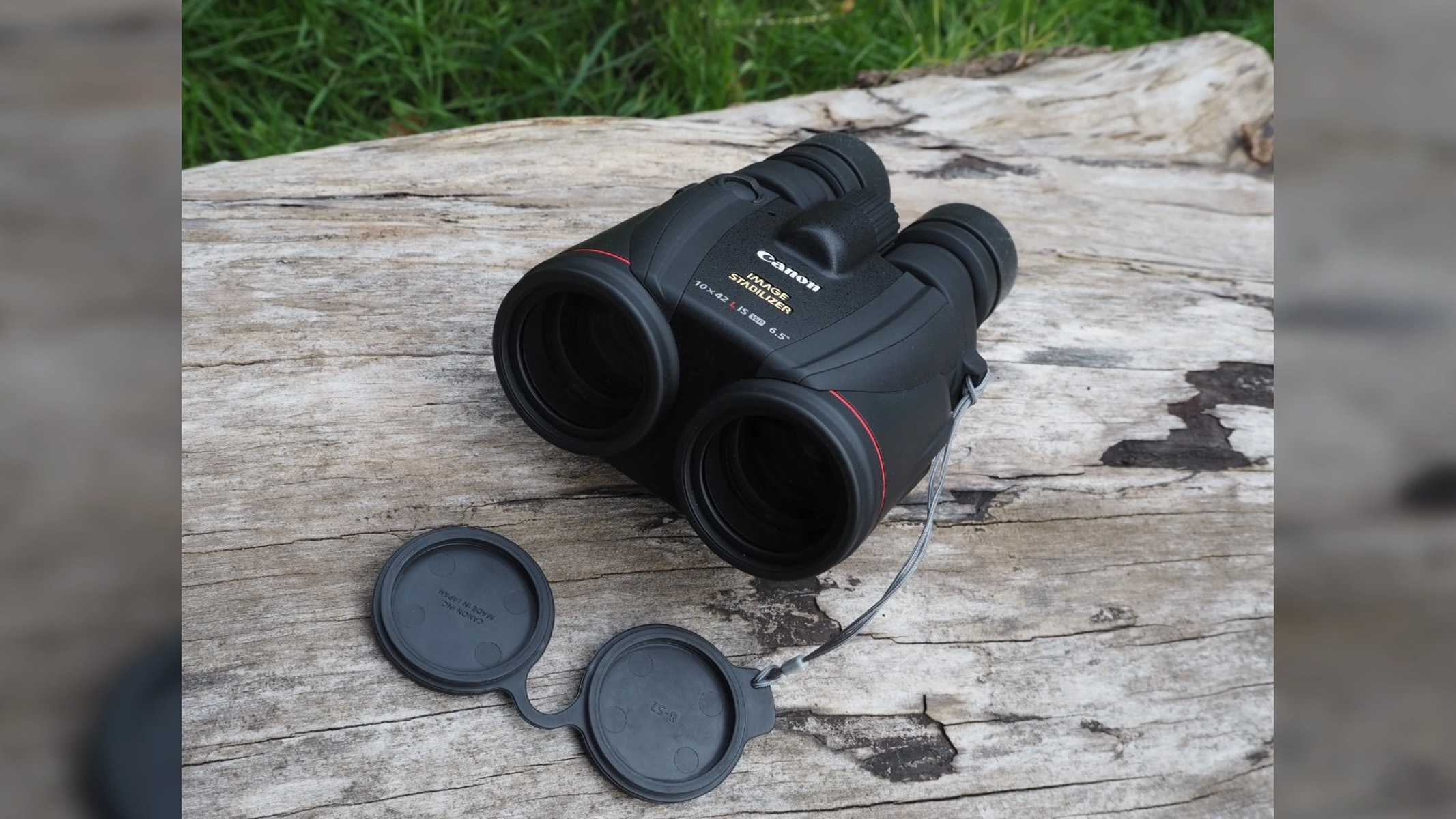
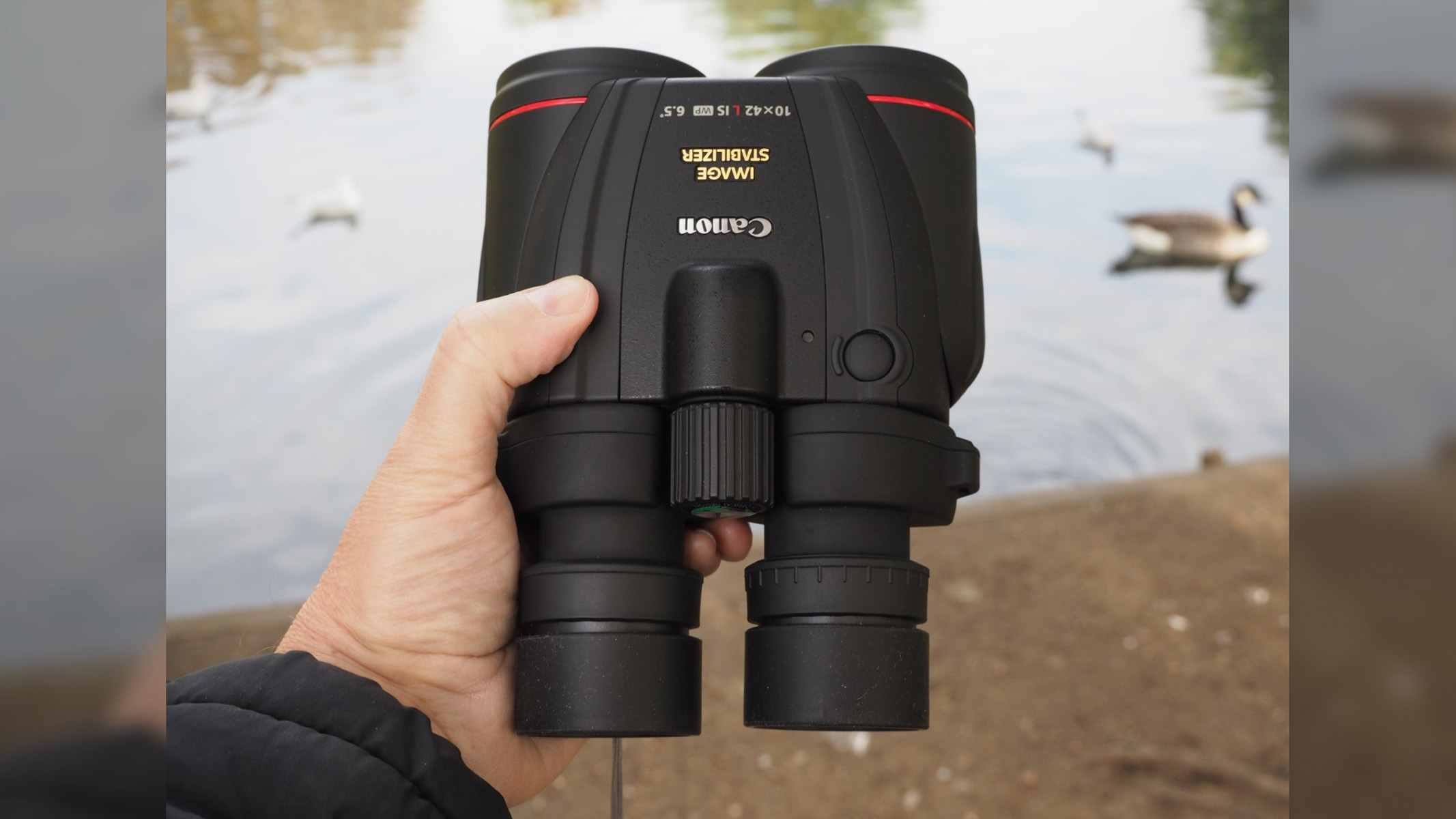
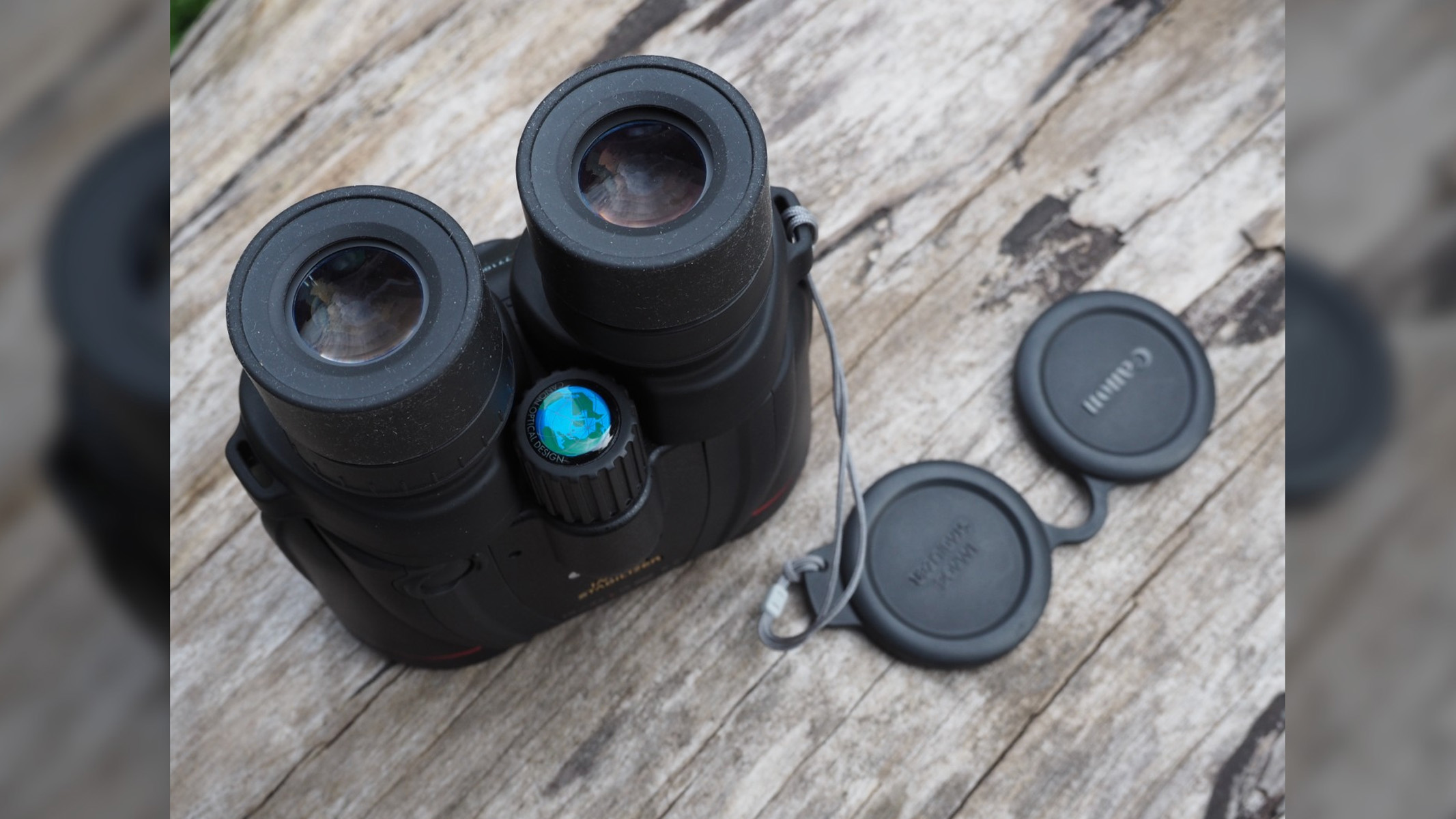
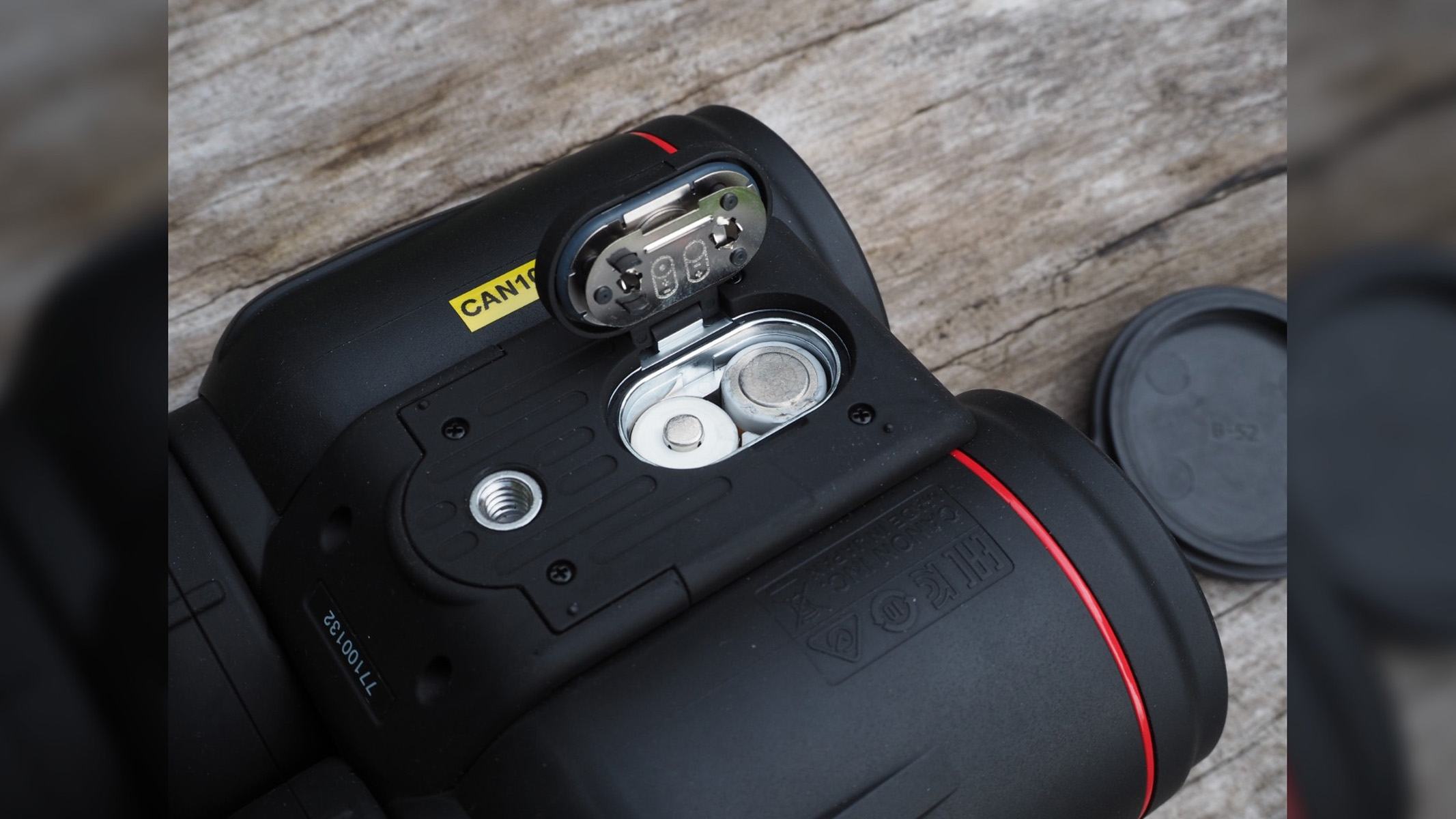
Specifications
Reasons to buy
Reasons to avoid
✅ Wobble-free performance is important to you: Image stabilization is an incredibly useful feature where it's needed, like for wildlife observation or sports.
✅ You want high quality optics: We were very impressed by the crystal clear and sharp images it produces.
❌ You want to use them for extended periods: They can become quite heavy when used for longer sessions — consider a more lightweight pair, like the Nikon Monarch HG 10x42.
❌ You don't want to buy or carry batteries: The image stabilization requires AA batteries, which some users won't want to bother with.
🔎 Canon 10x42L IS WP: With its built-in image-stabilization, crystal clear observation, and wobble-free images these binoculars are clearly a premium choice — one that also comes with a premium price. ★★★★
Design: At 2.2 lbs, they feel reassuringly weighty to grip when held in both hands, even before you press the image stabilization button. Even though they don't have the dimpled surface you get with other competing models to aid your grip, we found them comfortable to hold even in wet conditions during our Canon 10x42L IS WP review.
We did have a small gripe with the design of the eyepieces, though. To aid comfort, they have a spongy rubber surround which we found attracted rather a lot of dust and 'bits' that tend to stick to the rubber over time.
Performance: We found that they have most common image aberrations like color fringing and vignetting well under control, and they're also Canon's first waterproof binoculars, so you can happily use them for daytime observations in adverse weather as well as for stargazing.
They feature ultra-low dispersion (UD) lens elements to make single points of light clearer and display accurate colors — which is an obvious advantage for stargazing. The objective lenses also have Canon’s multi-layered anti-reflective lens coating (called ‘Super Spectra’) to eliminate lens flare and ghosting, and to improve color reproduction.
The 10x magnification and 6.5 degrees field of view are ideal for general astronomy — we enjoyed using them for stargazing at the Pleiades and Orion nebula, and for detailed moon observations. However, if you're looking to do more deep-sky observing then you'll want a device with more magnification — there are some good options on this list, like the Celestron SkyMaster Pro 20x80 or the Celestron SkyMaster 25x100.
Functionality: When it comes to image stabilization in binoculars, you can't go much better than the Canon 10x42L IS WP binoculars. Particularly for stargazing and moon observations, you want as much of a wobble-free view as possible, so even though image stabilization never comes cheap, we think it's an extremely worthwhile feature. Although it's worth noting that the IS requires 2 x AA batteries to work, and they get eaten up pretty quickly in cold weather, so it's worth carrying a few spare packs with you.
- Read our full Canon 10x42L IS WP review
Attributes | Notes |
|---|---|
Design | On the heavier side, but sturdy in the hand. |
Performance | Powerful magnification and top-tier optical quality. |
Functionality | Canon’s first image-stabilized binos to offer waterproofing. |
Best mid-range binoculars for stargazing
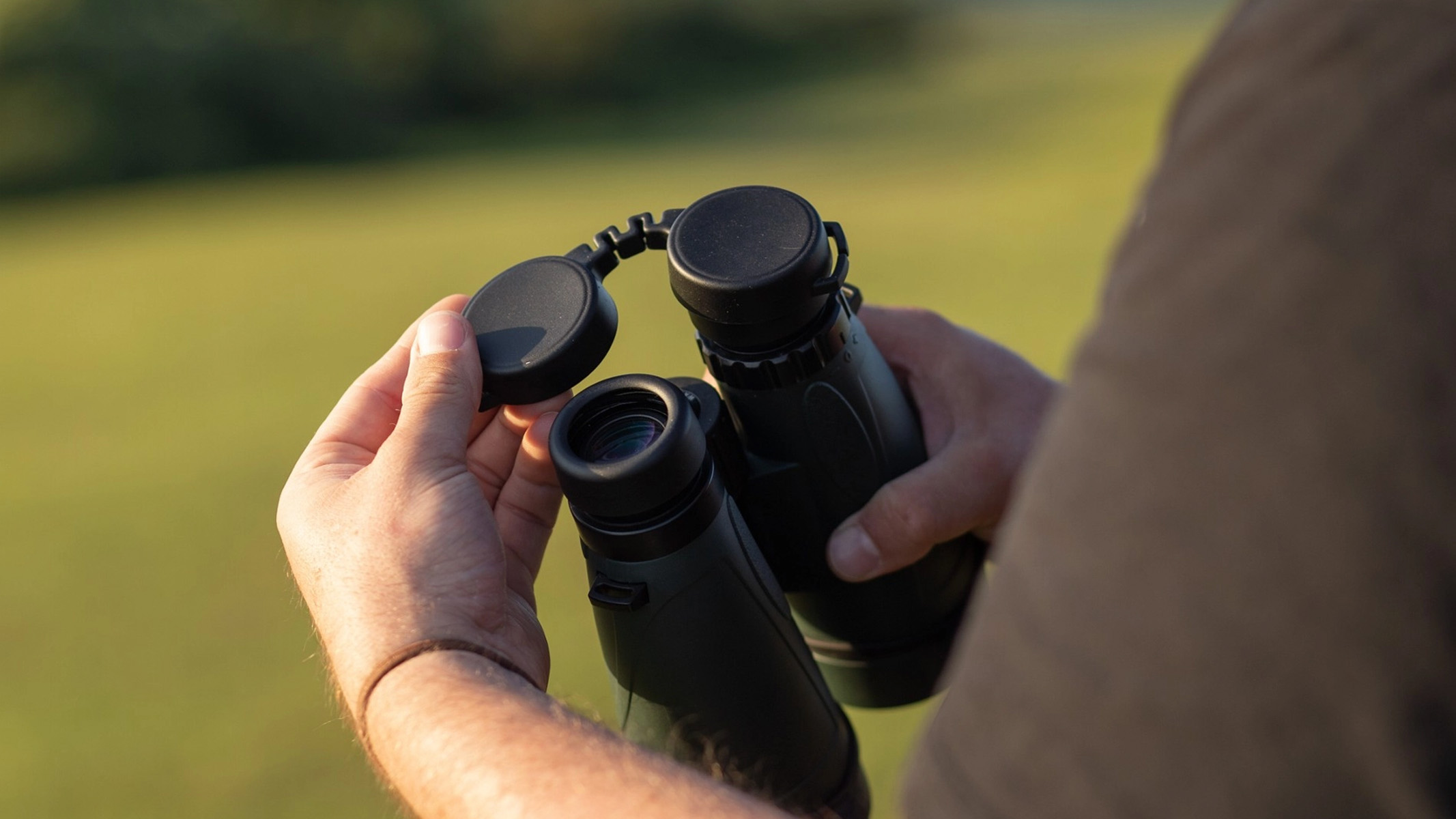
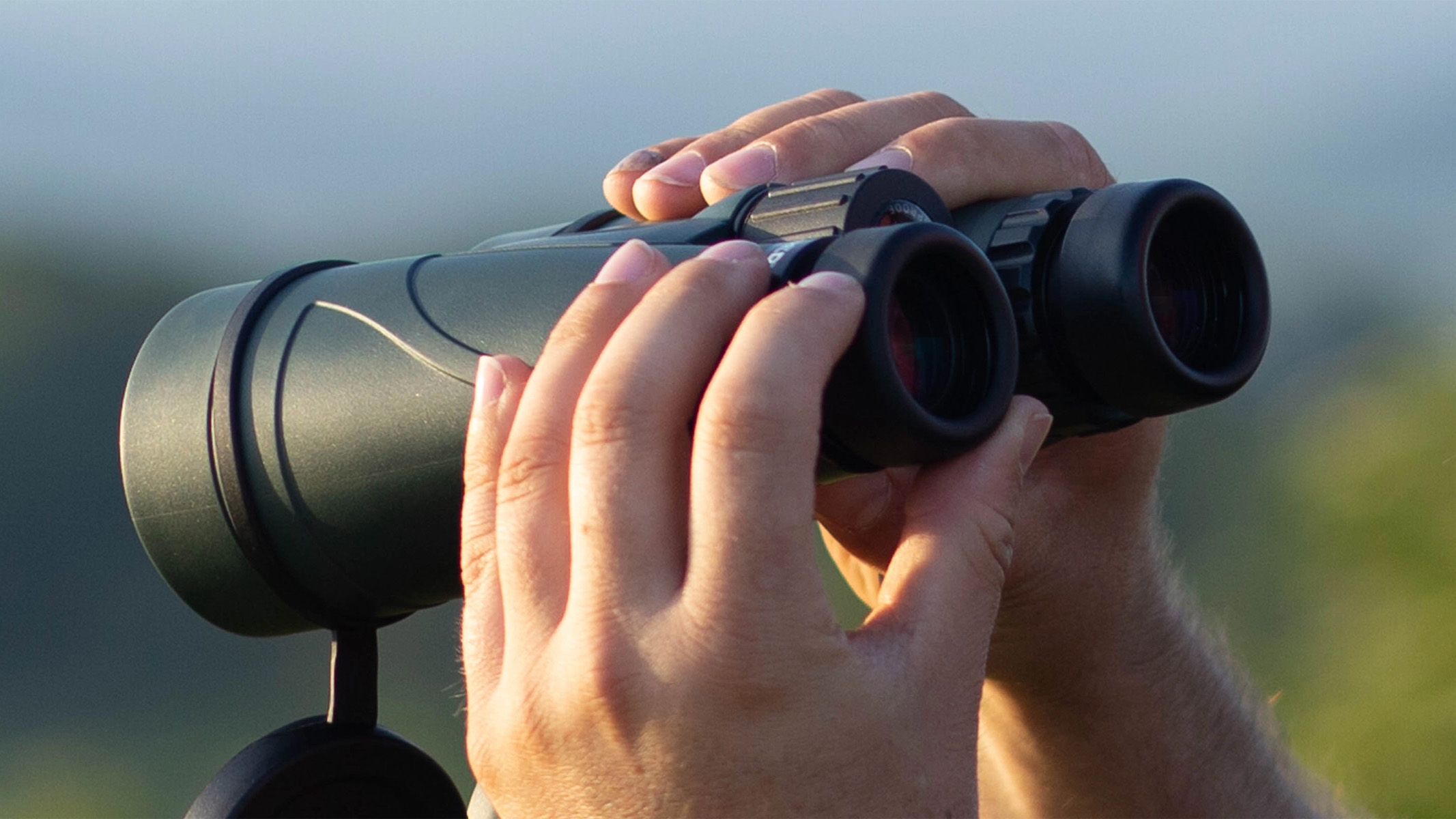
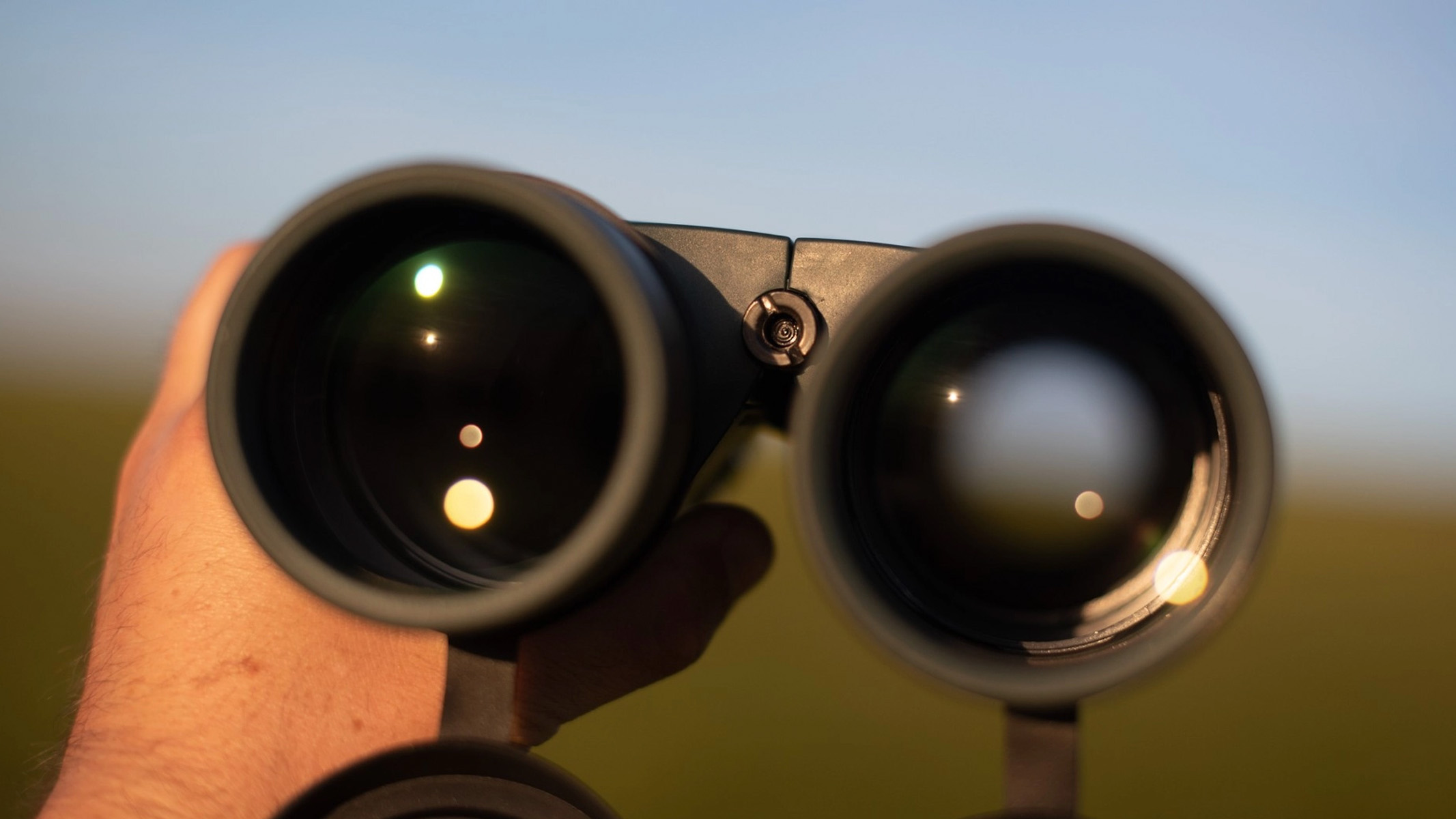
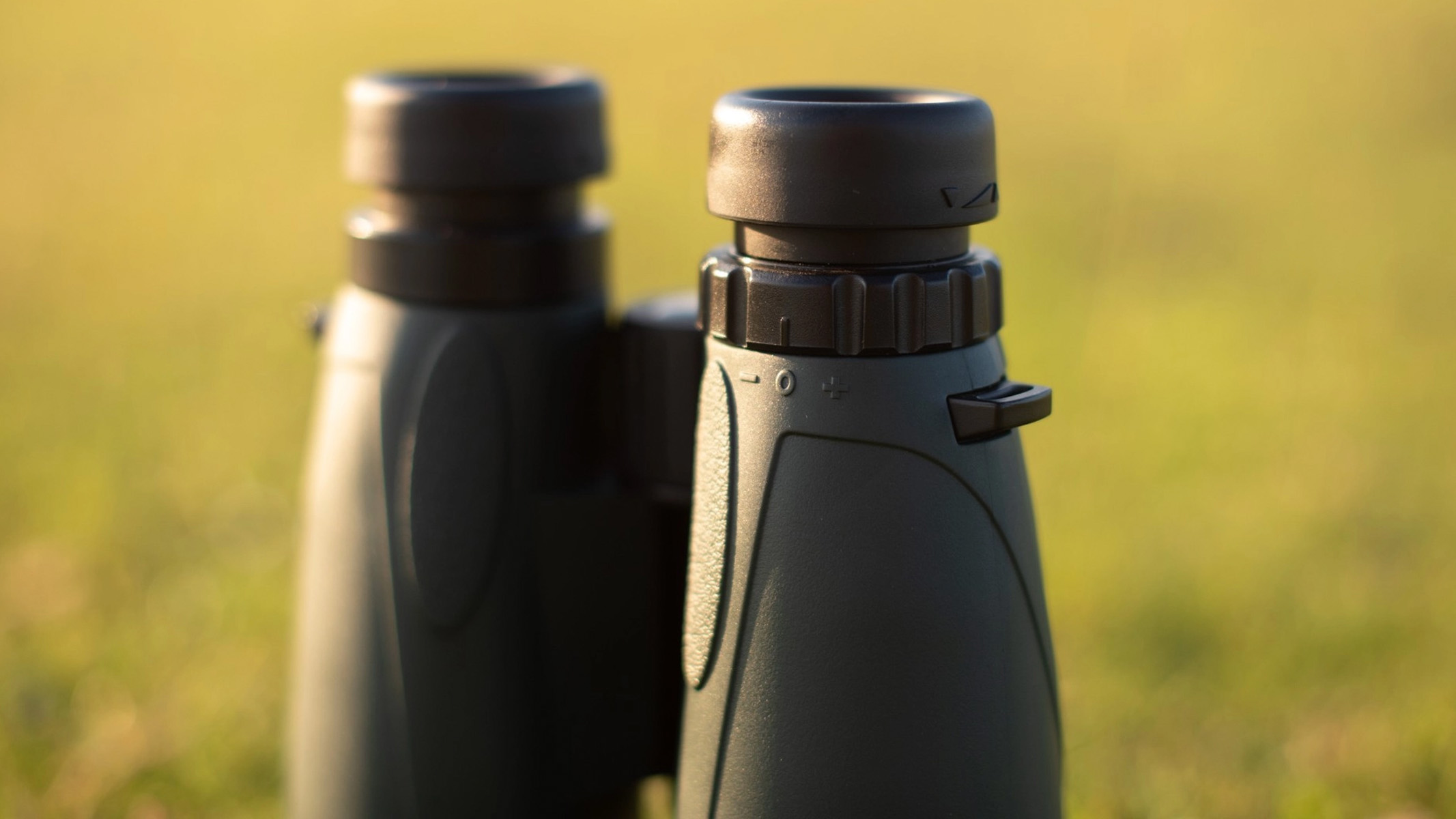
Specifications
Reasons to buy
Reasons to avoid
✅ You've outgrown your beginner binoculars: They're a great step up if you're ready to move on from the best beginner binoculars.
✅ You want to use them for various subjects: As the name suggests, they're also fantastic for viewing nature and wildlife.
❌ You want better optics: They're not as sharp as we'd like, and there's a slight bit of fringing. For a similar price, the Nikon Prostaff P7 10x42 are worth considering.
❌ You want amazing optics!: If you want the take a serious step up and drop some cash on a pair of binos, the Nikon Monarch HG 10x42 have the best optics, period.
🔎 Celestron Nature DX 12x56: Their focal length and light weight are perfect qualities for stargazing handheld or for casual birding and wildlife use. They’re not the sharpest, but its good build quality and unlosable lens caps make these binoculars one of our favorites. ★★★★½
Design: True to Celestron's Nature name, the Nature DX 12x56 come in an attractive green design featuring a non-slip grip, making them easy to use in wet conditions or while wearing gloves. We really like that the eyepiece covers are attached, too. One of our main gripes about other models is when the eyecups come off too easily and get lost, so we appreciate this seemingly small but useful feature.
For extended stargazing sessions, you can mount them on a tripod for steady views of the night sky. We don't think a tripod is a must, as they're light enough to hold steady for most users, but to fine-tune your compositions or share the views with others, it's a nice option to be able to mount them.
Performance: When we tested them during our Celestron Nature DX 12x56 review, we found their focal length and magnification to be perfect qualities for stargazing handheld or casual birding and wildlife uses. We thought that viewing the moon felt like looking up at a shining streetlight, and we noticed that there was less chromatic aberration for nighttime observations than during the day. Plus, the 12x magnification gives just that bit extra reach than a pair of 10x42s do.
Functionality: Phase coatings and BaK-4 glass give flare-free, sharp results, although we'd have liked them to be a little sharper. Still, we can't complain for the price. The 16mm eye relief is comfortable for users who wear glasses, provided the glasses don't sit too far away from the eye. We think you'll be hard-pressed to find a pair of binoculars that offer all the features that these do, especially at such a reasonable price point.
Say you've outgrown your beginner binoculars and want to drop some cash on a better pair but don't have the budget for some of the premium models — you're going to want a pair with good build quality, bright images and improved optics with some fancy glass and coatings. If this sounds like you, we think the Celestron Nature DX 12x56 are ideal.
- Read our full Celestron Nature DX 12x56 review
Attributes | Notes |
|---|---|
Design | Attractive green finish with comfortable grips. |
Performance | Very useable 12x magnification for stargazing and wildlife alike. |
Functionality | Can be mounted to a tripod for easier night sky viewing. |
Best binoculars for deep-sky viewing
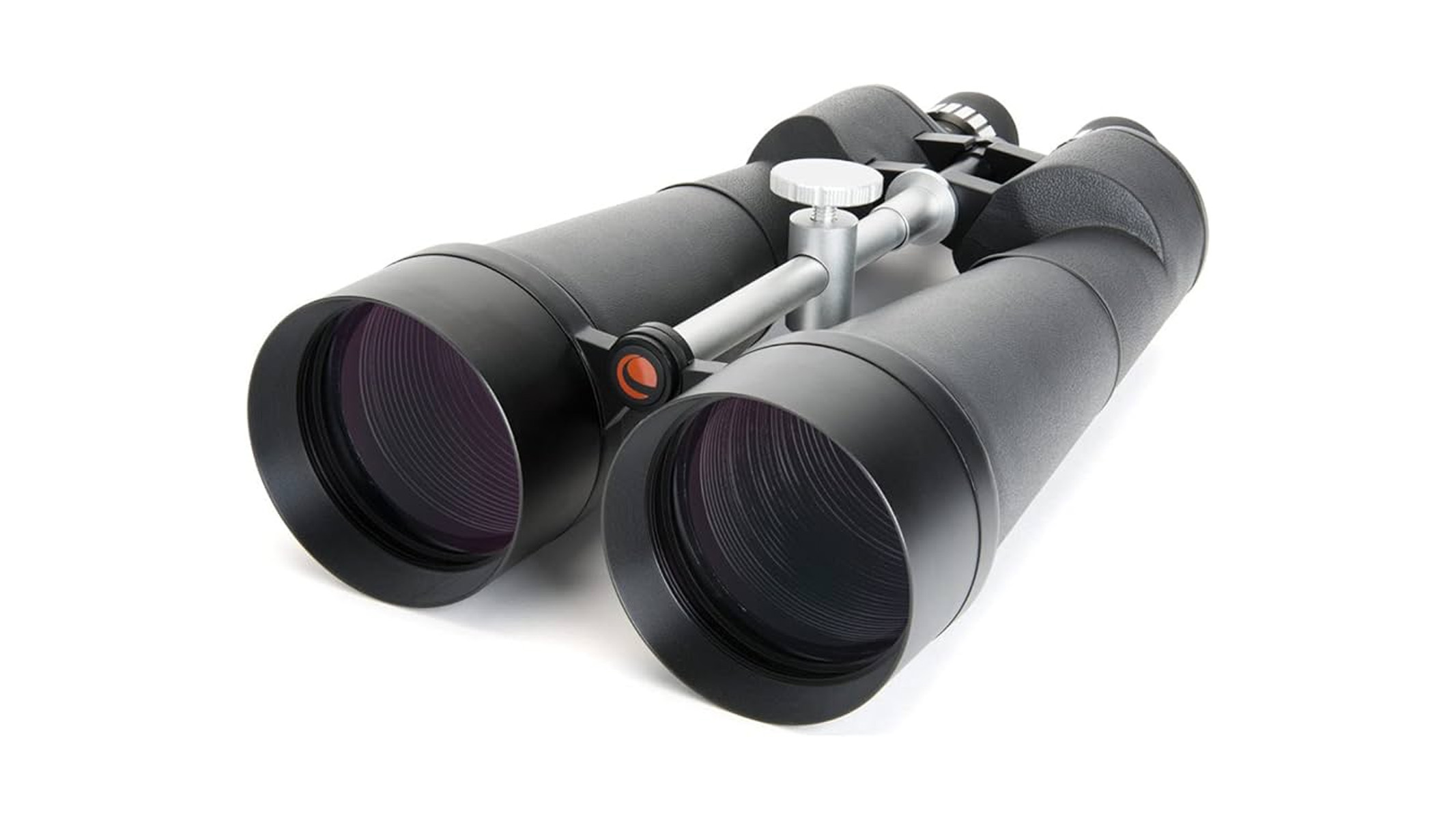
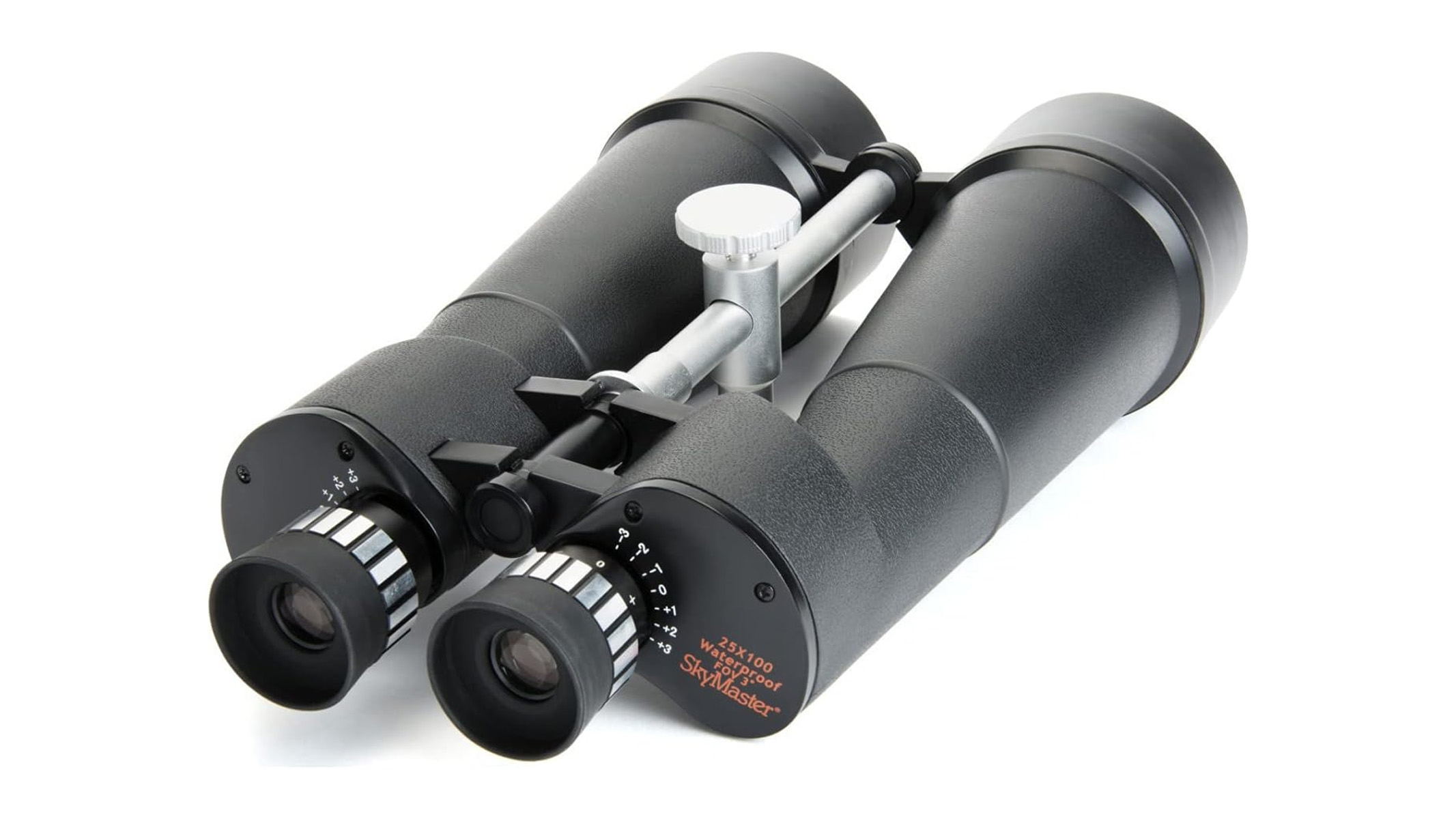
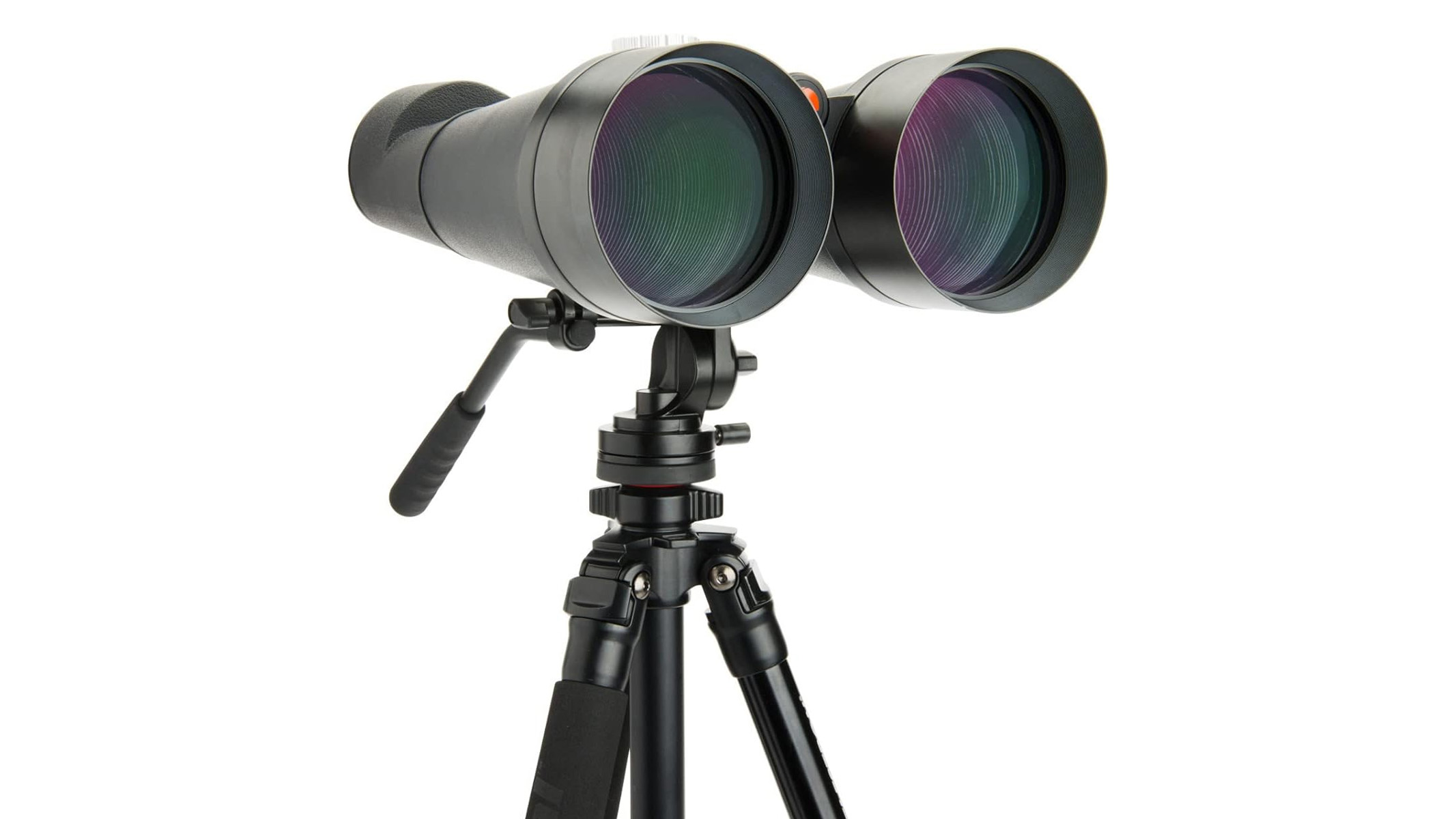
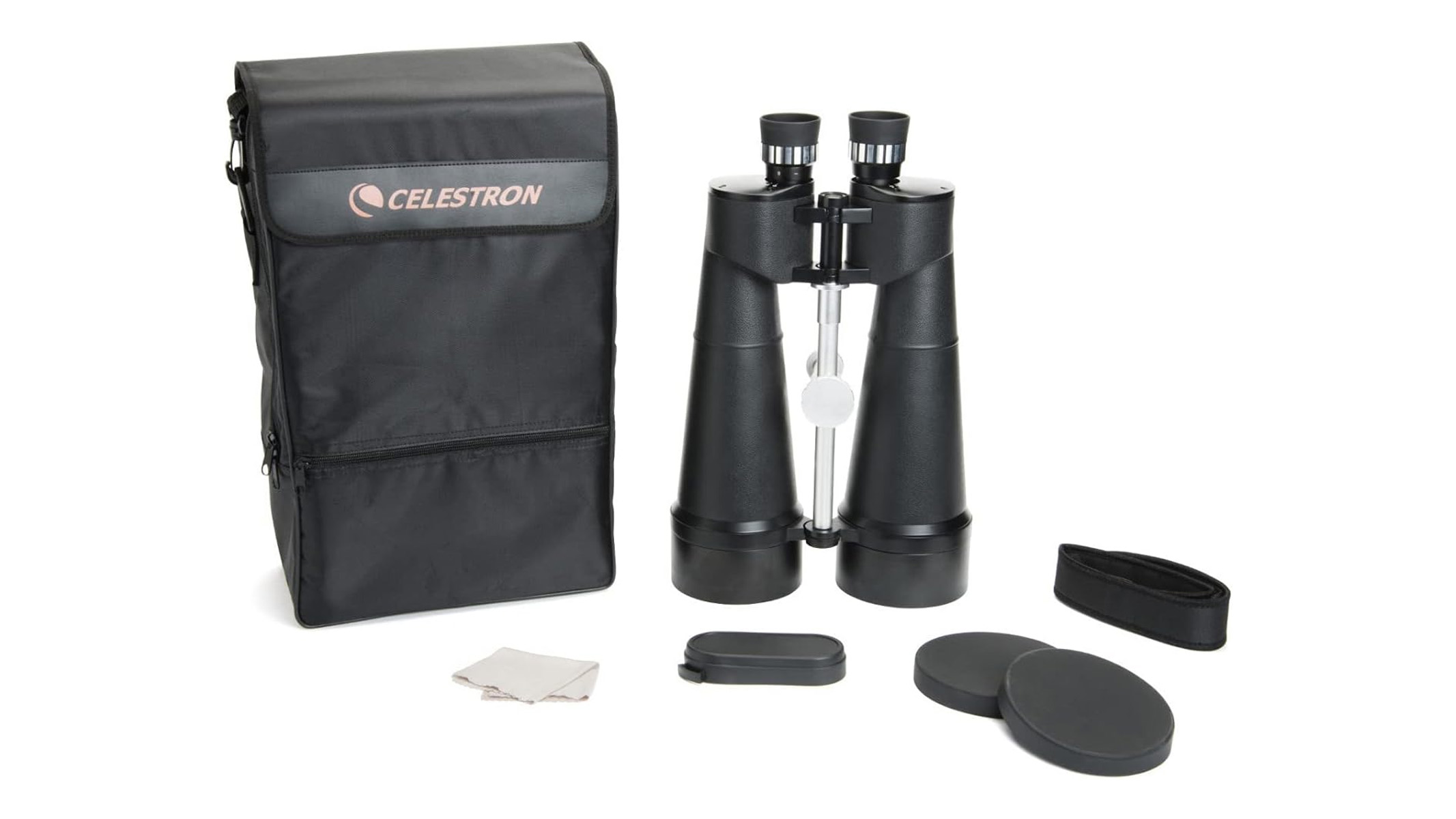
Celestron SkyMaster 25x100
Our expert review:
Specifications
Reasons to buy
Reasons to avoid
✅ You want powerful magnification: Their 25x magnification is the highest on this list, enabling us to spot Leo's triplets.
✅ You focus on astronomy: They are dedicated astronomy binoculars as opposed to all-round use.
❌ You want to use them handheld: Their 25x magnification and 8.75 lbs / 3.97kg weight means they need to be mounted on a tripod to get a steady view.
❌ You want wide views of the stars: The Nikon Prostaff P7 10x42 will be better for wide views.
🔎 Celestron SkyMaster 25x100: They're inarguably big and heavy, but powerful magnification requires a large binocular. The views are astounding and more akin to looking through two side-by-side 100mm telescopes. ★★★★
While we haven't published a full review yet here on LiveScience, we have tested them and reviewed the Celestron SkyMaster 25x100 over on our sister site.
Design: The one major design characteristic that makes them stand out from every other model on this list is their sheer size and weight — they're the biggest and heaviest in this guide by quite some margin. Measuring 10.1 x 5.1 x 15.28-inches / 256 x 130 x 388mm and weighing in at 8.75 lbs / 3.97kg, they are not for the faint of heart. Without question, you'll need to mount them on a tripod (and possibly add a counter-weighted arm) — not only due to their heavy weight but combine this with the powerful 25x magnification and you simply won't be able to physically hold them steady enough to get a decent view. Luckily, they have an attached tripod adapter.
We also noted that the rubber objective lens covers had a tendency to grow legs and dive off the tubes at the first opportunity — so make sure you take the extra effort not to lose them. The 15mm eye relief is good enough considering they'll be mounted on a tripod, although the 15mm is the shorted eye relief in this guide. If this is a dealbreaker, the Bushnell Match Pro ED 15x56 have a much more generous 18.5mm of eye relief — not the same 25x magnification, but they're still a great option for a bit of extra reach over the standard 10x or 12x.
Performance: The views you get when looking through these binoculars are astounding. The 25x magnification is great for picking out large star clusters — we enjoyed picking out Leo's triplets. However, to manage expectations, some of the best galaxies are just too far out to be able to spot even with big binoculars — you'll need one of the best telescopes for that.
We noticed they had the word 'waterproof' printed on them, however Celestron's online specs only state 'water-resistant', so we'd be wary of using them out in really wet weather. Besides, we can't imagine you'd be using dedicated astronomy binoculars on nights when there's cloud cover, so their questionable water-resistance level shouldn't be too much of an issue.
Functionality: We'd say using the Celestron SkyMaster 25x100s feels more like using two 100mm refractor telescopes with image-erecting prisms built-in, and separate non-removable eyepieces, each of which can rotate independently to provide razor-sharp focus.
Disappointingly, the packaging and accessories that come with it leave quite a lot to be desired. For the price and size, we'd expect some sort of solid, shock-resistant case, but you instead only get a thinly padded fabric cozy.
Still, for dedicated astronomers who want specialist binoculars to get up close and personal with the night sky, we think the Celestron 25x100s are the ones to beat in terms of magnification.
Attributes | Notes |
|---|---|
Design | Very big and heavy, they definitely need a tripod. |
Performance | 25x magnification is great for picking out large star clusters. |
Functionality | Feels like you're using two 100mm refractor telescopes. |
Best for kids
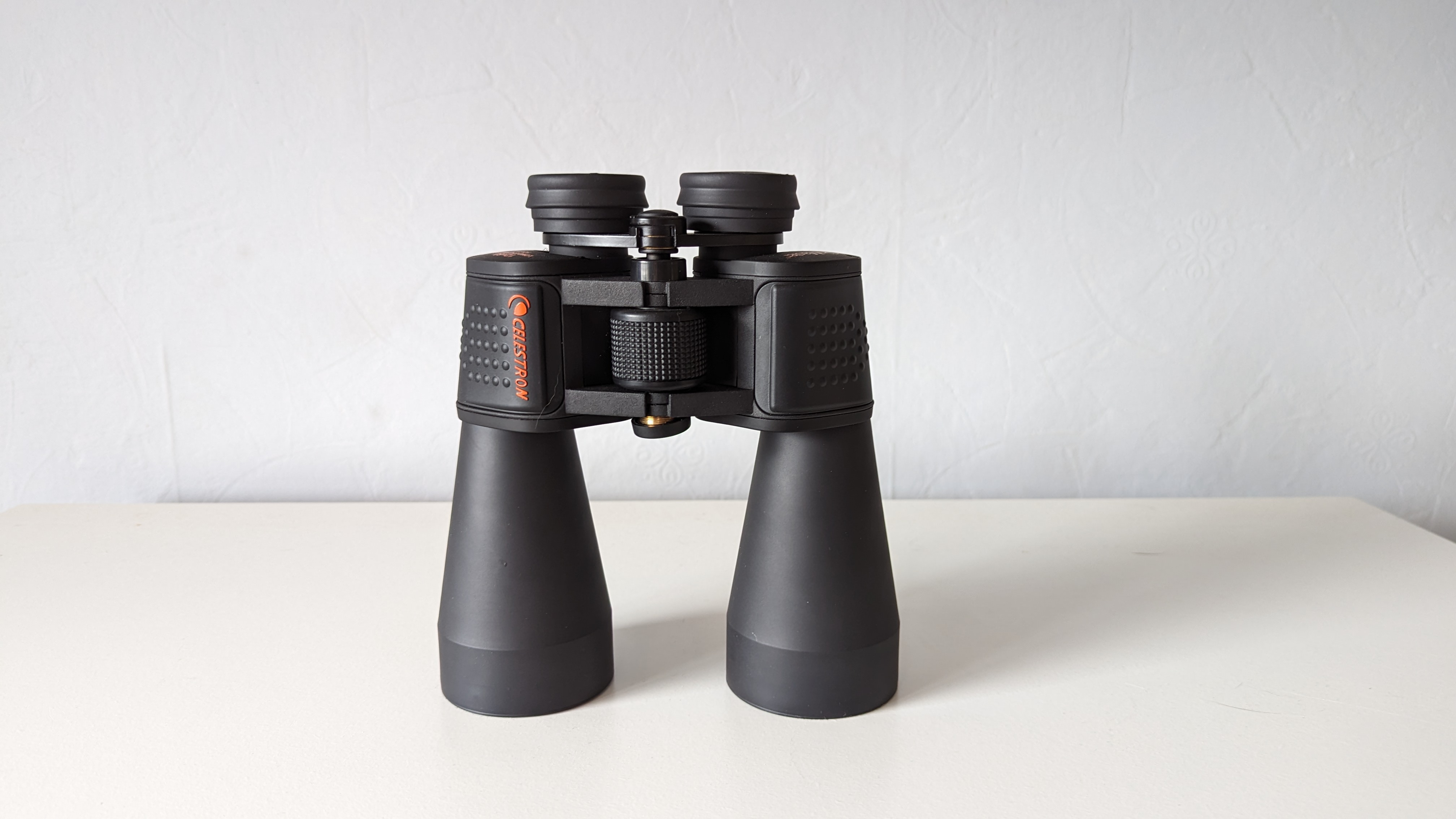
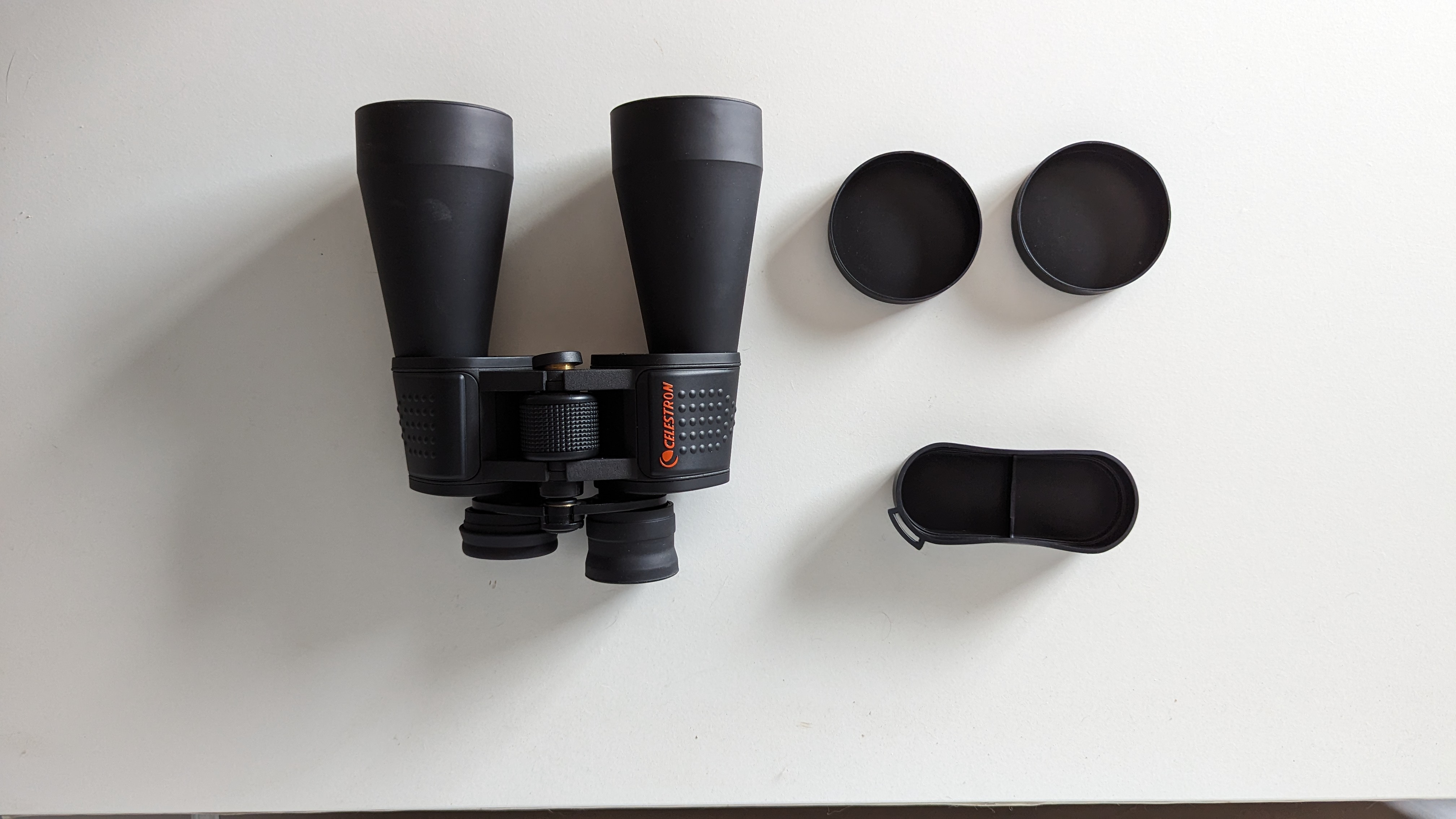
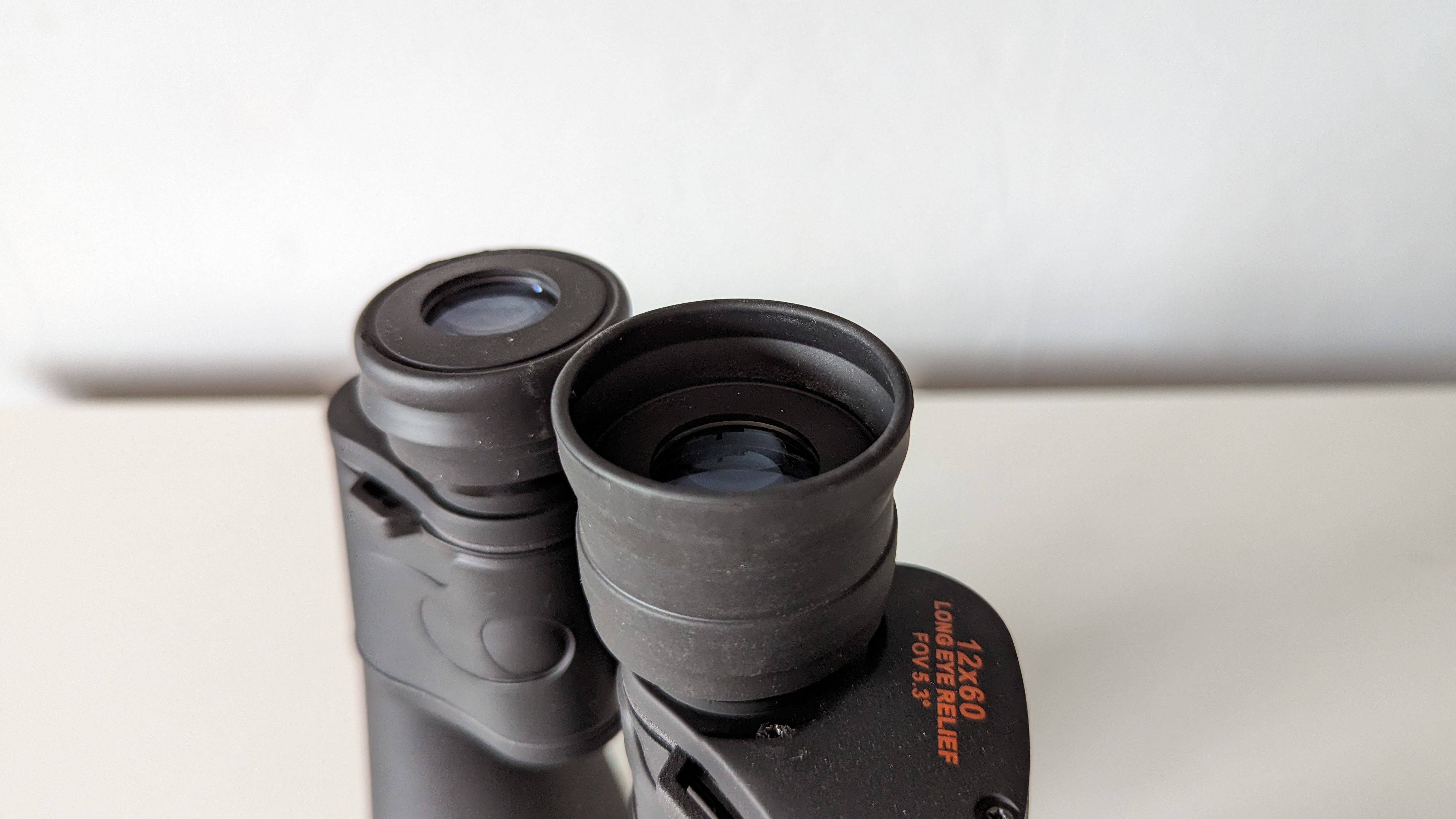
Specifications
Reasons to buy
Reasons to avoid
✅ You're buying their first pair: They're a fantastic starter pair of binoculars that don't break the bank.
✅ Your child wears glasses: Their 17mm eye relief makes them comfortable for users who wear glasses.
❌ You want something lightweight: They're a little heavy and cumbersome — the Nikon Prostaff P7 10x42 is better for portability.
❌ Your child is quite young: These are better suited for older kids and teens.
🔎 Celestron SkyMaster 12x60: Great astro specialists that can zoom in on distant subjects, budget-friendly and simple to use, it's hard to find anything to dislike about them. ★★★★
As expected from binoculars with 60mm objectives, they're quite physically large, made more obvious by their porro prism design, although that does mean extra clarity and optical prowess thanks to the BaK-4 prism and multi-coated lenses. Although they're not the biggest or heaviest model on this list, they are quite cumbersome and would be tricky for kids to hold for long periods of time — we'd recommend mounting them on a tripod to get the most out of their performance. Many of the best binoculars for kids are small and lightweight, but dedicated astronomy requires something with a bit more weight.
During our Celestron SkyMaster 12x60 review, we noticed they were perfectly capable of handling the odd bump thanks to their protective rubber armor, but we did find that the lens caps tended to fall off easily — which makes them easy to lose if you knock them without realizing.
For stargazing, we thought they performed pretty well, especially considering the price and overall specs. We were able to see three of Jupiter’s moons and get a closer look at Orion’s sword. They're not powerful enough to make out the individual parts that make up Orion’s sword, and we certainly couldn't see M42 well enough. Still, sharpness throughout the frame was good, and we could only make out a little coma and softness towards the edges. For the price, we really can't complain. If you want a bit more reach, consider spending a bit more and going for the 15x70 we mentioned above.
Overall, it's pretty hard to find anything to dislike about them. The hinge and focusing wheel are smooth and easy to operate, and the 17mm eye relief is great for anyone who wears glasses.
Attributes | Notes |
|---|---|
Design | Quite chunky and hard to travel with. |
Performance | Excellent nighttime views. |
Functionality | Flip down eyecups could be improved. |
- Read our full Celestron SkyMaster 12x60 review
Best stargazing binoculars: comparison
| Row 0 - Cell 0 | Magnification | Objective lens diameter | Angular field of view | Eye relief | Waterproof | Dimensions | Weight |
Celestron SkyMaster Pro 20x80 | 20x | 80mm | 3.2-degrees | 15.5mm | Yes | 13 x 9.4 x 3.9 inches / 330 x 239 x 99mm | 5 lbs / 2.27kg |
Nikon Monarch HG 10x42 | 10x | 42mm | 6.9 degrees | 17mm | Yes | 5.7 x 5.2-inches / 145 x 132mm | 1.5lbs / 680g |
Leica Noctivid 10x42 | 10x | 42mm | 6.4-degrees | 19mm | Yes | 4.88 x 6.06 x 2.68-inches / 124 x 154 x 68mm | 1.9 lbs / 862g |
Celestron SkyMaster 15x70 | 15x | 70mm | 4.4-degrees | 18mm | Yes | 8.7 x 4.3 x 11-inches / 220 x 110 x 280mm | 48 oz / 1.361kg |
Nikon Prostaff P7 10x42 | 10x | 42mm | 62.9-degrees | 15.7mm | Yes | 5.9 x 5.1-inches / 150 x 130mm | 21.2 oz / 601g |
Canon 10x42L IS WP | 10x | 42mm | 6.5-degrees | 16mm | Yes | 5.4 x 6.9 x 3.4-inches / 17.6 x 13.7 x 8.5cm | 2.2lbs / 1.1kg |
Celestron Nature DX 12x56 | 12x | 56mm | 5.5 degrees | 16mm | Yes | 6.5 x 5.75 x 2.56-inches / 165 x 146 x 65mm | 36.2 oz / 1028g |
Celestron SkyMaster 25x100 | 25x | 100mm | 3-degrees | 15mm | Water resistant | 10.1 x 5.1 x 15.28-inches / 256 x 130 x 388mm | 8.75 lbs / 3.97kg |
Celestron SkyMaster 12x60 | 12x | 60mm | 5.3-degrees | 17mm | Water resistant | 2.8 x 8.1 x 8.3-inches / 71 x 206 x 211mm | 2.5 lbs / 1.13kg |
Best stargazing binoculars: Frequently answered questions
What is the best binocular for stargazing overall?
We recommend the Celestron SkyMaster Pro 20x80 as the best binocular for stargazing overall due to its powerful magnification and large objective diameters that drink in the dim starlight.
For anyone just starting out, we think the Celestron SkyMaster 12x60 Binoculars are a fantastic option. They're an older model that still offers a good range of viewing and has generous magnification and light transmission for the price.
Do you need a tripod for binoculars?
It depends on the magnification. Getting a steady view is crucial, especially in astronomy. Binoculars with a magnification of up to 10x (12x at a push) will be fine for general handheld views of the stars, but they might still be a little shaky if you're trying to view planets. For real cosmic viewing, you'll want what's known as 'big bins' of 15x and above — or shell out for an image-stabilized pair.
In our opinion, we'd always rather size up and mount the binoculars on a tripod than compromise on viewing power in a handheld pair.
What is the best premium binocular?
If you have a little cash to spare we'd recommend the Canon 12x36 IS III because they are image stabilized, providing rock-steady views for handheld stargazing.
Which is better for astronomy, telescopes or binoculars?
Telescopes are obviously the instrument of choice when it comes to powerful magnification, optical fidelity and tracking of celestial objects thanks to sophisticated features like motorized or computerized mounts.
However, the versatility and flexibility of binoculars mean they have broader appeal, often cost less, and can be used in a variety of environments. As binoculars are much smaller and more compact than telescopes, binoculars are much more travel-friendly for spontaneous stargazing trips.
What type of binocular should I buy?
Typically, porro prism binoculars are best for astronomy because of the superior light transmission (depending on the model you purchase). However, roof prism binoculars benefit from being smaller and lighter so are better for those that are traveling or need something lightweight.
Can you see planets with binoculars?
Yes! Binoculars will give you a better view of planets you can see with the naked eye, plus you'll be able to spot more distant planets like Neptune and Uranus that you can't usually see. For the best views, we recommend mounting them on a tripod.
Can you see Jupiter's moons with binoculars?
Yes, depending on the magnification. You'll get a fantastic view of the Galilean moons with magnification of 15x and above — but make sure they're mounted on a tripod to get a steady view. We were only just able to make them out using a pair with 10x magnification, but they were much smaller and the view wasn't steady enough without a tripod.
Can you see Saturn's rings with binoculars?
Yes, but you'll need a high magnification of at least 20x-25x. Saturn's rings are best seen with one of the best telescopes.
Can you see Andromeda with binoculars?
Yes! In a dark location, you can even see it with the naked eye. Look for a fuzzy patch with averted vision close to Cassiopeia.
Can you see the Orion Nebula with binoculars?
Yes, we saw a stunning view of the Orion Nebula (M42) with a pair of 15x70 binoculars.
Latest updates
Recent updates
March 26, 2025: Added skywatching events for April and 'Also tested' section.
Also tested
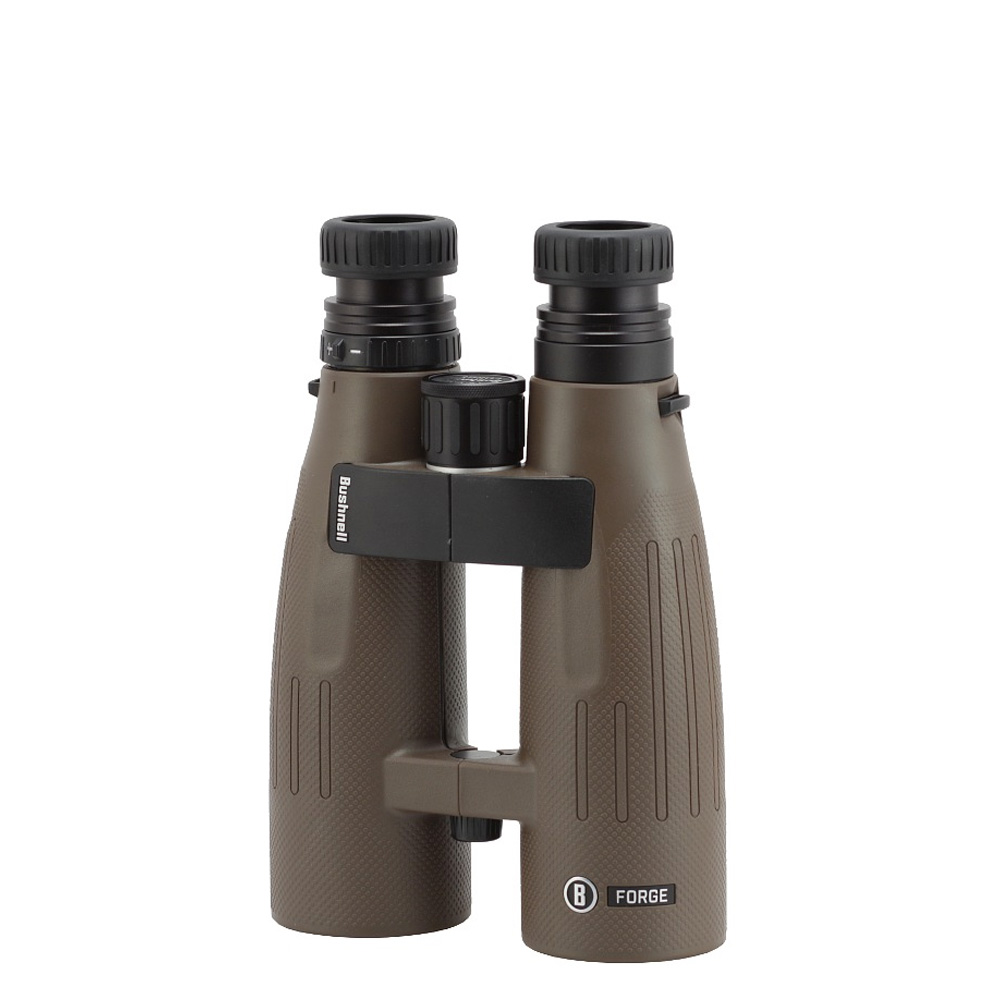
Robust and sturdy, the Bushnell Forge 15x56 provides great magnification for stargazing, but for the price, there are better options.
Read our full Bushnell Forge 15x56 review
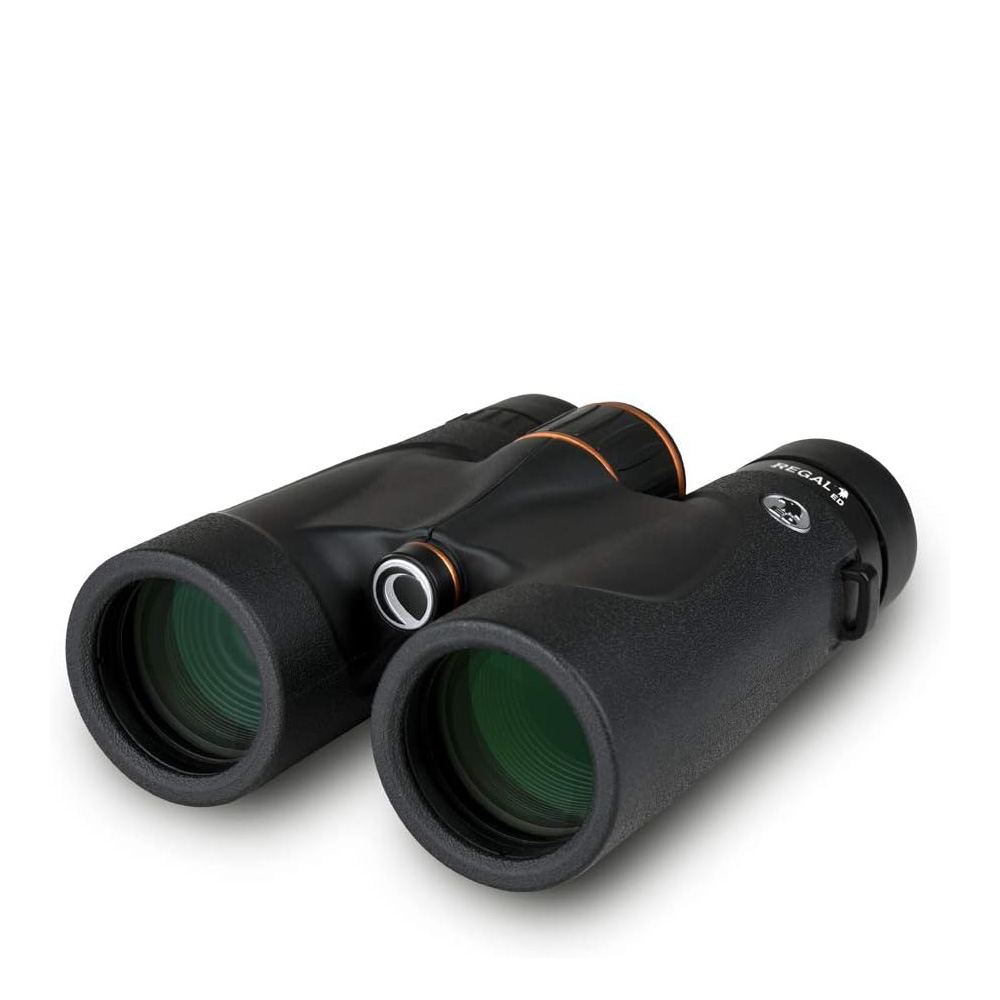
Impressive optics that we'd happily recommend for any generalist observer who wants handheld views of the stars.
Read our full Celestron Regal ED 10x42 review
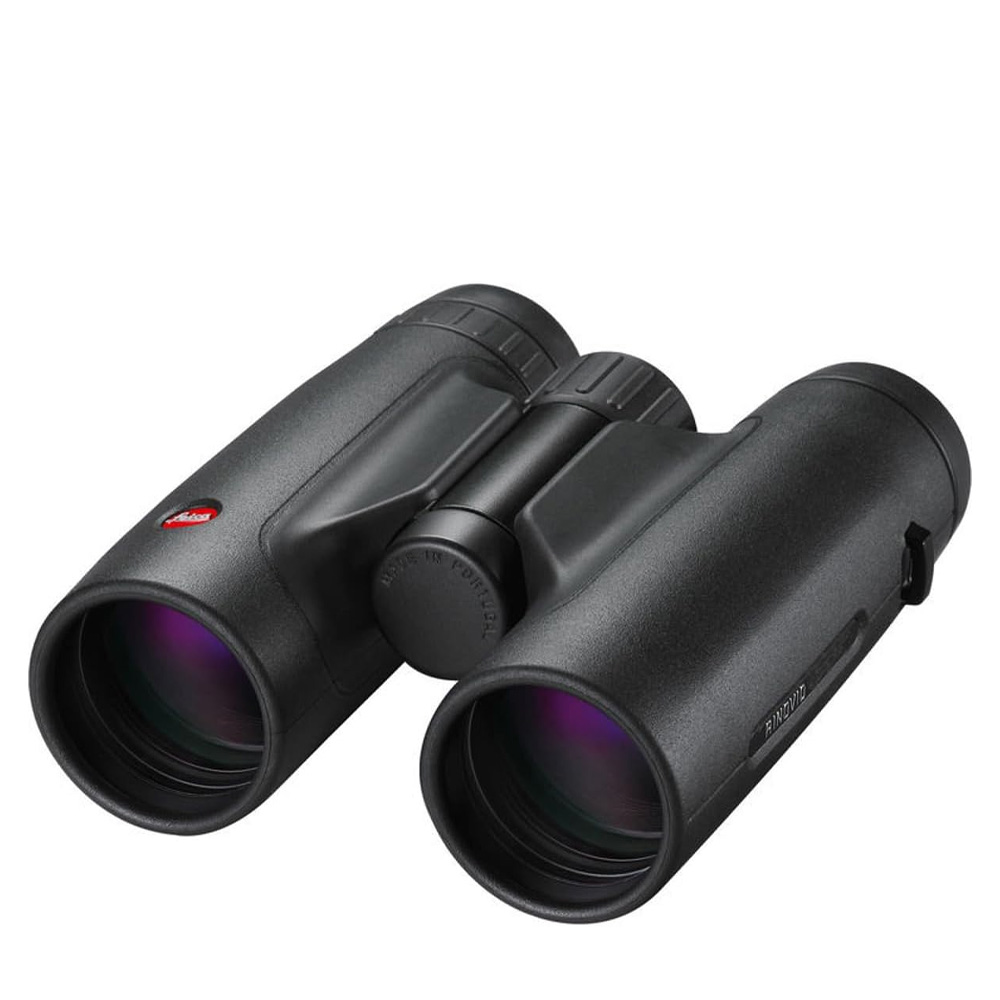
If you want to splurge on a premium pair for multiple uses, the Trinovid is a great alternative to the Noctivid.
Read our full Leica Trinovid 10x42 HD review
How we test the best binoculars for stargazing

When testing the best stargazing binoculars, our expert reviewers will point them skyward at as many celestial objects as possible to assess their real-world performance for a variety of subjects. We’ll evaluate their brightness, sharpness and clarity while viewing the moon, planets, star clusters and deep sky objects like nebulas and galaxies to get a full picture of how they perform. We look for optical defects like chromatic aberration and assess how sharp the image is across the entire frame, plus we assess the eye relief and how stiff/smooth the focus wheel and diopter are and evaluate the quality of any additional accessories.
We’ve tested them in a range of locations, from a Bortle 5 urban backyard to a Bortle 3 area in a National Park in South Wales. As stargazing binoculars are typically larger than most due to their higher magnification and larger objective lens diameter, we will always mount them on a tripod to observe the difference between handheld vs tripod-mounted views.
Sign up for the Live Science daily newsletter now
Get the world’s most fascinating discoveries delivered straight to your inbox.
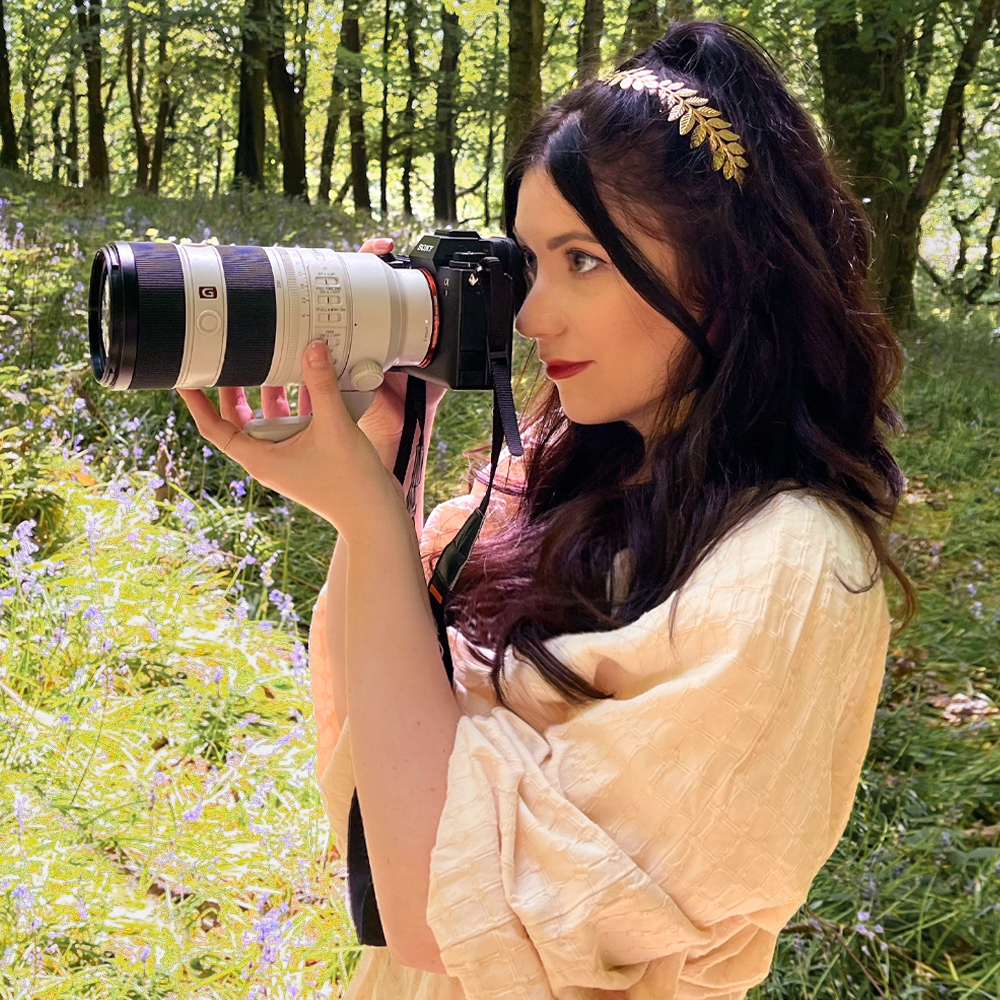
Kimberley Lane, E-commerce writer for Live Science, has tested a wide range of optics equipment reviewing cameras, lenses and tripods, and getting hands-on observations with binoculars and more. Also a landscape & seascape photographer living in South Wales, she aims to portray a feeling of calm and peaceful moments through her images. Her work has also been featured in a number of national photography magazines and she regularly contributes to our sister site Space.com.
- Jase Parnell-BrookesManaging Editor, e-commerce
- Julie Ann Howlett
- Gavin Stoker


